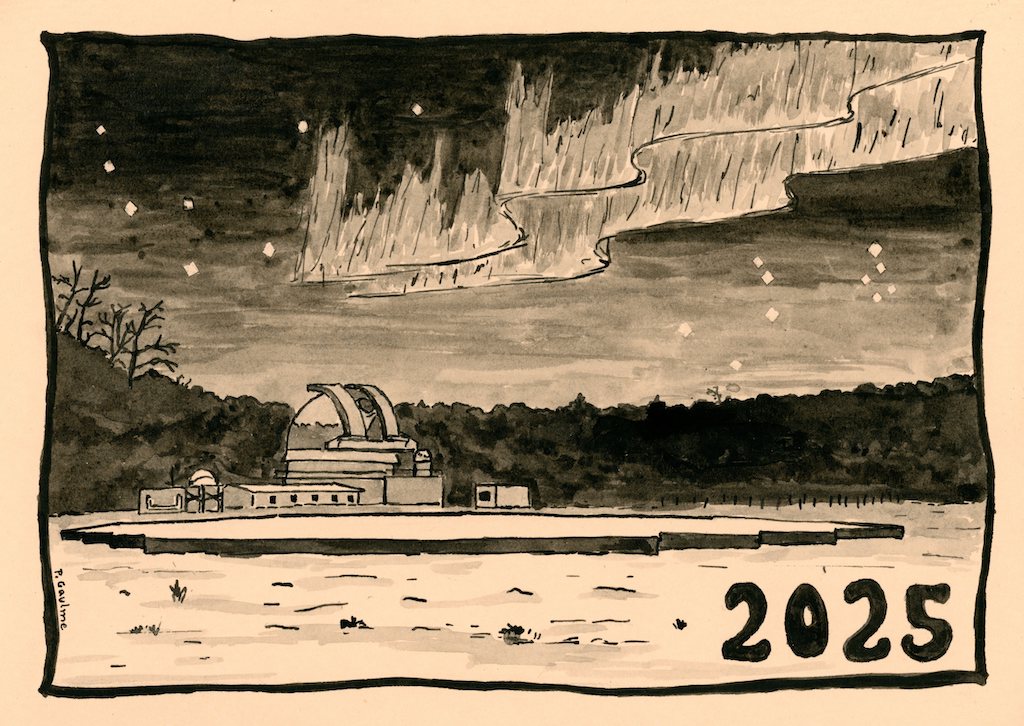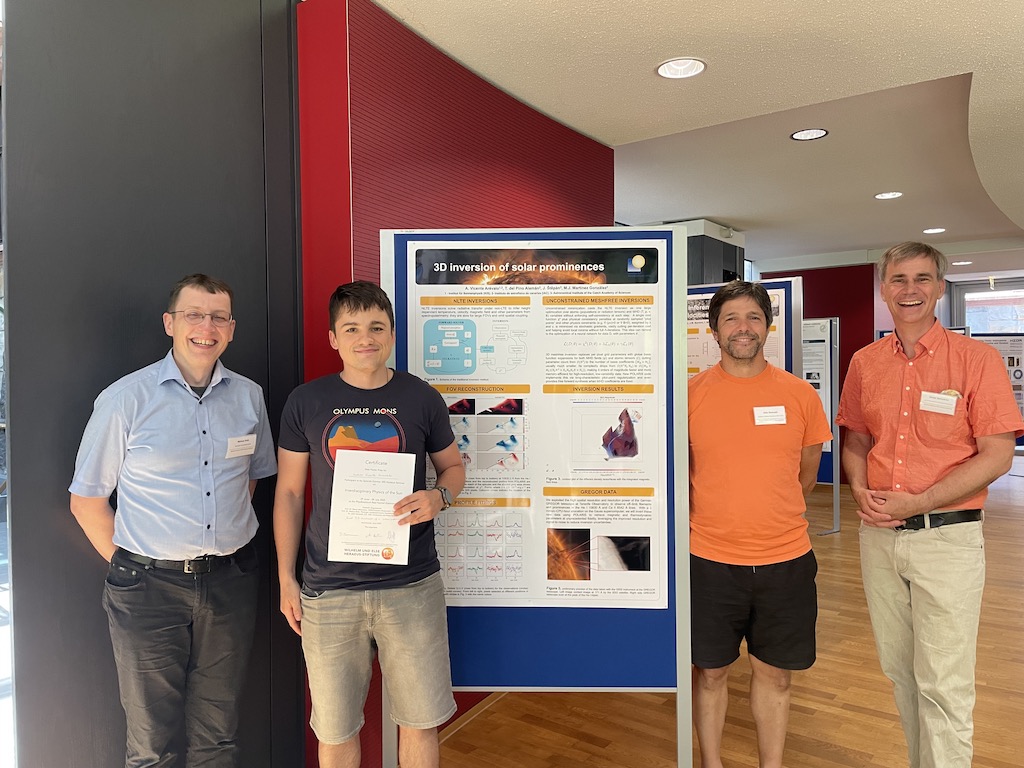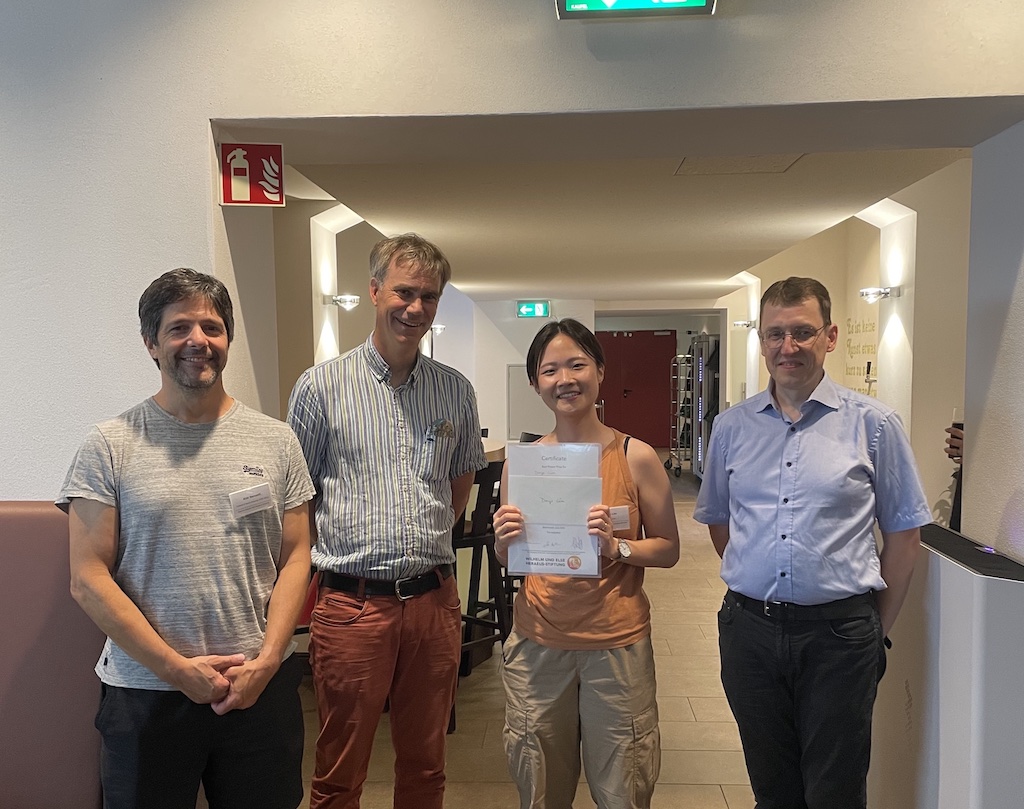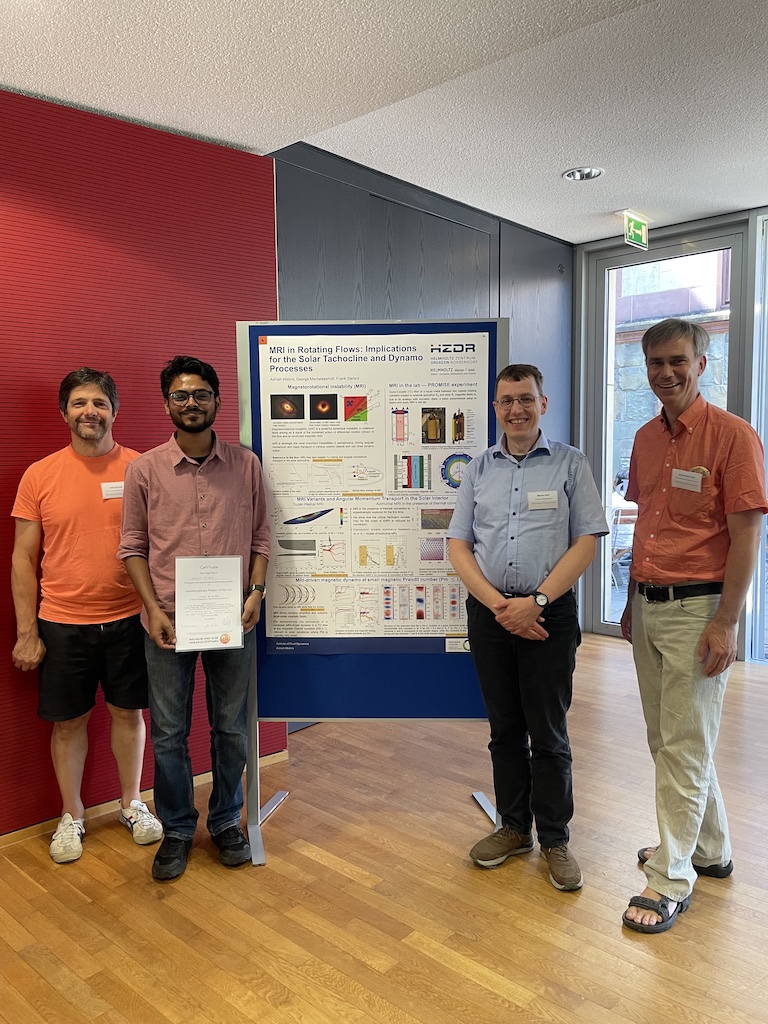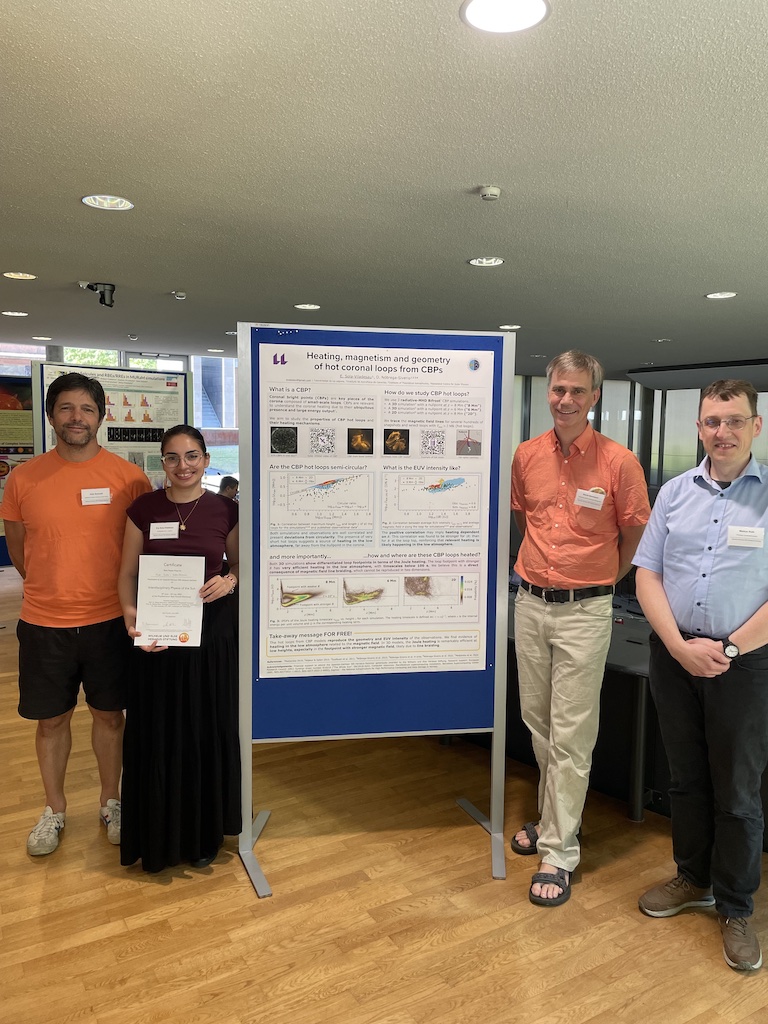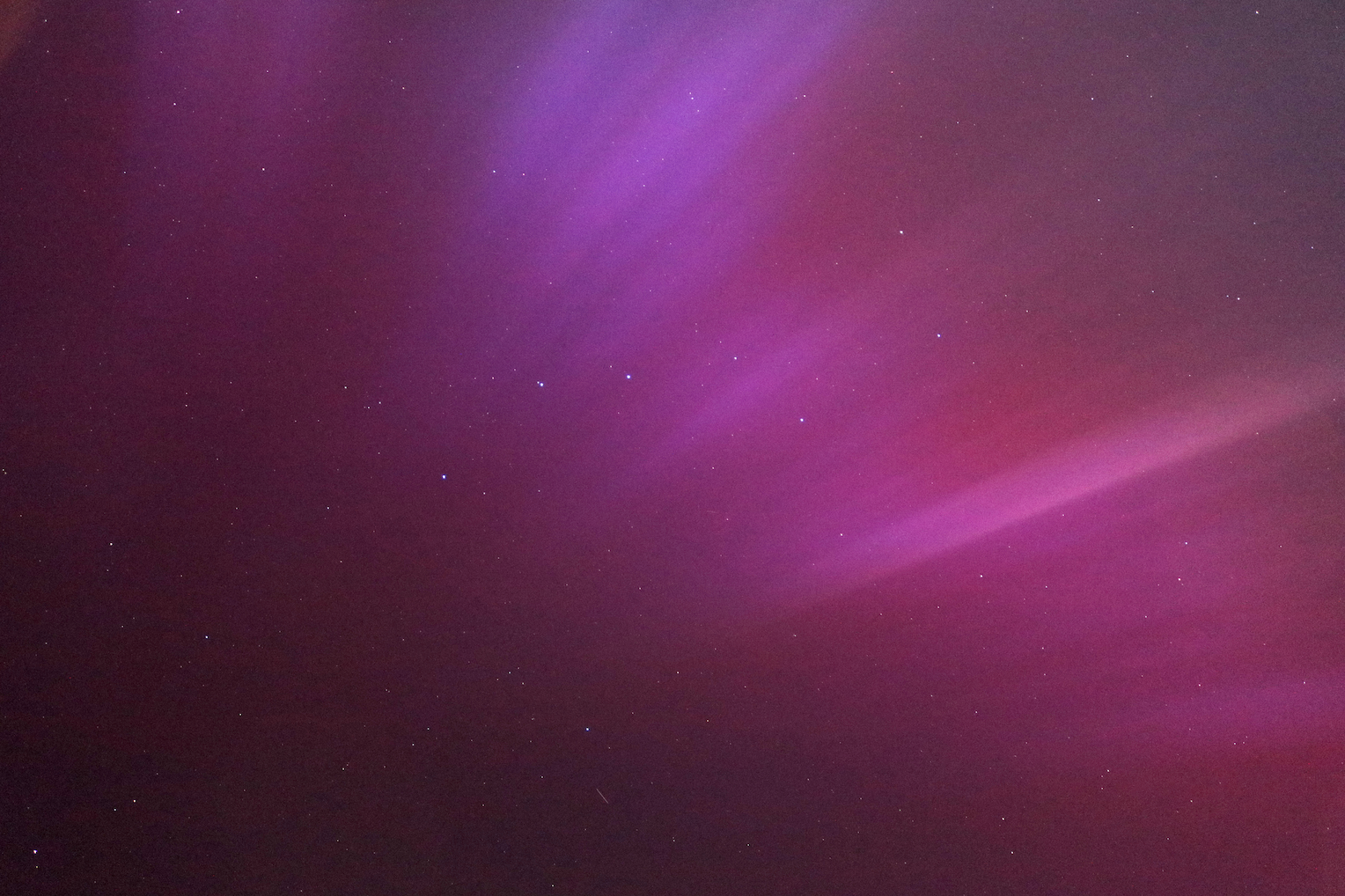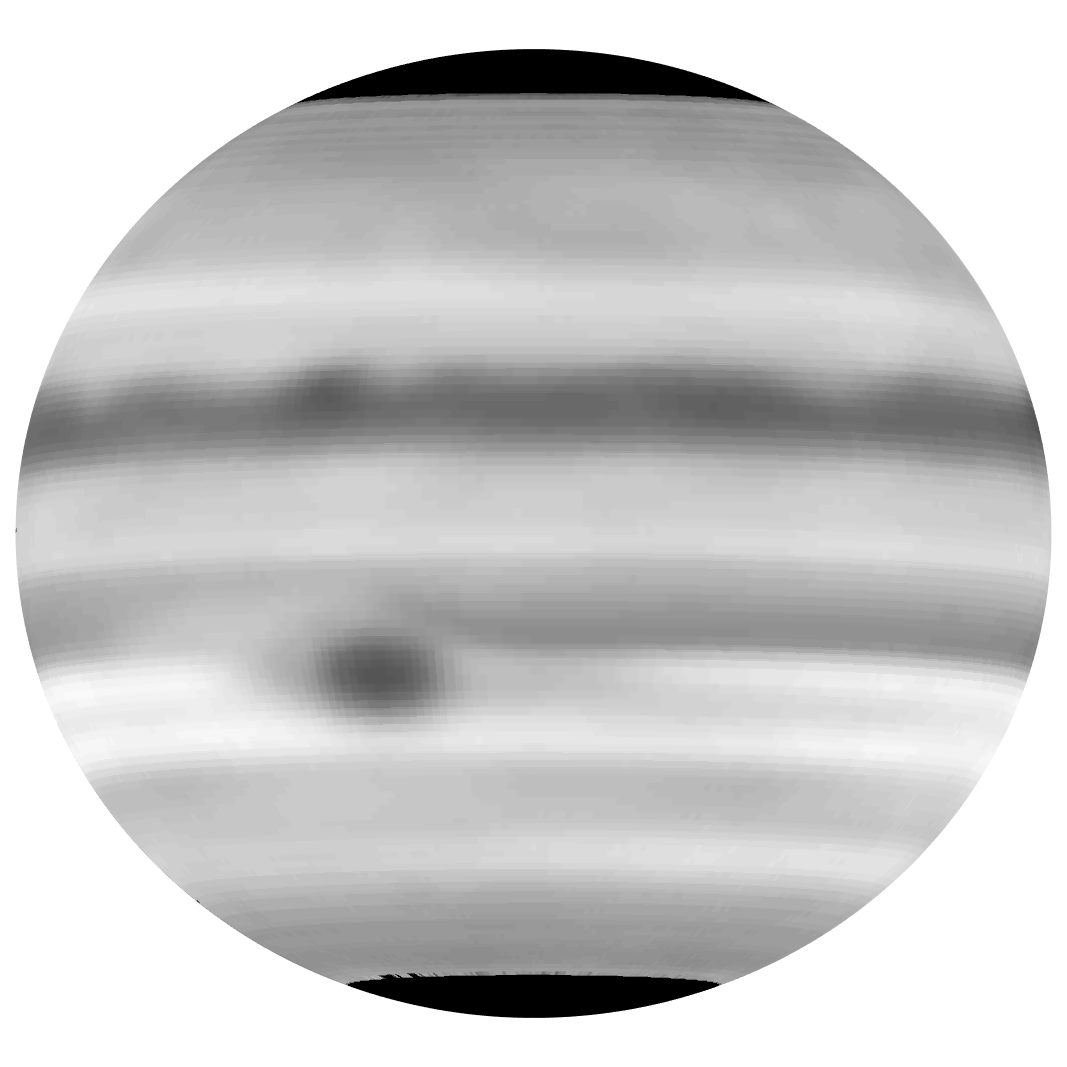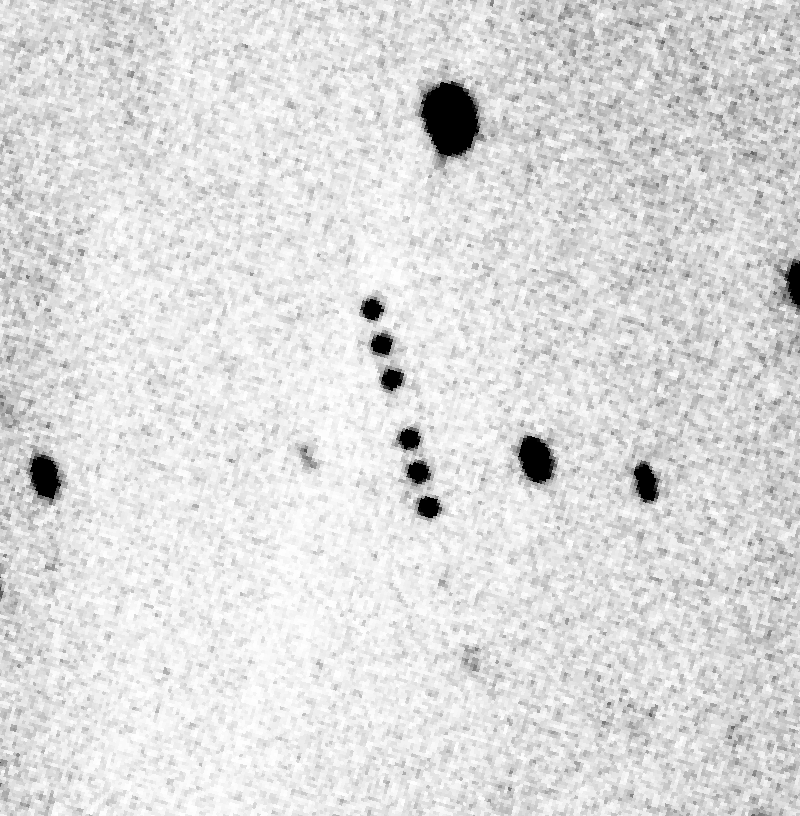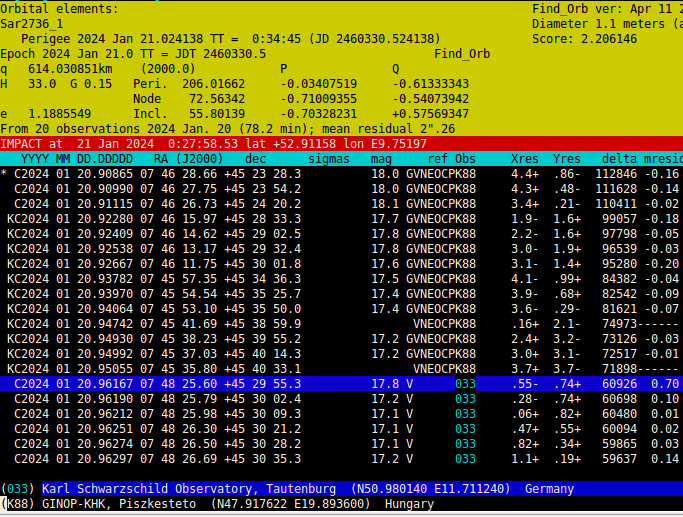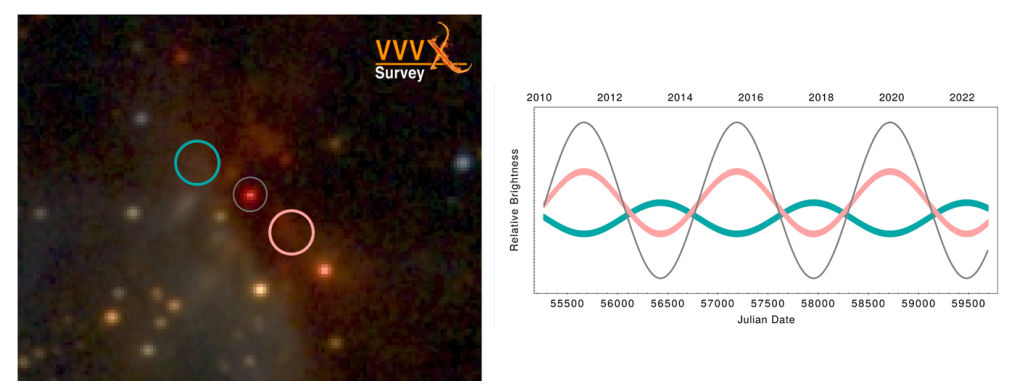A very fast and bright meteoroid over Tautenburg
12.12.2025
It is not an event that you see every day (or in this case: every night): The meteor camera at the Thuringian State Observatory recorded a very bright fireball during the night of November 18, 2025. The European Fireball Network, run by scientists at the Astronomical Institute of the Czech Academy of Sciences, analyzed recordings of this meteoroid. Here is what they found out about this spectacular celestial event that lasted only a few seconds.
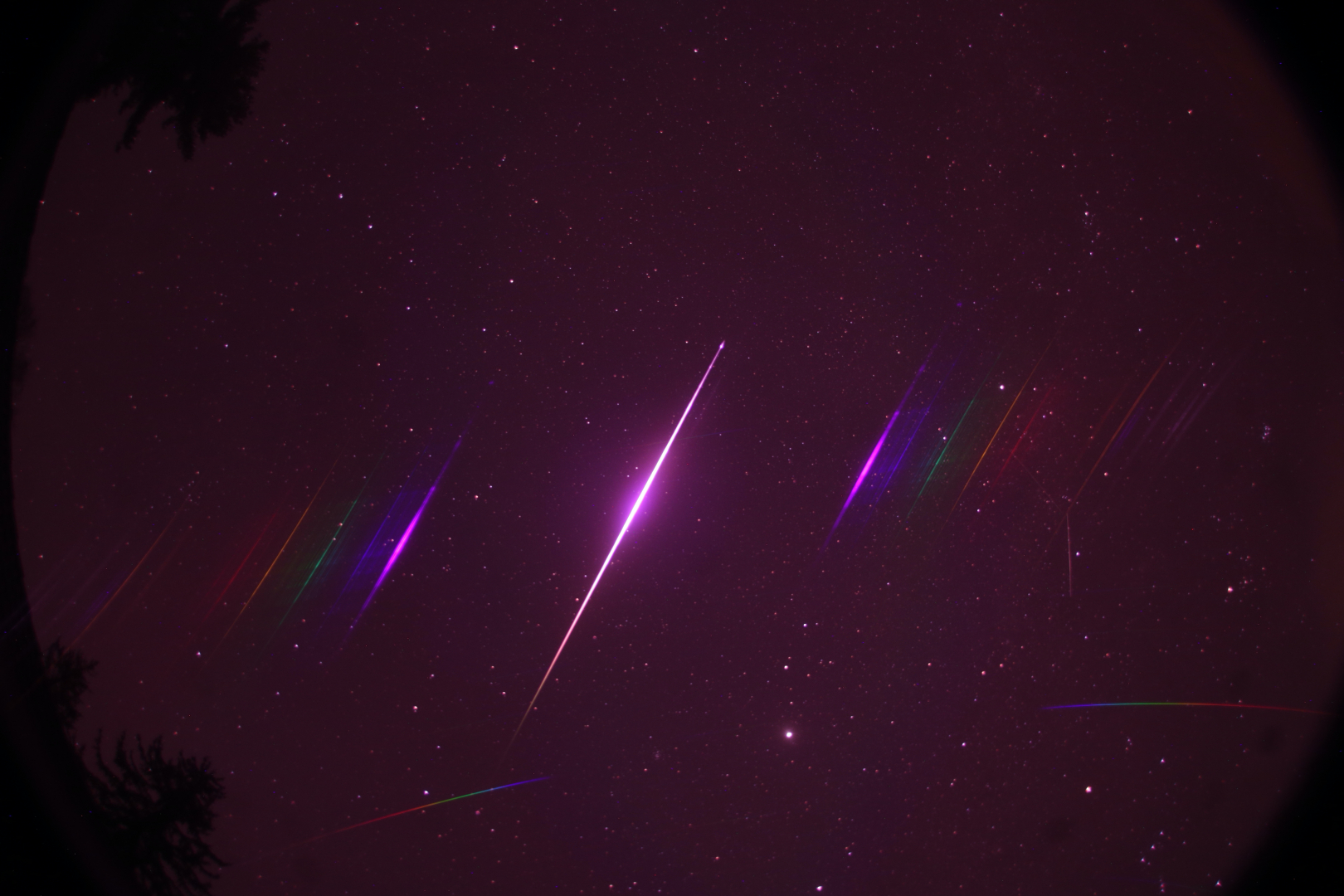 A fireball recorded by the meteor camerat at Tautenburg. Photo: Astronomical Institute of the Czech Academy of Sciences
A fireball recorded by the meteor camerat at Tautenburg. Photo: Astronomical Institute of the Czech Academy of Sciences
The fireball was visible for only two seconds, but that was long enough to leave a bright streak on the meteor camera at the Thuringian State Observatory. Asteroids and meteoroids enter the Earth's atmosphere all the time. When they burn up, they turn into shooting stars (meteors). If part of them makes it all the way to Earth, the piece of rock is called a meteorite. Sometimes meteors appear even brighter than the planet Venus – then they are called “fireballs”.
In order to study meteoroids more closely, the European Fireball Network, based at the Astronomical Institute of the Czech Academy of Sciences in Ondřejov, has distributed special meteor cameras across a large area of Central Europe. One of them is located at the Thuringian State Observatory.
The bolide (a technical term for the fireball) that briefly lit up the sky above Tautenburg on November 18, 2025, was observed by special cameras belonging to the European Fireball Network. Since almost all of the meteor cameras closest to the fireball's trajectory had clear skies (translating into a clear view), the recordings enabled a thorough analysis. The Czech astronomers were able to use the images to study its trajectory and other parameters.
The fireball flew practically directly over the Thuringian State Observatory. Using a wide-angle spectral camera, it was possible to capture an exceptionally bright and detailed spectrum of the fireball. Pavel Spurný, a researcher at the Astronomical Institute of the Czech Academy of Sciences, recently published this data:
Meteor camera recordings enable analysis
 Projection of the light path of fireball EN181125_040337 in the atmosphere onto the Earth's surface (yellow arrow). The actual light path was 141 km long and the object flew it in 2 seconds. (Graphic: Astronomical Institute of the Academy of Sciences of the Czech Republic, background map: Google Earth)At 4:03:37 UTC, a small meteoroid (designated EN181125_040337) weighing only 45 grams entered the Earth's atmosphere and began to glow brightly. The object was moving at a very high speed of 70 km/s in a northwesterly direction and quickly became brighter. At its maximum brightness, the bolide reached a luminosity comparable to that of the full moon. The light trail of the bolide in the atmosphere recorded by the cameras was 141 kilometers long. After only two seconds, the bolide burned up at an altitude of 69 kilometers northwest of the observatory in Tautenburg.
Projection of the light path of fireball EN181125_040337 in the atmosphere onto the Earth's surface (yellow arrow). The actual light path was 141 km long and the object flew it in 2 seconds. (Graphic: Astronomical Institute of the Academy of Sciences of the Czech Republic, background map: Google Earth)At 4:03:37 UTC, a small meteoroid (designated EN181125_040337) weighing only 45 grams entered the Earth's atmosphere and began to glow brightly. The object was moving at a very high speed of 70 km/s in a northwesterly direction and quickly became brighter. At its maximum brightness, the bolide reached a luminosity comparable to that of the full moon. The light trail of the bolide in the atmosphere recorded by the cameras was 141 kilometers long. After only two seconds, the bolide burned up at an altitude of 69 kilometers northwest of the observatory in Tautenburg.
Meteoroid burns up in Earth’s atmosphere
It was a body of cometary origin, which means that it is normally made of very fragile material. However, this celestial body had a slightly more solid structure than is usually the case with such cometary fireballs. Due to its small size and high speed, the original meteoroid completely disintegrated in the atmosphere and its entire original mass vaporized.
Before colliding with Earth, this meteoroid orbited the Sun on a very elongated elliptical orbit. This is typical for long-period comets. When close to the Sun, it passed between the orbits of Earth and Venus, and when far from the Sun, it passed far beyond the orbit of the last planet in our solar system, Neptune. Its orbit around the Sun took 250 years.
The Thuringian State Observatory and the Astronomical Institute of the Czech Academy of Sciences have a longstanding cooperation. They are both part of the PLATOSpec consortium.
New conference at Thuringian State Observatory puts spotlight on young scientists
02.12.2025
For the first time, young researchers at the Thuringian State Observatory held a one-day conference in Tautenburg. This new format gave Bachelor, Master and Ph.D. students a platform for presenting their work to the whole institute.
Academic research profits from exchanging ideas. Scientific ideas and results are presented in (written) papers and in talks. Therefore, giving talks is part of a researcher's work. However, it can be intimidating for early-career scientists to speak in front of a big audience. So why not create an opportunity for Bachelor, Master, and Ph.D. students to speak about their work and practice giving scientific talks?
That is the idea behind the Early Career Scientists’ (ECS) Conference held on November 6, 2025, at the Thuringian State Observatory. 14 young scientists seized the opportunity to cover a wide range of topics: extragalactic astronomy, stellar astrophysics, solar physics, galaxies, data analysis, remote sensing, and hardware programming.
A familiar setting for practicing
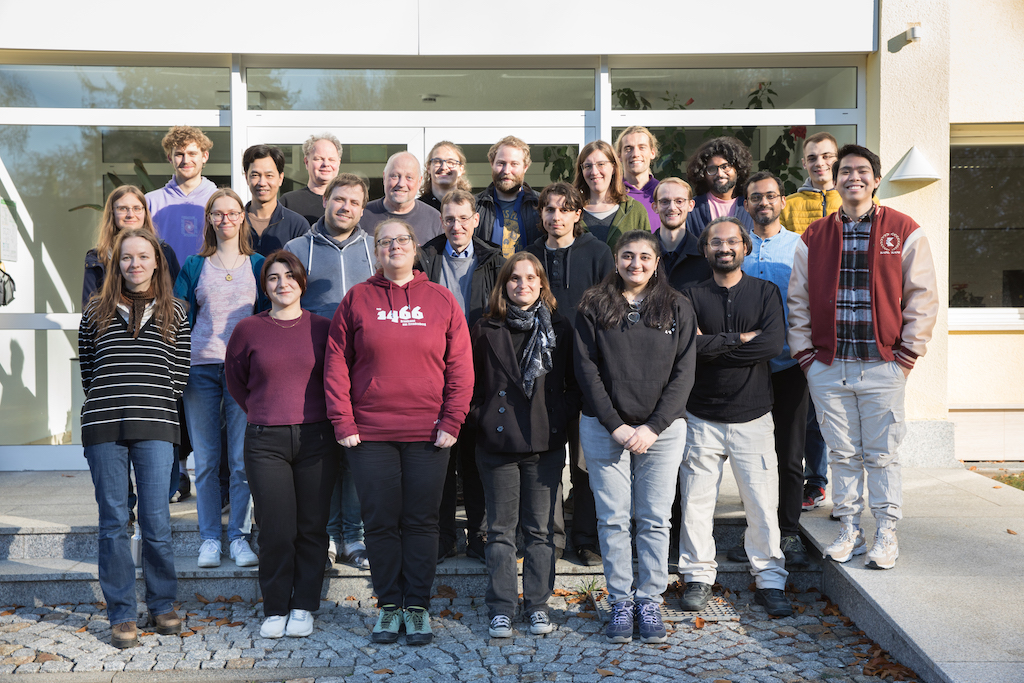 Early-career scientists at the Thuringian State Observatory. Photo: Thuringian State ObservatoryHemanth Pruthvi, one of the organizers of the Early Career Scientists’ Conference, explains the motivation for coordinating the event: “Most of the ECS members are at the beginning of their academic journey with little exposure to science communication. At some point, they will need to communicate their work to their peers, veterans and laypeople in a public setting. This conference is an attempt to ease them into the process by having them present their work in a familiar, albeit scientifically rigorous setting.”
Early-career scientists at the Thuringian State Observatory. Photo: Thuringian State ObservatoryHemanth Pruthvi, one of the organizers of the Early Career Scientists’ Conference, explains the motivation for coordinating the event: “Most of the ECS members are at the beginning of their academic journey with little exposure to science communication. At some point, they will need to communicate their work to their peers, veterans and laypeople in a public setting. This conference is an attempt to ease them into the process by having them present their work in a familiar, albeit scientifically rigorous setting.”
The young scientists could choose the content of their presentation: an ongoing project, past work, a future plan of action or even a literature survey. Every speaking slot was 15 minutes long, typical of any scientific conference: 10 minutes to present and 5 minutes for discussion. Participation was open to all staff members at the observatory. The audience could listen to the presentations and discussions in person or via zoom.
Apart from ECS members, the director, several of the institute faculty, and technical personnel attended the conference. Jana Köhler, also an organizer of the ECS conference, concludes: “The enthusiastic participation and the intriguing discussions showed that this conference was a success. There is also eager anticipation for the next conference, especially from the new members who couldn’t present this time.”
Big interest in the next ECS conference
The organizing team, comprised of Hemanth Pruthvi, Jana Köhler and Aashana Tripathi, plans to repeat the format. “Another ECS conference will be held when we have a substantial number of new members and/or new work to be presented”, says Aashana Tripathi.
Markus Roth, director of the Thuringian State Observatory, supports the initiative started by the young scientists: “I am very grateful that Hemanth Pruthvi, Jana Köhler and Aashana Tripathi organized this conference. This is a very innovative way to support our early-career scientists. I also thank all the speakers who gave presentations. The institute really profits from this format because it makes everyone here aware of how much is going on at the observatory. The conference is a good example of how to exchange ideas beyond everyone's own research group.”
Thuringian State Observatory supports research to protect Earth from Asteroids
20.10.2025
A research team led by Auriane Egal from Western University in Ontario, Canada, describes the details that could be determined about the explosion of asteroid 2023 CX1 in February 2023 in the journal Nature Astronomy. The Thuringian State Observatory is involved in this important publication.
On February 12, 2023, Krisztián Sárneczky discovered an asteroid at the Konkoly Observatory in Hungary. The asteroid, named "2023 CX1", had a diameter of just under one meter and an estimated mass of about 650 kilograms. Seven hours after it was first sighted, it exploded over Normandy in France. Now, an international team of researchers has published a comprehensive study on it.
 Landscape photographer Gijs de Reijke captured this spectacular image of fireball 2023 CX1 over northern France as the meteor broke up and vaporized. Photo: Gijs de Reijke2023 CX1 is one of the very rare cases of a cosmic object being discovered before it entered Earth's atmosphere. This made it possible to track its path from space until it impacted Earth. Using new and innovative observation strategies, the European Space Agency (ESA) and the US space agency NASA were able to predict the time and the location of the fall of 2023 CX1 with unprecedented accuracy. Dutch landscape photographer Gijs de Reijke managed to capture a spectacular image of the meteor shortly before it broke apart over Normandy.
Landscape photographer Gijs de Reijke captured this spectacular image of fireball 2023 CX1 over northern France as the meteor broke up and vaporized. Photo: Gijs de Reijke2023 CX1 is one of the very rare cases of a cosmic object being discovered before it entered Earth's atmosphere. This made it possible to track its path from space until it impacted Earth. Using new and innovative observation strategies, the European Space Agency (ESA) and the US space agency NASA were able to predict the time and the location of the fall of 2023 CX1 with unprecedented accuracy. Dutch landscape photographer Gijs de Reijke managed to capture a spectacular image of the meteor shortly before it broke apart over Normandy.
As many aspects as possible examined
More than 100 scientists, including meteorite physicists and amateur observers from Europe, America, Africa, and Australia, have joined forces to investigate all aspects of this extraordinary event: discovery with telescopes, tracking of the orbit, atmospheric observations using optical, infrasound, and seismic data, and geochemical laboratory analyses. Their findings are summarized in the article "Catastrophic disruption of asteroid 2023 CX1 and implications for planetary defense", published in September 2025 in Nature Astronomy. The Thuringian State Observatory is part of the author team.
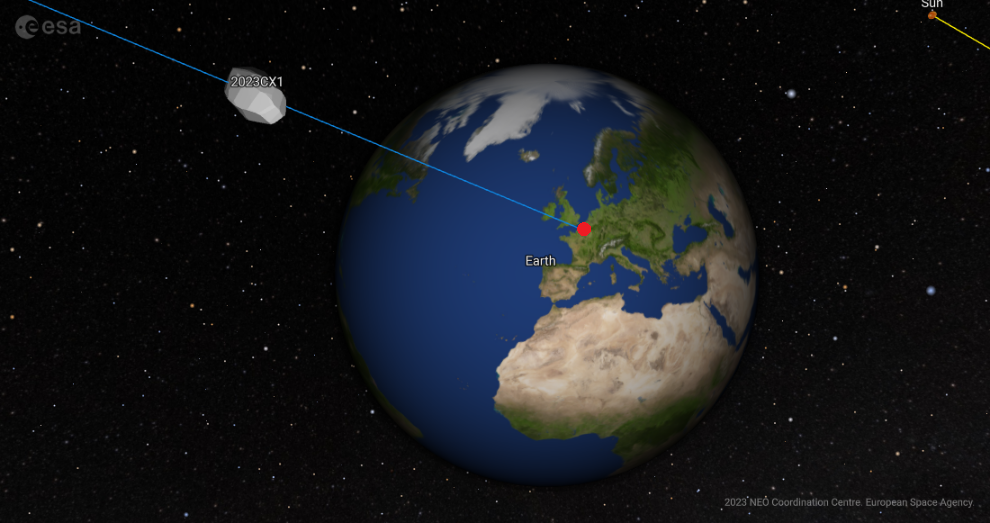 Trajectory of Asteroid 2023 CX1. Source: ESA NEO2023 CX 1 shattered around 28 kilometers above the Earth – and not just upon impact with the Earth's surface. It released 98 percent of its energy in a fraction of a second. The explosion scattered more than a hundred fragments over Normandy. Since the location and time were known, researchers set out to search for remnants of the asteroid. And indeed, they found what they were looking for. Small fragments of the meteorite were then examined in the laboratory.
Trajectory of Asteroid 2023 CX1. Source: ESA NEO2023 CX 1 shattered around 28 kilometers above the Earth – and not just upon impact with the Earth's surface. It released 98 percent of its energy in a fraction of a second. The explosion scattered more than a hundred fragments over Normandy. Since the location and time were known, researchers set out to search for remnants of the asteroid. And indeed, they found what they were looking for. Small fragments of the meteorite were then examined in the laboratory.
Explosion with great force
The asteroid exploded so quickly and with such force that its behavior highlights the potential danger of similar – and larger – astronomical objects. That is why the analysis of asteroid 2023 CX1 represents a unique opportunity for science, but also for protecting Earth from asteroids. Auriane Egal, professor at Western University in Ontario, Canada, and lead author of the article, says: "We have confirmed the existence of a new population of asteroids associated with L-type chondrites that are capable of breaking up abruptly in the atmosphere and releasing almost all of their energy at once. Such asteroids must be taken into account in strategies to protect Earth, as they pose an increased risk to populated areas."
Thuringian State Observatory operates a meteor camera
Since 2010, the Thuringian State Observatory has been participating in the classification and monitoring of near-Earth objects with its 2-meter Alfred Jensch telescope. It operates a meteor camera as part of a larger network of such observation instruments for asteroids and minor planets.
Continuous measurements of the celestial position of newly discovered and known near-Earth asteroids increase the accuracy of their orbits. This makes it easier to assess whether a new object is close to Earth or not, or whether the danger posed by a known asteroid has decreased or increased. With an average of 6,000 measurements per year, the TLS is now one of the most productive observatories in Europe in this field.
Links
News Release, Western University
ESA Near-Earth Objects Coordination Center
Asteroid 2024 BX1 observed at the TLS shortly before its impact near Berlin
Background Information: What is an airburst?
What happens to an asteroid when it enters the Earth's atmosphere at high speed depends on how big it is. The celestial body heats up so much due to friction that it vaporizes on the surface. Bodies smaller than a few centimeters vaporize completely. Bodies larger than 10 meters remain intact and strike the Earth.
In the size range in between, the following occurs: The surface of the celestial body reaches temperatures of 2000 to 3000 degrees Celsius, while the center remains at around -70 degrees Celsius. This creates thermal stresses that cause the asteroid to burst apart – just as glass shatters when it is suddenly heated to a high temperature. The resulting fragments give the atmosphere a larger surface area to attack, which intensifies the process. The technical term for this phenomenon is "airburst."
Science Minister Christian Tischner visits the Thuringian State Observatory
08.09.2025
Thuringia's Minister of Education, Science, and Culture, Christian Tischner, visited the Thuringian State Observatory. Professor Markus Roth, Director of the Thuringian State Observatory, presented an overview of the research conducted at the institute.
As a research institution not affiliated with a university, the observatory is under the authority of the Thuringian Ministry of Science. Minister Tischner used the visit to get to know the astronomical research institute better. Director Markus Roth welcomed him in the dome of the 2-meter Alfred Jensch telescope and introduced him to the various telescopes and instruments: in addition to the optical 2-meter telescope, these include the Low Frequency Array (LOFAR) radio telescope and the Tautenburg Solar Laboratory.
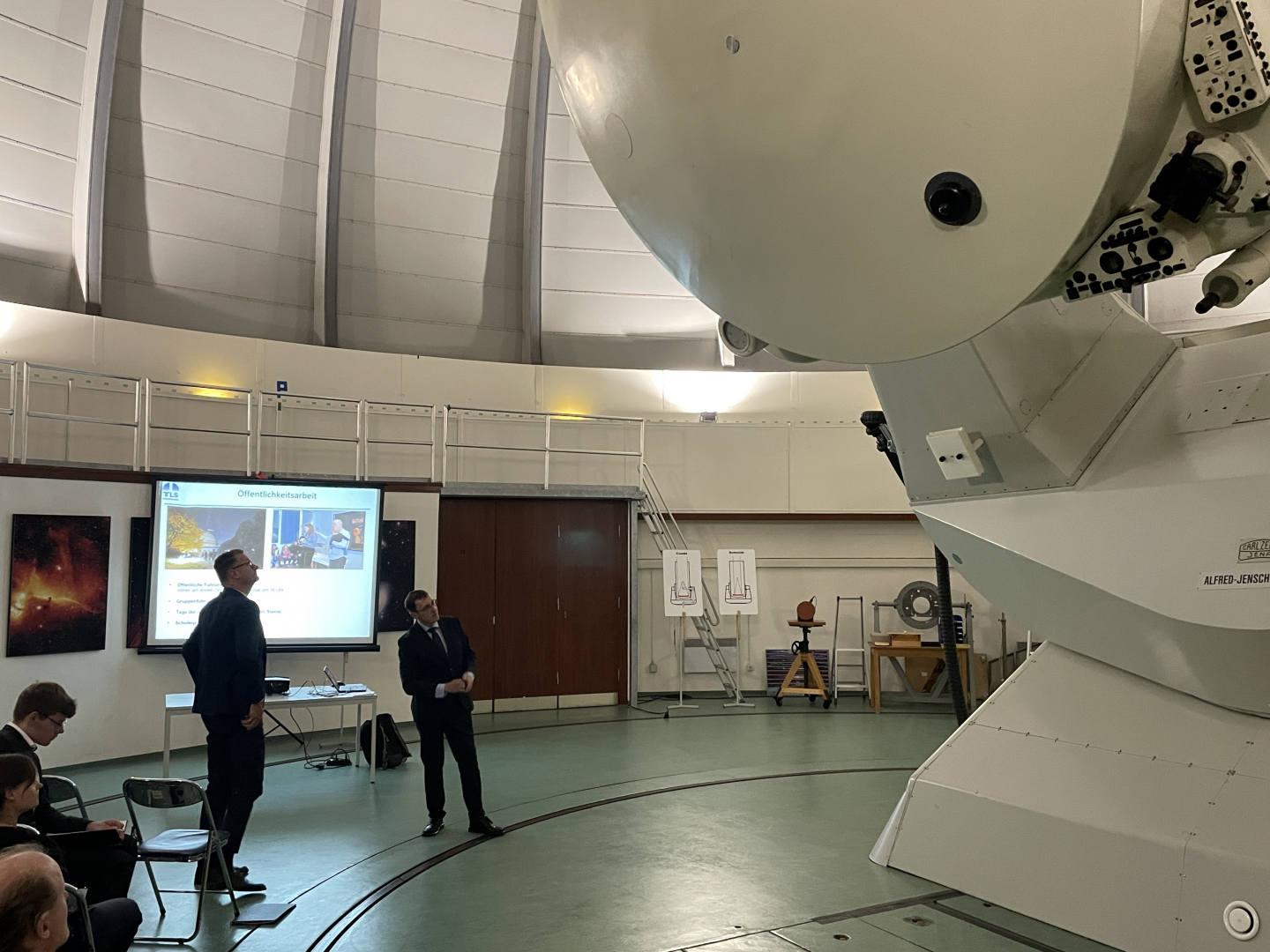 Thuringia's science minister Christian Tischner and TLS director Markus Roth in the dome of the 2-Meter Alfred Jensch telescope. Photo: TLSResearchers at the Thuringian State Observatory (TLS) are involved in numerous national and international projects. Roth gave an overview of the latest projects, such as PLATOSpec and SPRING. SPRING, which stands for Solar Physics Research Integrated Network Group, is a modern, global network of solar telescopes that will be used to continuously observe the sun in the future. PLATOSpec is a high-resolution spectrograph that supplements the sky observations of the European Space Agency's PLATO satellite mission with ground-based observations.
Thuringia's science minister Christian Tischner and TLS director Markus Roth in the dome of the 2-Meter Alfred Jensch telescope. Photo: TLSResearchers at the Thuringian State Observatory (TLS) are involved in numerous national and international projects. Roth gave an overview of the latest projects, such as PLATOSpec and SPRING. SPRING, which stands for Solar Physics Research Integrated Network Group, is a modern, global network of solar telescopes that will be used to continuously observe the sun in the future. PLATOSpec is a high-resolution spectrograph that supplements the sky observations of the European Space Agency's PLATO satellite mission with ground-based observations.
Extremely positive development of the research institute
Minister Tischner emphasized that, while preparing for the visit, he had seen how well positioned the research institute is and how well it has developed in recent years. He referred to the results of the evaluation of all state-funded non-university research institutes in the Free State of Thuringia by the Scientific Commission of Lower Saxony at the end of 2023. This evaluation, commissioned by the then Thuringian Ministry of Economics, Science, and Digital Society (TMWWDG), attests to the extremely positive development of the Thuringian State Observatory: “In the opinion of the expert commission, the Thuringian State Observatory is an efficient and internationally recognized research institution of systemic relevance for the entire astronomical community in Germany and beyond.” In his welcoming speech, Tischner commented: “What you have set in motion is worth continuing.”
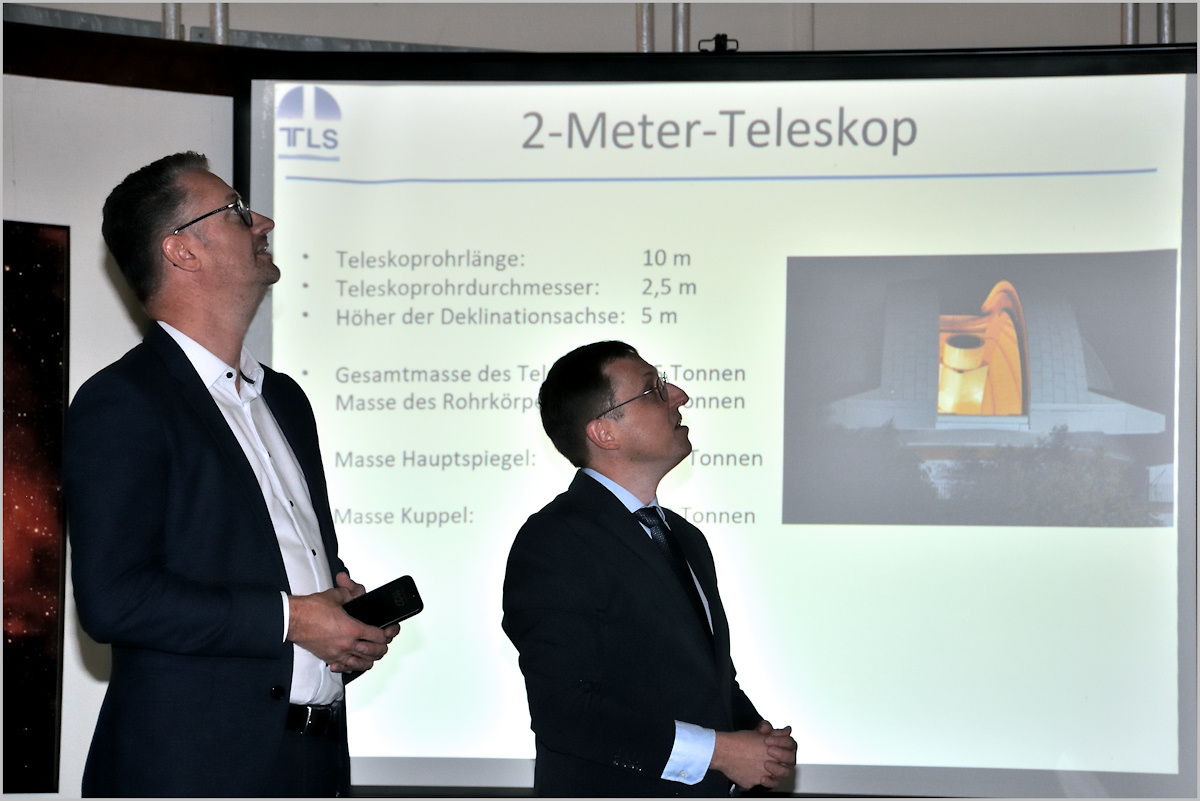 |
|
|
Minister Christian Tischner and Direktor Markus Roth observe how the 2-Meter telescope moves. Photos: Thüringer Landessternwarte |
(left to right) Andrea Schmidt, business manager at TLS, Matthias Hoeft, deputy director at TLS, Thurinigan science minister Christian Tischner, Markus Roth, director of TLS, Vera Hejduk, Thuringian Ministery for Education, Science, and Culture |
TLS and Fraunhofer IOF develop single-mode fiber coupling for telescopes with adaptive optics
04.08.2025
The Thuringian State Observatory in Tautenburg and the Fraunhofer Institute for Applied Optics and Precision Engineering IOF in Jena are jointly developing a key technology that can be used for astronomical measurements of stars and in modern devices for transmitting encrypted data. The FREEFIB research group is focusing on the development of compact adaptive optics for the efficient feeding of light into a single-mode fiber optic cable.
Anyone who has looked up at the starry sky on a clear night is familiar with the phenomenon: the stars twinkle. This twinkling is not caused by the stars themselves, but by air turbulence in the Earth's atmosphere. Layers of air with different temperatures are mixed together, creating turbulence.
This effect, known in astronomy as “seeing,” reduces the resolving power of telescopes — even at the best locations for astronomical observations. As a result, stars, which are actually perfect point sources of light, are imaged by telescopes as blurred spots.
This, in turn, means that instruments for spectroscopic analysis of starlight must be built correspondingly larger (and thus also more expensive) – or a large portion of the light captured by the telescope is lost. If it were possible to avoid the negative effect of “seeing,” spectrographs for detailed studies of stars could be built much more compactly.
Correcting light distortion with adaptive optics
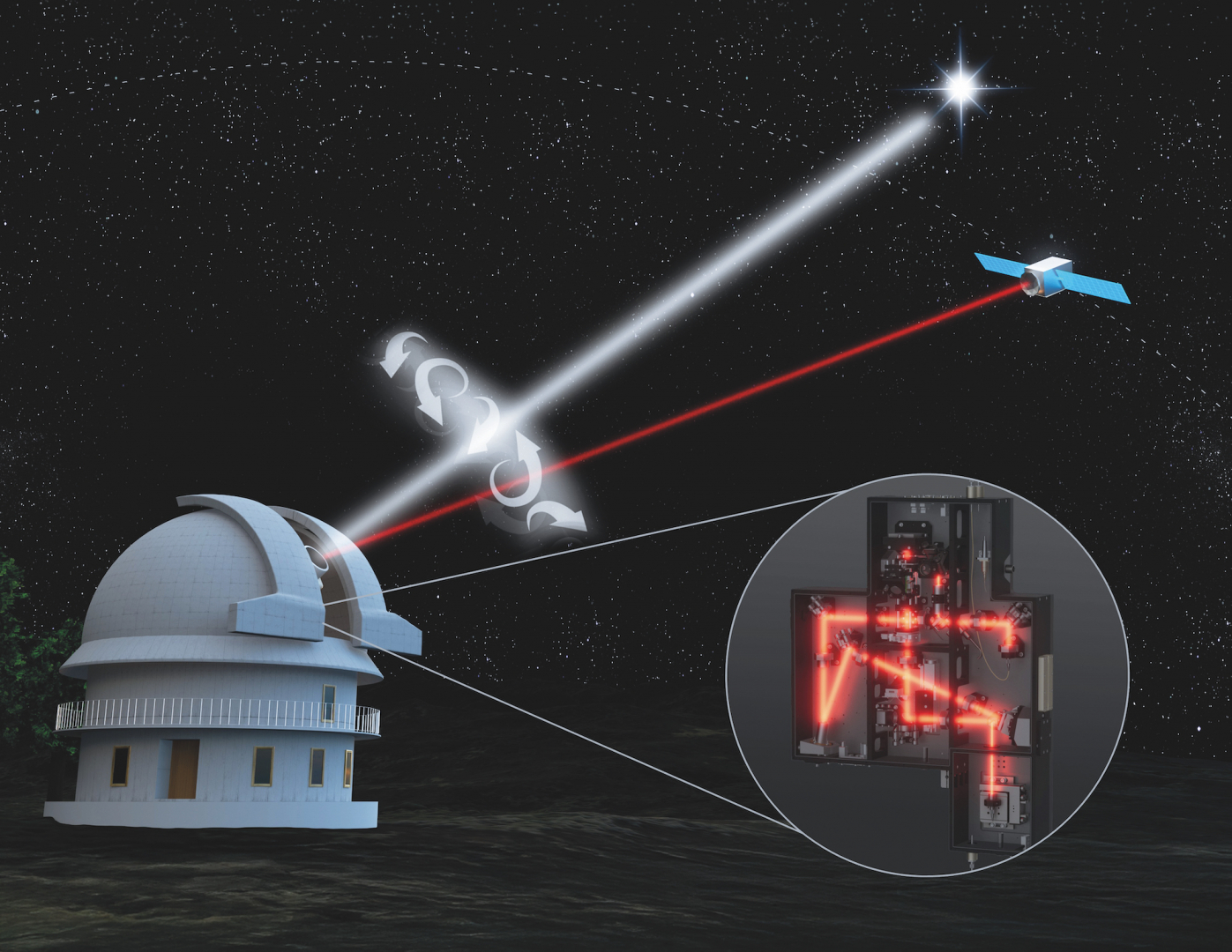 Atmospheric turbulence causes wavefront distortions, which are problematic for astronomical observations, for example. A compact module with adaptive optics (enlarged on the right) is designed to help correct the effects of atmospheric turbulence. Illustration: Fraunhofer IOFCorrecting seeing is technically possible. It can be achieved using what is known as adaptive optics. This is a technology that can largely correct the distortions in starlight caused by atmospheric turbulence. Adaptive optics has been used successfully for around 20 years on large telescopes in the eight-meter class. However, it is not yet widely used on smaller telescopes due to its cost and complexity.
Atmospheric turbulence causes wavefront distortions, which are problematic for astronomical observations, for example. A compact module with adaptive optics (enlarged on the right) is designed to help correct the effects of atmospheric turbulence. Illustration: Fraunhofer IOFCorrecting seeing is technically possible. It can be achieved using what is known as adaptive optics. This is a technology that can largely correct the distortions in starlight caused by atmospheric turbulence. Adaptive optics has been used successfully for around 20 years on large telescopes in the eight-meter class. However, it is not yet widely used on smaller telescopes due to its cost and complexity.
The Thuringia State Observatory and Fraunhofer IOF want to change that. Their FREEFIB research group works on a solution for coupling a laser beam, which is transmitted through the air via a free beam on an optical line-of-sight connection, back into an optical fiber, specifically a single-mode fiber. The goal is to develop a compact and cost-efficient module for fiber coupling of starlight or laser light for telescopes in the one- to two-meter class. The name FREEFIB is a combination of the free beam of light, or “free space,” which is directed into a fiber.
Reducing signal loss between ground stations and satellites
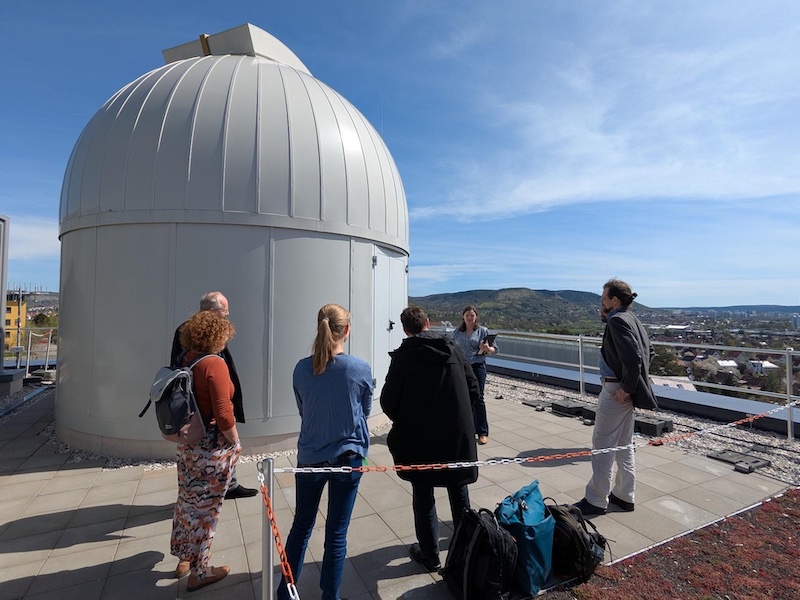 Members of the FREEFIB research group on the roof of the Fraunhofer IOF in Jena. Aoife Brady (fifth from left) explains the function of the optical ground station. The dome houses a fast-moving telescope for optical communication with satellites. Photo: TLSFraunhofer IOF is a pioneer in applied research on laser communication and quantum encryption. Similar to telescopes in astronomical research, atmospheric turbulence causes high signal losses between optical ground stations and satellites in laser-based signal transmission. The solution here, too, is adaptive optics.
Members of the FREEFIB research group on the roof of the Fraunhofer IOF in Jena. Aoife Brady (fifth from left) explains the function of the optical ground station. The dome houses a fast-moving telescope for optical communication with satellites. Photo: TLSFraunhofer IOF is a pioneer in applied research on laser communication and quantum encryption. Similar to telescopes in astronomical research, atmospheric turbulence causes high signal losses between optical ground stations and satellites in laser-based signal transmission. The solution here, too, is adaptive optics.
The Thuringian State Observatory is planning to build an ultra-high-resolution spectrograph for long-term asteroseismic studies of bright stars. In both applications, it is necessary for the light received by the telescope to be fed into a thin glass fiber (single-mode glass fiber) so that it can be transmitted to an analysis device. This is referred to as fiber coupling.
Professor Dr. Markus Roth, director of the Thuringian State Observatory, is delighted about the collaboration with the Fraunhofer Institute for Applied Optics and Precision Engineering IOF: "The FREEFIB research group brings together two partners who want to tackle a similar technical challenge. It is a huge advantage that there is such a large network of optics specialists in Jena. This facilitates cooperation. Both research institutes will benefit from the results."
"TLS Tautenburg and Fraunhofer IOF Jena are continuing their successful cooperation in the FREEFIB research group. The expertise of both institutes makes it possible to adapt single-mode fiber coupling technology for larger telescopes. The challenge is to simplify adaptive optics and thus also address new applications beyond communication and spectroscopy,“ says Dr. Ramona Eberhardt, deputy director at Fraunhofer IOF.
FREEFIB continues until December 2027. The research is financed by the Free State of Thuringia with funding from the European Social Fund (ESF) Plus.
Obituary: Dr. Patrick Gaulme
31.07.2025
Patrick Gaulme, tenured researcher at the Thüringer Landessternwarte - Karl Schwarzschild Observatory, passed away on July 14, 2025, at the age of 47, following pancreatic cancer.
Patrick was born in Paris on July 22, 1978. He got his PhD in Astrophysics at Université Pierre et Marie Curie in 2005 under the supervision of Prof. Benoît Mosser. The subject of the thesis was "Jovian seismology: the study of oscillations by visible photometry and data analysis of spectral data".
|
|
At the end of 2005, he moved to Nice for a postdoctoral position under the supervision of Dr. François-Xavier Schmider as the co-leader of the SYMPA project, a ground-based Doppler spectro-imager dedicated to seismic studies of Jupiter. Two years later, he moved back to Paris as a teaching assistant, where he conducted research on Venus’ atmospheric dynamics in support of ESA’s Venus Express mission.
In 2008, he was offered a three-year contract as an instrument scientist at the Institut d’Astrophysique Spatiale under the supervision of Dr. Thierry Appourchaux for implementing a Doppler spectro-imager aboard the ESA-NASA Juice mission. He also took part in the data analysis of the Kepler (NASA) and CoRoT (CNES) data, broadening his palette to include studies of other stars and planets.
In 2011, he moved to Las Cruces, New Mexico, USA, where he joined New Mexico State University as a postdoctoral researcher. He worked with Prof. Jason Jackiewicz on red giant stars in binary systems and on a ground-based version of the Doppler spectro-imager. His generous mentoring of graduate students led to several interesting PhD dissertations. He then became a support astronomer at Apache Point Observatory, performing service observations for the community with the Sloan Digital Sky Survey.
At the end of 2017, Patrick joined the team of Prof. Laurent Gizon at the Max Planck Institute for Solar System Research in Göttingen, Germany. There, he played a key role in the scientific preparations for ESA’s exoplanet and stellar-physics mission PLATO, scheduled for launch in December 2026. He initiated the Data Analysis Support Tools effort, providing the interface between the mission database and hundreds of consortium scientists. In parallel, he led a small team of postdocs and students at the institute, focusing on asteroseismology, particularly of binary stars.
In June 2023, he got a tenure-track scientist position at the Thüringer Landessternwarte (TLS) in Tautenburg, where he carried out observations at the Karl Schwarzschild Observatory. He started giving lectures at the Friedrich-Schiller-University in Jena and supervising students together with Prof. Dr. Markus Roth.
While on a conference trip to Padova, in July 2024, he first noticed symptoms that were later diagnosed as pancreatic cancer. Despite facing a terminal illness, he remained optimistic and determined to fight it. He stayed active in research and visited the institute whenever possible to attend open-door days and colloquia and meet with colleagues.
The many different positions held by Patrick reflect his openness and across-the-board skills. He was equally passionate about developing new instrumentation and exploring the scientific discoveries they would enable. He had a broad mind, working across diverse fields of physics, an uncommon trait among today’s scientists. This broad scientific knowledge and curiosity were Patrick’s defining qualities. Crossing disciplinary borders, he organized an exchange with the Bauhaus University Weimar where art and design PhD students and professors met astrophysics students and scientists from TLS. Anybody who attended these meetings, will now view Jupiter in a different light.
But a life cannot be summarized in the many positions one had. Patrick was more than a mere scientist. His broadness of mind was patent in his musical culture: rock’n roll at heart but obviously psychedelic. He definitely liked to play music and his guitar; at the end of June, he put some songs on the soundcloud.com platform. Patrick’s artistic talents extended beyond music, as shown in this magnificent portrait of the Karl Schwarzschild Observatory under a sky full of aurorae and stars.
|
Aurora over the Karl Schwarzschild Observatory. New Year’s card drawn by Patrick sent to TLS staff, and used as seasonal greetings of TLS in winter 2024/2025. Painting by Patrick Gaulme in India ink on “cappuccino” paper from Hahnemühle. |
Patrick was also a true Parisian, exploring the intricate tunnels of the catacombs, or sneaking on a scaffolding for exploring Notre Dame by night. He also had a great interest in photography, not the digital kind but the old-fashioned argentic one. He also paid a keen interest to the old oak tree in Meudon by making a time lapse of its evolution during his PhD thesis, showing his patience, contemplation, precision and rigor. He was also a true dreamer, fulfilling both his and Paola’s wish to own a fancy VW combi, and together they re-discovered the world around Las Cruces in this old fashioned “car”. Their dreams expanded along with their growing family.
Patrick is survived by his beloved wife Paola and their four children. Patrick was a beautiful mind, he will be deeply missed by his family, friends and collaborators. Patrick has returned to the stars, at peace and serene. We will not forget him.
Thierry Appourchaux, Laurent Gizon, Jason Jackiewicz, Benoît Mosser, Markus Roth, François-Xavier Schmider
Interdisciplinary conference on the Physics of the Sun
14.07.2025
Scientists took an interdisciplinary look at our Sun during a Spanish-German research seminar. Markus Roth, director of the Thuringian State Observatory was one of the scientific co-organizer of the conference.
"Interdisciplinary Physics of the Sun" – that was the focus of a conference taking place at the Physikzentrum Bad Honnef, Germany, from June 29 to July 4, 2025. It was jointly organized by Markus Roth, Daniel Bemmerer of the Helmholtz-Zentrum Dresden-Rossendorf, and Aldo Serenelli of the Institute of Space Sciences in Cerdanyola del Valles, Spain. The Wilhelm und Else Heraeus-Stiftung financed the conference.
 Since several decades, close scientific ties exist between Spanish and German astronomers. At the Observatorio del Teide on the Canary Island of Tenerife, for example, solar physicists from both countries use the Vacuum Tower Telescope and GREGOR, both solar telescopes, to study processes on our star.
Since several decades, close scientific ties exist between Spanish and German astronomers. At the Observatorio del Teide on the Canary Island of Tenerife, for example, solar physicists from both countries use the Vacuum Tower Telescope and GREGOR, both solar telescopes, to study processes on our star.
Modeling magnetic eruptions in the corona
At the conference, the Spanish-German research team that uses the solar telescopes on the Canary Islands reported on new observations and modeling of magnetic eruptions in the corona, which can now be studied with a resolution in the 100 km range and provide insights into space weather.
Although the planned European Solar Telescope (EST) and the new telescope network “Solar Physics Research Integrated Network Group” (SPRING) are not yet in place, new instrumental and analytical work, particularly from German institutes, are already helping to understand the physics behind solar activity. Research that traced the total radiation of our sun back over thousands of years using historical records and isotope data is very closely related to current problems.
Improved data on neutrino fluxes expected
The cross sections for the fusion reactions of the proton-proton chains and the CNO cycle (named after the elements carbon, nitrogen, and oxygen, which act as “catalysts”) that were reevaluated as part of the “Solar Fusion III Review” were compared with the latest solar model. Although there is currently no dedicated solar neutrino detector, there is justified hope that the neutrino experiments SNO+ (successor to the Sudbury Neutrino Observatory), JUNO (Jiangmen Underground Neutrino Observatory) and probably also the liquid xenon detectors will provide improved data on solar neutrino fluxes in the coming years as a kind of by-product. In the US, two laboratories are working to remeasure the opacities of elements relevant to the Sun.
A total of 56 participants from Germany and partner country Spain, as well as Algeria, Belgium, China, Great Britain, Italy, Japan, the Netherlands, South Korea, and the US, discussed recent advances and new research questions relating to the Sun. Topics ranged from particle physics and magnetohydrodynamics to the effects on the Earth's climate. During the conference, research results and posters by young researchers received awards.
One of the insights gained from the workshop was that the interdisciplinary exchange was particularly fruitful because it brought together two traditionally separate research disciplines, namely nuclear physics and astrophysics. This is evident, for example, in questions about element abundances, for which new evaluations of Fraunhofer absorption lines were presented. These are closely linked to the modeling of material transport and its development in the Sun and, via nuclear reactions, also to neutrinos from the sun's interior. There is great hope that the contacts made during the conference will spark new directions in research in the future.
|
Andres Vicente Arevalo (second from left) from the Institut für Sonnenphysik (KIS) was awarded a price for his poster "3D inversion of solar prominences". Next to him are the scientific organizers of the confercence: Markus Roth (left), Aldo Serenelli und Daniel Bemmerer. |
Daye Lim (second from right) from the KU Leuven won a poster price for "Quasi-Periodic Pulsations in EUV Brightenings". The source of all the pictures is the conference website. |
|
Ashish Mishra's poster also received a price. He works at the Helmholtz-Zentrum Dresden-Rossendorf. The topic was "MRI in Rotating Flows". |
Eva Sola-Viladesau from the Universidad de La Laguna, Spain, got a poster price for "Heating, magnetism and geometry of hot coronal loops from CBPs". |
Students from the Wilhelm-Ostwald-Gymnasium in Leipzig visit the Observatory in Tautenburg
25.06.2025
A group of 25 students from the Wilhelm-Ostwald-Gymnasium (WOG) in Leipzig, together with two teachers, visited the Thuringian State Observatory in June 2025. Visiting an astronomical research facility is a great addition to the content taught in their astronomy class.
Wilhelm-Ostwald-Gymnasium is a public school with an in-depth STEM education (STEM: science, technology, engineering and mathematics). Astronomy courses are also offered for senior students. The idea behind the visit to the observatory was to give students a better idea how astronomers work and to show them the research facilities. Maja Mauksch, a student at WOG, is currently working on her BeLL (BeLL: Besondere Lernleistung, extraordinary learning performance) paper at the Tautenburg Solar Lab TauSoL. She connected the astronomy teachers at WOG with the scientists at TLS so that a group visit could be organized.
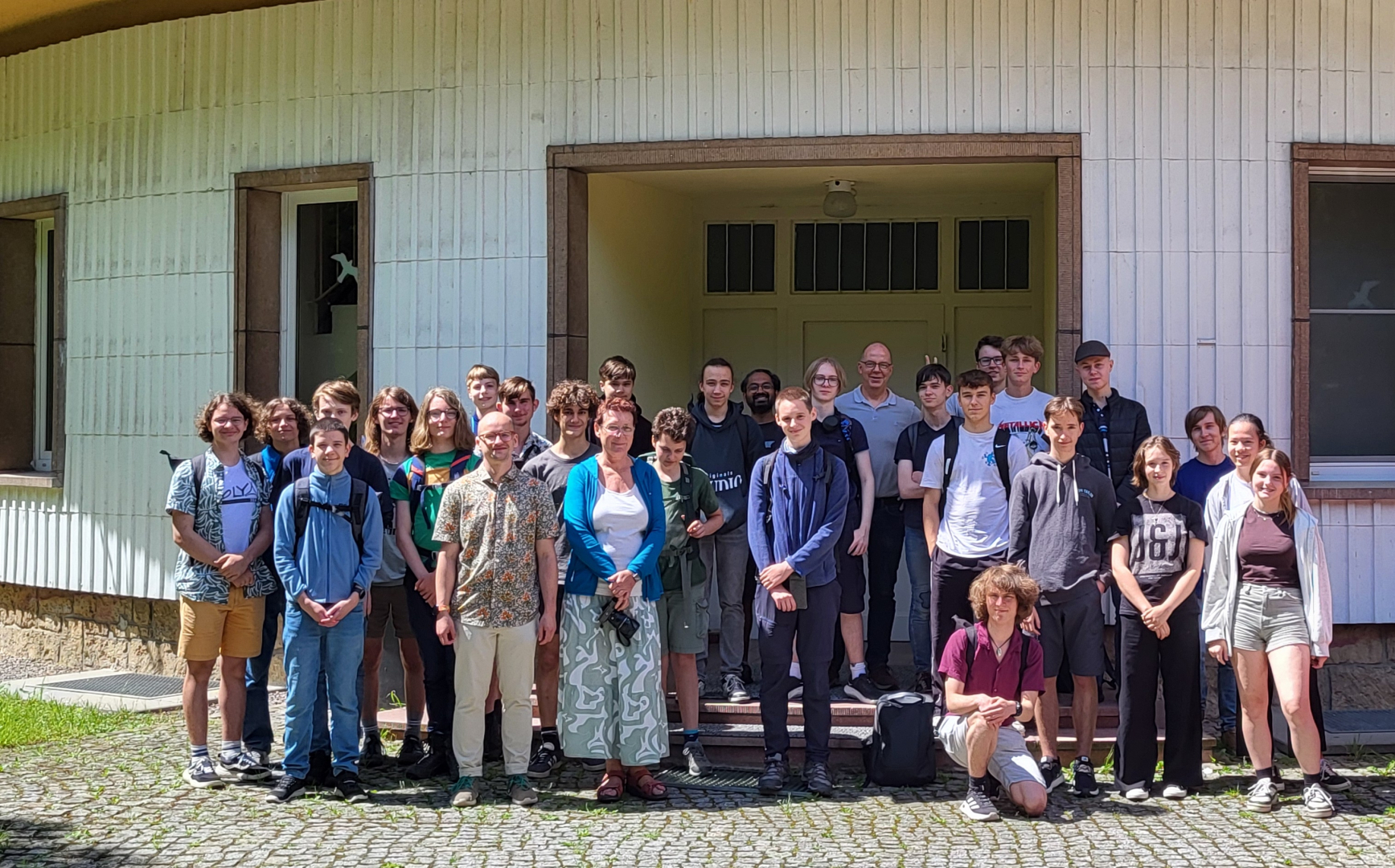 A group of pupils from the Wilhelm-Ostwald-Gymnasium Leipzig visits the Thuringian State Observatory. Foto Credit: TLSAstronomical telescopes and the Sun were the focus of this year's astronomy class. TLS has quite a bit to show for both topics. Shortly before the student group came to visit TLS, Maja Mauksch presented her work at her school. So when the students arrived, they came prepared and had lots of questions about the Sun and the Solar Lab. In addition to the participants in the astronomy course, interested middle school students were also able to register for the excursion. The result: A highly motivated group got off the bus at 9:30 a.m. on Tuesday morning. They were greeted by Michael Sigwarth and Eike Guenther, both scientists at TLS.
A group of pupils from the Wilhelm-Ostwald-Gymnasium Leipzig visits the Thuringian State Observatory. Foto Credit: TLSAstronomical telescopes and the Sun were the focus of this year's astronomy class. TLS has quite a bit to show for both topics. Shortly before the student group came to visit TLS, Maja Mauksch presented her work at her school. So when the students arrived, they came prepared and had lots of questions about the Sun and the Solar Lab. In addition to the participants in the astronomy course, interested middle school students were also able to register for the excursion. The result: A highly motivated group got off the bus at 9:30 a.m. on Tuesday morning. They were greeted by Michael Sigwarth and Eike Guenther, both scientists at TLS.
"Now I remember again", commented Petra Schupke, one of the teachers who accompanied the group, when she arrived. She had received her degree for teaching astronomy at the Friedrich-Schiller-University in Jena. As part of her studies, she had visited the observatory back then. Ronny Möbius, also a teacher at WOG and advisor of Maja Mauksch, was happy to finally visit the research institution after listening to the reports of his student and exchanging several mails to prepare the excursion.
Visiting the Solar Lab and the optical 2 meter telescope
First, Michael Sigwarth and Eike Guenther told the group details about the history of the observatory. They also described what research is being conducted there. Afterwards, the students were divided into two groups. While one group went to see the optical 2 meter telescope, the other one went to visit the Solar Lab - and vice versa. The first group coming to the solar lab was lucky: They got to see a live picture of the sun, before it disappeared behind clouds. But TLS scientists Michael Sigwarth and Hemanth Pruthvi were prepared. They used pictures to explain how research is done in the Solar Lab.
Meanwhile, Eike Guenther explained how the optical 2 meter telescope works and what it is used for. And he impressed his visitors when he made the dome turn and the telescope move. At 12 o'clock on the dot the group left to return to Leipzig (so that there was no time left for some students to lighten the cherry trees at the observatory). Too bad, especially because the Sun appeared again from behind the clouds. Hopefully, an excursion to TLS will become a permanent component of the astronomy classes at Wilhelm-Ostwald-Gymnasium in the future.
Author: Michael Sigwarth
How a new Camera System provides a more detailed Look at the Sun
20.05.2025
A team of solar physicist, among them Markus Roth, director of the Thuringian State Observatory, got a more detailled view of active regions of the Sun. They used a modern camera system and managed to get high-resolution pictures of Sun spots. The pictures were taken at the Vacuum Tower Telescope at the Observatorio del Teide on the island of Tenerife. The Thuringian State Obseratory (Thüringer Landessternwarte, TLS) plans to use another instrument at this observatory as well.
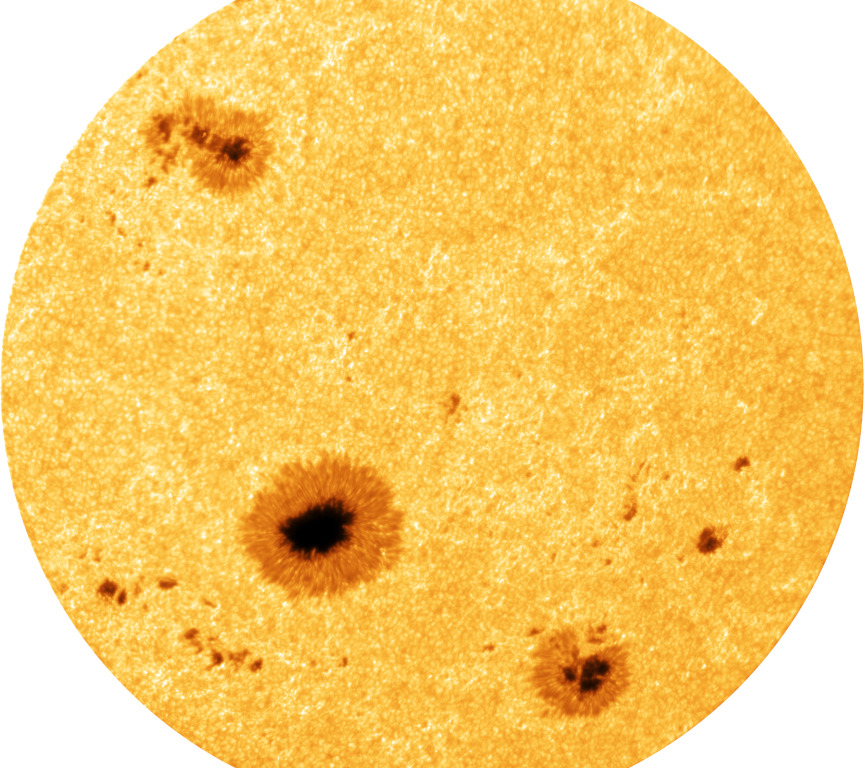 Images: R. Kamlah et al. 2025
Images: R. Kamlah et al. 2025
Large solar telescopes can observe the smallest details on the surface of the sun, but only in small image sections. As a result, they miss out on the big picture: How is the large-scale environment of these active regions developing? Smaller telescopes in space or in earth-spanning networks observe the entire solar disk around the clock, but they cannot zoom into the complex and rapidly changing structures that are shaped by the sun's magnetic field. The Vacuum Tower Telescope (VTT) can meet both requirements because it has a large field of view and good spatial resolution.
A new, modern camera system from the Leibniz Institute for Astrophysics Potsdam (AIP) makes use of the VTT's large field of view. At the same time, it provides detailed images of the surface of the sun by reconstructing images.
High-resolution images of sunspots
For such a reconstructed image, 100 short time-exposure images with 8,000 × 6,000 pixels are required, which are taken at 25 frames per second. This fast image sequence makes it possible to eliminate the disruptive influence of Earth’s turbulent atmosphere from the solar images.
Viewed in time-lapse, the images provide a better picture of the dynamic processes taking place on the surface of the sun. In short: with the new camera system, details of sunspots become better visible, while at the same time their surroundings remain in view - thanks to the VTT's large field of view.
Getting a better understanding of what’s going on in the Sun’s interior
Research into solar activity is a key focus at the Thuringian State Observatory. In addition to the Tautenburg solar laboratory, researchers at TLS will be using another observation instrument to explore our star: the HELLRIDE instrument, which is also located at the Vacuum Tower Telescope at the Observatorio del Teide on Tenerife in Spain. HELLRIDE stands for Helioseismic Large Region Interferometric Device.
Solar physicists want to use instruments such as HELLRIDE, the new camera system, the Tautenburg solar laboratory and other scientific tools to find answers to the following questions: Does the plasma (the particle mixture of ions and electrons that makes up the Sun) change before a solar flare? How can the magnetic field under the surface of the sun be detected? How do sunspots develop and what happens inside them?
To find answers to such questions, astronomers measure the high-frequency seismic waves of the sun. This is known as helioseismology. They look at longer periods of time to find out how active regions with sunspots change before, during and after a solar flare. The data are obtained using the Tautenburg Solar Laboratory and the HELLRIDE instrument at the Vacuum Tower Telescope on Tenerife, among others. Markus Roth explains why this research is important: “Such studies help us to understand how the strength of solar eruptions varies”.
Strong eruptions and coronal mass ejections occur repeatedly on the sun. They hurl huge amounts of matter into space and create shock waves. The solar wind is suddenly amplified and transports many more particles than usual towards Earth. This material (plasma) can affect technological facilities in space and on Earth as a solar storm. This is known as space weather.
Telescopes such as the Vacuum Tower Telescope and the Tautenburg Solar Laboratory can make important contributions to research into solar activity and therefore also space weather.
Links
Article about the high-resolution images of the sun taken with the new camera system:
R. Kamlah et al. 2025, Wide-field Image Restoration of G-Band and Ca II K Images Containing Large and Complex Active Regions, in: Solar Physics,
doi: https://doi.org/10.1007/s11207-025-02472-6
More information on the HELLRIDE instrument (in German):
www.leibniz-kis.de/de/observatorien/vakuum-turmteleskop/instrumente-am-vtt/hellride
Talks and Guided Tours - the Programme for the Open House
06.05.2025
The Thuringian State Observatory invites all astronomy fans to come visit during its Open House on Sunday, May 25th, 2025. Visitors can see the 2-meter Alfred Jensch telescope and the LOFAR radio telescope.
The gates to the observatory grounds will be open from 10 am to 5 pm. Scientists will entertain the public with guided tours and talks about their research.
A broad range of topics
Why is the Sun such a special star for us? Is it actually possible to observe northern lights in Thuringia? How do radio waves draw a map of the sky? As you can tell from these questions, the talks during Open House will cover a wide range of astronomical subjects. All talks will be in German except the talk on "Asteroseismology - The Sound of Stars".
| Time |
Topic | Speaker |
| 10:30 am - 11:15 am | Polarlicht – the Beauty and the Biest | Dr. Jochen Eislöffel |
| 11:30 am - 12:15 pm | Die Sonne - der Stern mit dem wir leben | Prof. Dr. Markus Roth |
| 12:30 pm - 1:15 pm | Der Himmel in Radiowellen: Galaxien am Ende des Universums | Prof. Heinz Andernach |
| 1:30 pm - 2:15 pm | Ein junger Stern beim Wachsen - Familienvortrag für Groß und Klein | Dr. Verena Wolf |
| 2:30 pm - 3:15 pm | Asteroseismology - The Sound of Stars (talk is in English/Vortrag auf Englisch) | Aashana Tripathi |
| 3:30 pm - 4:15 pm | Von Schwarzen Löchern und kosmischen Kollisionen | Prof. Dr. Matthias Höft |
Where to listen to the talks: All presentations will take place in the seminar room on the second floor of the administrative building (Neubau). (Access is not barrier free.)
Visit the 2-meter Alfred Jensch telescope
We will offer guided tours through the telescope building and dome every half hour between 10.15 am and 4.15 pm. During those tours, scientists will also explain how the radio telescope LOFAR and the Tautenburg Solar Laboratory work.
To coordinate the visitor flow, we will hand out tickets to the dome (free of charge). By limiting the amount of visitors per tour we make sure that it does not get too crowded in the dome and in the building. We ask for your understanding that you may have to wait a bit until your guided tour starts.
At 12.45 there will be a guided tour in English.
Special activities for kids
There will be guided tours through the dome for families at 10.45 am, 12.15 pm, 2.45 pm and 3.45 pm. Kids can also paint their own pictures of the night sky. And we will explain to our young visitors how a telescope works with our "Tautenburg Tiny Telescope".
More Highlights:
Live observation with the radio telescope: The radio astronomy team will show our visitors how the LOFAR radio telescope works.
Tautenburg Solar Laboratory: We explain how we learn more about our Sun by using the Tautenburg Solar Laboratory.
A few practical details:
Unfortunately, the dome and the buildings are not barrier free.
The entrance to the Open House event is free of charge, a reservation is not necessary. Group size (per guided tour) to visit the dome with its 2 meter telescope is limited to 70 visitors due to limited space. In order to avoid that too many people are in the dome at the same time, (free) tickets for the tours will be handed out right in front of the dome. We appreciate the interest in the 2-meter telescope and ask for your understanding that you may have to wait a bit until your guided tour starts.
You can buy food and drinks, coffee and cake during Open House.
We are looking forward to your visit on May 25th, 2025!
Reviewing extrasolar planets to find possible patterns
08.04.2025
The “Encyclopaedia of Exoplanetary Systems” currently lists 7.441 extrasolar planets (as of March 2025). With so many known extrasolar planets or planetary systems, astronomers try to find patterns why certain stars have planetary companions and how to characterize and group those planets.
To help answer those questions, Artie Hatzes, former director of the Thuringian State Observatory, will start a new research project. He will review all the planets found by the KESPRINT consortium. The KESPRINT consortium is devoted to detecting and characterizing extrasolar planets found by space-based telescopes like “Kepler” or “TESS” (Transiting Exoplanet Survey Satellite).
Homogeneous database
Reviewing the over 100 extrasolar planets found by KESPRINT has one big advantage: The consortium knows how their observational data was analyzed and that the data was reduced in the same way. Furthermore, the KESPRINT sample has some of the most precise measurements for the masses of small planets. That makes the KESPRINT sample special. “It provides a great base for this review project”, says Artie Hatzes.
The idea for this review project was born during a staff exchange under the EXOWORLD project funded by the European Union. Hatzes visited fellow KESPRINT members at the NINS (National Institutes of Natural Sciences) Astrobiology Center, located at the National Astronomical Observatory of Japan (NAOJ) in Tokyo.
Meeting KESPRINT colleagues for the first time
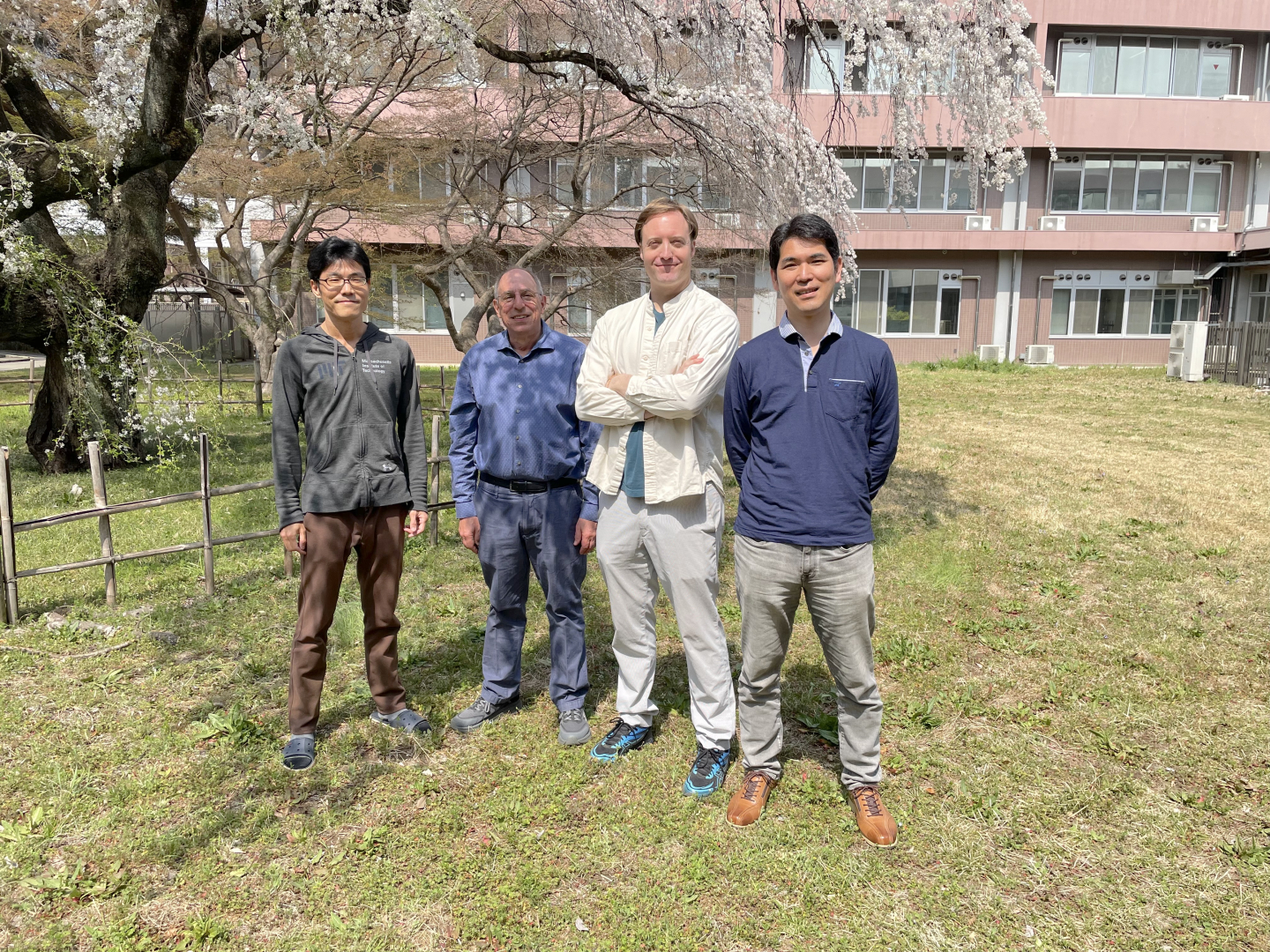 Teruyuki Hirano (Associate Professor at NINS Astrobiology Center), Artie Hatzes (Thuringian State Observatory), John Livingston (Assistant Professor at NINS Astrobiology Center) and Norio Narita (professor at the University of Tokyo) are members of the international KESPRINT consortium. Photo: Thuringian State ObservatoryNorio Narita (professor at the University of Tokyo), Teruyuki Hirano (Associate Professor at NINS Astrobiology Center), and John Livingston (Assistant Professor at NINS Astrobiology Center) are also members of the international KESPRINT consortium. Even though Artie Hatzes has worked since many years with Teruyuki Hirano, John Livingston and Norio Narita, they so far had only met via online meetings or briefly at conferences. Thanks to the EXOWORLD project, Hatzes was able to visit his KESPRINT colleagues at NINS Astrobiology Center for the first time.
Teruyuki Hirano (Associate Professor at NINS Astrobiology Center), Artie Hatzes (Thuringian State Observatory), John Livingston (Assistant Professor at NINS Astrobiology Center) and Norio Narita (professor at the University of Tokyo) are members of the international KESPRINT consortium. Photo: Thuringian State ObservatoryNorio Narita (professor at the University of Tokyo), Teruyuki Hirano (Associate Professor at NINS Astrobiology Center), and John Livingston (Assistant Professor at NINS Astrobiology Center) are also members of the international KESPRINT consortium. Even though Artie Hatzes has worked since many years with Teruyuki Hirano, John Livingston and Norio Narita, they so far had only met via online meetings or briefly at conferences. Thanks to the EXOWORLD project, Hatzes was able to visit his KESPRINT colleagues at NINS Astrobiology Center for the first time.
They discussed ideas on how to better explore the properties of small planets found by the KESPRINT consortium. Hatzes and Hirano also have a shared interest in using high precision radial velocity measurements in the infrared for detecting and characterizing extrasolar planets.
Introducing CRIRES+ and VIPER
The staff exchange program enabled students and post-docs at the NINS Astrobiology Center to learn more about the CRyogenic high-resolution InfraRed Echelle Spectrograph “CRIRES+”. Hatzes was the Consortium Principal Investigator for CRIRES+ , an instrument built by ESO in collaboration with a consortium of European institutes. Hatzes presented the capabilities of the instrument, its performance and what it can do for characterizing extrasolar planets.
He also introduced the VIPER software, a program for a radial velocity reduction pipeline, that is used for reducing observation data taken with CRIRES+. VIPER is developed and improved at the Thuringian State Observatory, and available to the research community as open-source program.
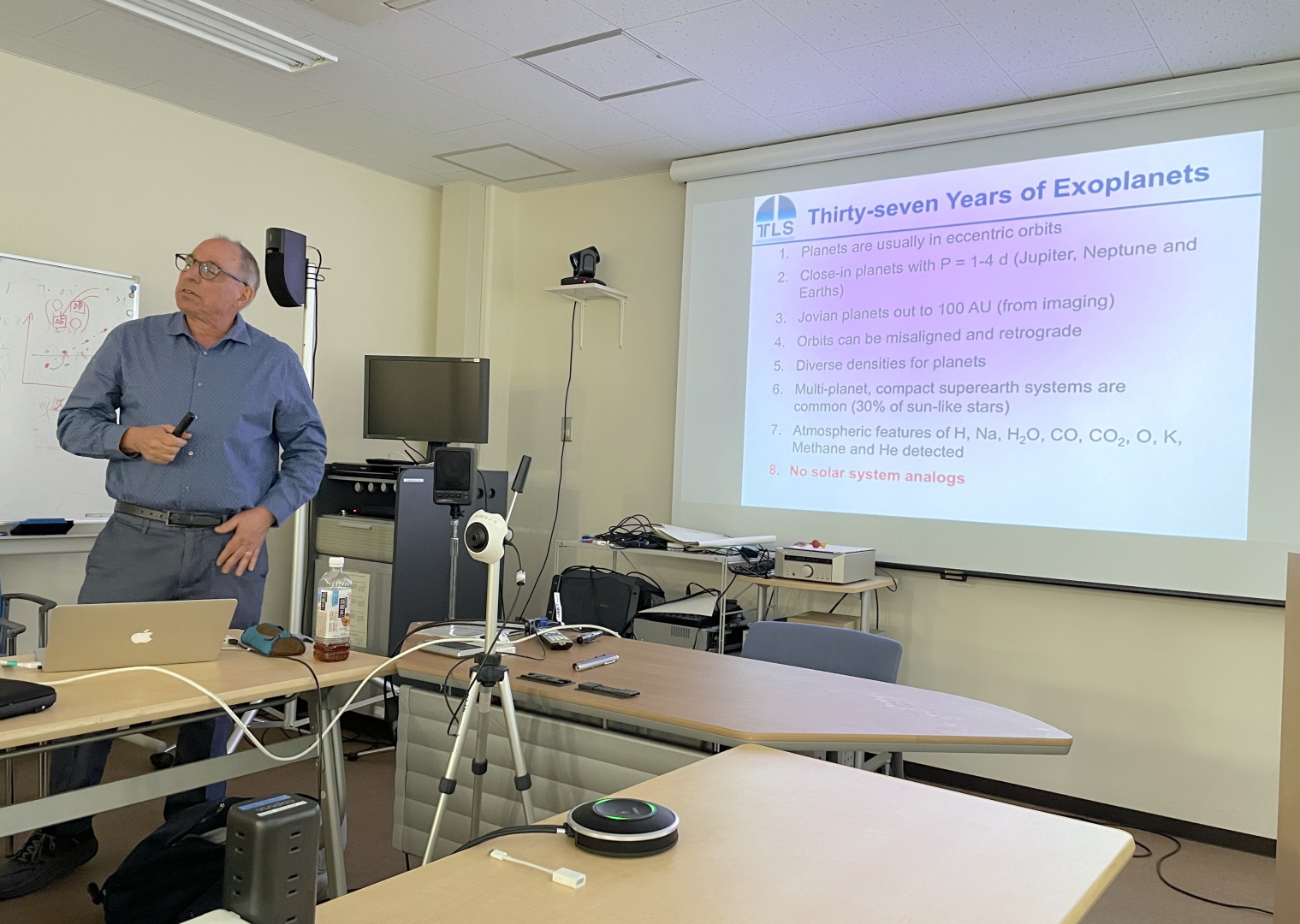 In his talk, Artie Hatzes looked back on an active career in exoplanet research for the past 37 years. Photo: Thuringian State ObservatoryHatzes is one of the few astronomers who has detected and studied extrasolar planets almost from the very onset of this exciting research area. His talk at the NINS Astrobiology Center on how the field of exoplanet research developed over the past almost 40 years, surprises along the way, and lessons learned, was well received.
In his talk, Artie Hatzes looked back on an active career in exoplanet research for the past 37 years. Photo: Thuringian State ObservatoryHatzes is one of the few astronomers who has detected and studied extrasolar planets almost from the very onset of this exciting research area. His talk at the NINS Astrobiology Center on how the field of exoplanet research developed over the past almost 40 years, surprises along the way, and lessons learned, was well received.
Background Information
The KESPRINT consortium is devoted to detecting and characterizing extrasolar planets found by space-based telescopes like “Kepler” or “TESS” (Transiting Exoplanet Survey Satellite). KESPRINT provides mass measurements that yield the planet density needed to determine the type of planet (gas giant or rocky.) KESPRINT is one of the most successful teams world-wide for the measurement of masses of transiting exoplanets found by the TESS mission. The KESPRINT consortium consists of 47 members in 9 countries (Germany, Austria, Italy, Spain, Sweden, Denmark, The Netherlands, Japan, and USA). The Thuringian State Observatory is a founding member of KESPRINT.
Hatzes’ research stay was made possible by European Union research funding. The Thuringian State Observatory is part of the EXOWORLD consortium who had successfully applied for Staff Exchanges as part of Marie Skłodowska-Curie Actions (Project ID: 101086149). “Understanding the evolution of EXOplanets and towards habitable WORLDs (EXOWORLD)” is a consortium that comprises 12 organizations from eight countries. It leverages interdisciplinary and international expertise to study the diversity of exoplanets.
Partial Solar Eclipse
31.03.2025
On Saturday, 29. March 2025, a partial solar eclipse occurred, which was visible from Thuringia. The eclipse started with the first contact of the Moon at the edge of the solar disc at 11h27 CET and ended with the last contact of the Moon at 13h03 CET. This photo of TLS shows Sun and Moon at the time of the maximum occultation at 12h15 CET, when the Moon covered 26% of the diameter or 15.6% of the area of the Sun. Several sunspots are visible on the non-occulted part of the solar disc.
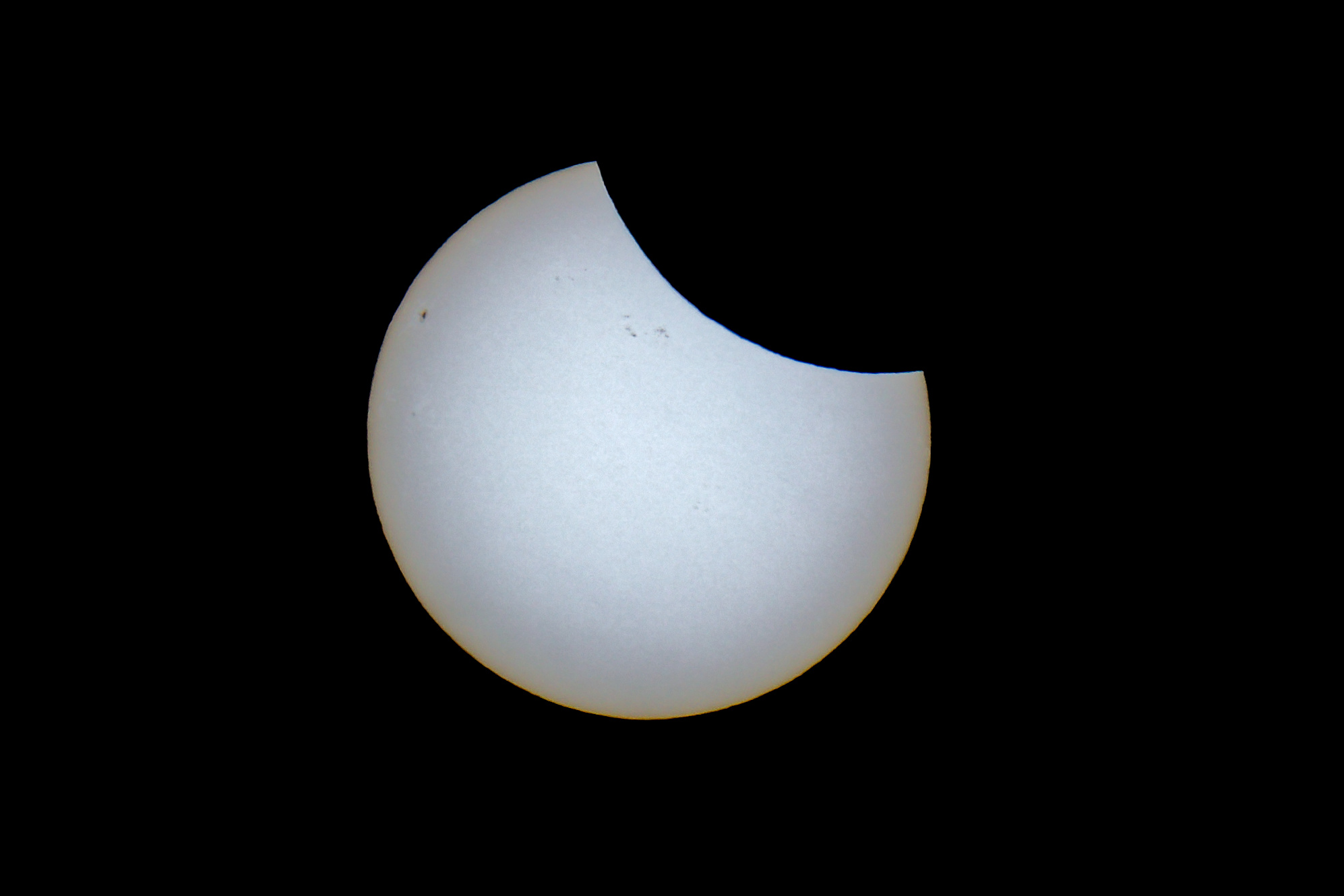
(Image: Jochen Eislöffel).
Save the Date: Open House in May
04.03.2025
A date for the Open House 2025 at the Thuringian State Observatory has been set. We invite all astronomy fans to spend time at the observatory in the Tautenburg Forest on Sunday, May 25. More details about the program will be announced soon. You will be able to listen to talks about stars, the sun, galaxies and other celestial objects and talk to astronomers. And, of course, our observation facilities such as the LOFAR radio telescope and the 2-meter optical telescope can be visited. Keep your fingers crossed that the Sun is shining, then observing "our star" might be part of the program.
There is lots to do and see around the observatory as well. Enjoy a hike in the forest or walk along the Tautenburg Planet Path and learn lots about the planets in our Solar System.
The Open House will start at 10 am and last till 5 pm. There is no fee. We are looking forward to seeing you on May 25!
Book on Data-intensive Radio Astronomy published
20.02.2025
One of the most topical issues in radio astronomy is how to process and archive huge amounts of data from modern telescopes. Researchers from the Thuringian State Observatory and the DLR Institute of Data Science in Jena have compiled expert knowledge of this topic in the book "Data-intensive Radio Astronomy".
Large international radio telescopes such as the Low Frequency Array (LOFAR) and the Square Kilometre Array (SKA) generate an almost unimaginably large amount of data. According to experts, the low-band array of the “Square Kilometre Array” in Australia alone will generate 5 zettabytes (106 petabytes) of data every year. By comparison, global internet traffic only exceeded 1 zettabyte for the first time in 2016.
In modern radio astronomy, hundreds of gigabytes of data per second will be collected and processed in so-called pipelines in order to generate scientifically usable results. Processing such huge amounts of data is a major challenge. Astronomers are therefore looking for efficient solutions that will lead astrophysics into the so-called exabyte era.
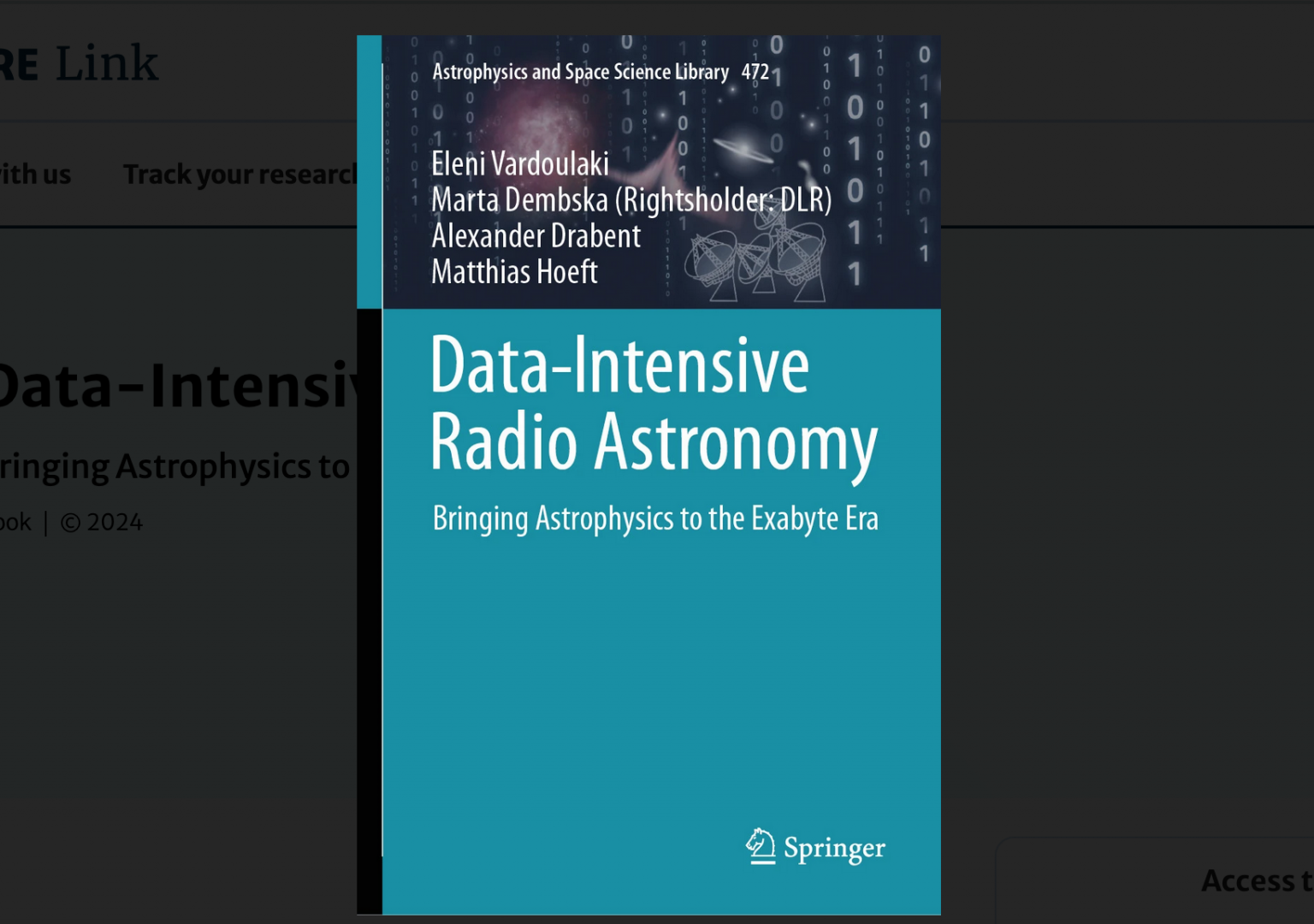 Titel of the book "Data-Intensive Radio Astronomy", published by Springer. Screenshot: Springer
Titel of the book "Data-Intensive Radio Astronomy", published by Springer. Screenshot: Springer
Such large amounts of data require data processing to be rethought at all levels. These exemplary questions which scientists try to answer provide an insight into the specific issues at stake: How can such volumes of data be handled: how can they be created, stored or archived? How can the data be compressed efficiently without losing too much information? How can rare events be detected in these huge amounts of data? How can the data be made easily accessible to a large number of scientists? What will the archive of the future look like? And last but not least, how can data processing be made sustainable, i.e. energy-saving?
As part of a project funded by the Carl Zeiss Foundation in Jena to coordinate data-intensive radio astronomy in the Jena science region, Marta Dembska from the Institute of Data Science at the DLR (German Aerospace Center) in Jena as well as Eleni Vardoulaki, Alexander Drabent and Matthias Hoeft from the Thuringian State Observatory have published the book "Data-intensive Radio Astronomy". They have edited the first monograph on this topic with contributions from many international experts, This book brings together knowledge from various fields of research to provide an overview of the current state of data-intensive radio astronomy.
The book was published in November 2024 by Springer Nature Switzerland as part of the series "Astrophysics and Space Science Library". The E-Book version is available at Amazon.
Important Milestone for Upgrade of LOFAR Radio Telescope
18.02.2025
The Thuringian State Observatory has been operating a station of the international LOFAR radio telescope since 2010. The whole telescope is currently being upgraded: The computers and software are being renewed. An important milestone has now been reached with the release of version 5.0 of the “LINC” software. Alexander Drabent, a scientist at the Thuringian State Observatory, has played a major role in this success, as he is the main software developer of LINC 5.0.
LINC is the pipeline for the first processing of the data recorded with LOFAR. The LOFAR radio telescope could also be called a software telescope because the alignment of the non-mobile radio antennas is controlled exclusively by software. In addition, the more than 50 LOFAR stations in currently eight countries generate huge amounts of data, which can only be converted into scientific research results using state-of-the-art IT technology and software.
 Alexander Drabent explains how LOFAR generates an image of the sky. Photo: TLS
Alexander Drabent explains how LOFAR generates an image of the sky. Photo: TLS
The software and its further development are therefore a relevant component of the telescope itself. “All the knowledge and technology of how the telescope observes is largely contained in the software,” explains Alexander Drabent. As the main software developer for LINC, the scientist supervises and maintains the pipeline.
Pipeline is a key component
The pipeline is a key component for the subsequent processing of the observation data. It is used to compare the recorded data sets from the LOFAR stations with a reference model. This is known as calibration and is a central component of the initial processing. “In order to 'understand' observation data and 'translate' it correctly into an image of the radio sky, for example, we need a reference. The LINC pipeline is responsible for making this possible. Almost all data recorded with LOFAR passes through this pipeline,” explains Drabent.
The pipeline eliminates distortions caused by the telescope itself or by environmental influences so that the observation data produces a clearer signal. LINC also analyzes the quality of the observed data and makes the calibration process transparent. The initial calibration is important. Without it, the observation data cannot be processed further.
LINC has already undergone many development steps. Drabent has been working on it since version 3.0. The new version 5.0 covers a much wider bandwidth of the telescope. For the first time, it can be used for data from both LOFAR antenna arrays, the high-band and low-band antennas. This is a prerequisite for the future operation of LOFAR 2.0: Simultaneous observation with both antenna arrays.
Background: Science with LOFAR
With LOFAR, astronomers can look back billions of years to a time before the first stars and galaxies formed (the so-called “dark ages”). They can map vast areas of the low-frequency radio sky with unprecedented resolution and look for radio transients originating from some of the most energetic explosions in the universe.
This video from ASTRON, the Netherlands Institute for Radio Astronomy, demonstrates how LOFAR works.
Day of Physics and Astronomy at Friedrich-Schiller-University Jena
13.02.2025
The Faculty of Physics and Astronomy at Friedrich Schiller University in Jena invites you to the “Day of Physics & Astronomy” on March 6, 2025. Pupils and anyone interested in physics and astronomy will experience an exciting day with lots of experiments.
The faculty's researchers take their guests into the fascinating world of modern science and show how research is done. Guided tours of the ultra-modern laboratories take place every 60 minutes - in cleanroom clothing, of course, which is provided for visitors. During short presentations on topics from quantum physics, gravitational physics and astronomy, everyone can join in the discussion, ask questions and experience science up close.
Markus Roth, Professor of Astronomy and Director of the Thuringian State Observatory, will be giving a lecture on the sun at 9.30 am. The sun is the only star that is close enough for astronomers to study it with high resolution. Solar physicists study sunspots, magnetic activity, helioseismology and space weather. From 10 am to 3 pm, the sun can be observed on the roof terrace of the building at Max-Wien-Platz 1 - weather permitting.
Find the full programm on this website.
Tip: If you are considering whether to study physics or to study at Friedrich Schiller University in general, this is an offer you shouldn't miss. The Infomobile of the Friedrich Schiller University Jena will be stopping at the Day of Physics and Astronomy. The student advisory service offers you the chance to find out more about studying at FSU Jena. From natural sciences to humanities and teaching, everything is on offer. Come along and bring your questions!
The event is free of charge and is aimed at school classes and young people who will soon be graduating from school. For better coordination of the laboratory tours, solar observation, etc., it is helpful if school classes register with the expected number of pupils.
Astronomers at Thuringian State Observatory notice conspicuous change in the spectrum of the recurring Nova T CrB
07.02.2025
In our observing campaign at the Thuringian State Observatory on the recurrent nova T Coronae Borealis (T CrB), we have noticed significant changes in the spectrum of T Coronae Borealis over the last two weeks. The emission lines in the spectrum have risen sharply, indicating a greatly increased accretion rate. Furthermore, emission lines can now be seen that can only occur at a temperature of at least 40000 K. These could be the first signs that the nova is about to erupt. The brightness of the system shows no change yet. We are continuing our observation campaign to catch the outburst of the nova.
The coloured lines show the spectra taken at the indicated dates and time. In February, the intensity of the lines increased dramatically. T shows Universal Time.
Evolution of the hydrogen emission lines around Hα 6560 and Hβ 4860 in the spectrum of T Coronae Borealis in the past two weeks

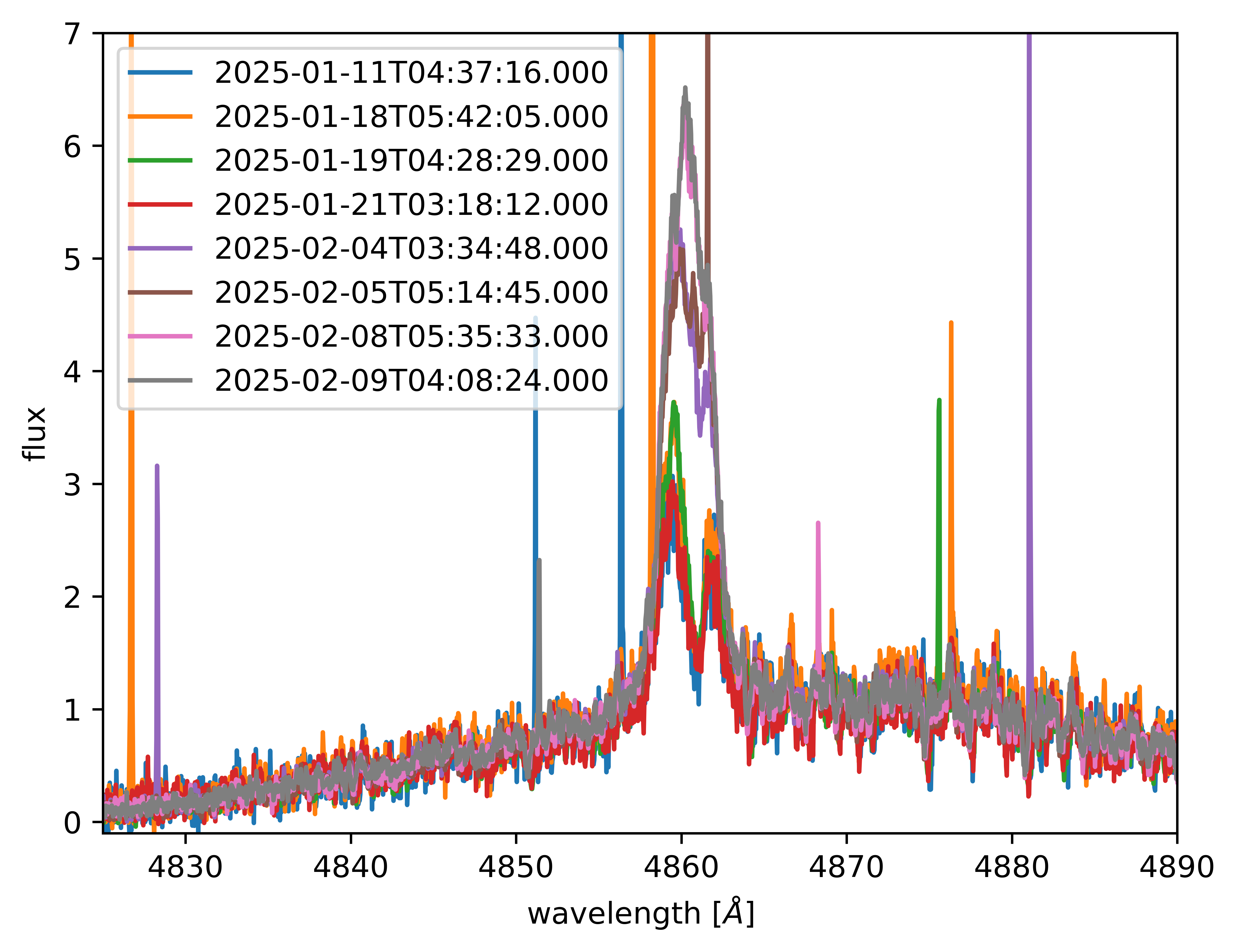
Evolution of the emission line of the neutral Helium He I 5876 and ionized He II 4686, which became visible in the last two weeks


Brightness variability of T CrB in the last 2.5 years (data taken from the AAVSO database): There is no change in the brightness during the increase in the emission lines
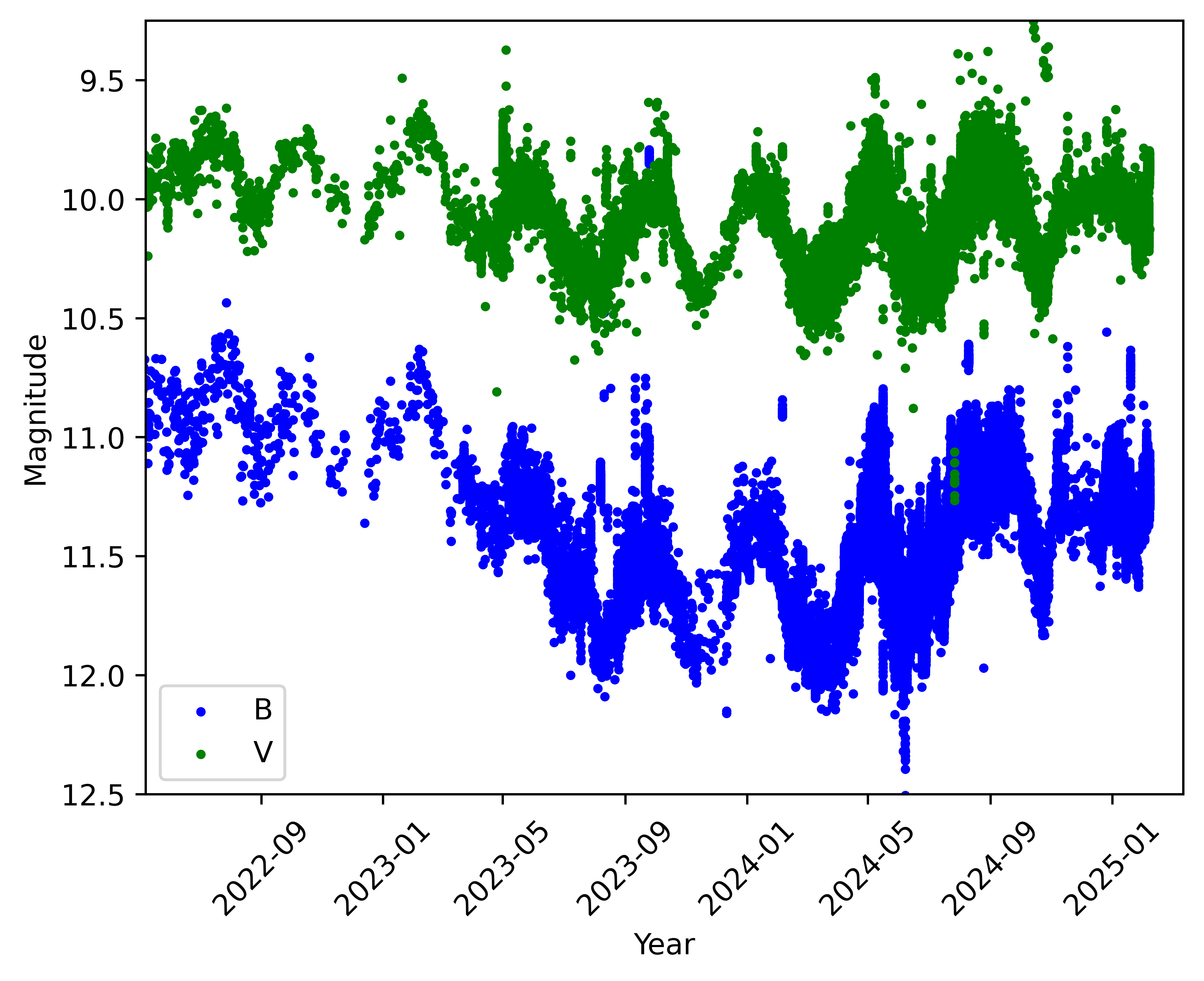
More details can be found at Astronomers Telegram.
Contact:
Dr. Veronika Schaffenroth
Markus Roth gives Inaugural Lecture at Friedrich-Schiller-University
28.01.2025
The director of the Thuringian State Observatory, Markus Roth, also teaches at the Faculty of Physics and Astronomy at Friedrich Schiller University in Jena. On January 27, 2025, he gave his inaugural lecture on “The Sun in Focus”.
 Markus Roth gives his inaugural lecture at Friedrich-Schiller-University in Jena. Photos: Thuringian State ObservatoryThe sun is the only star that is close enough for astronomers to study it with high resolution. It is therefore a fascinating object of research for Roth. In his lecture, he described how the sun is structured, how it generates energy and how convection cells make the sun bubble.
Markus Roth gives his inaugural lecture at Friedrich-Schiller-University in Jena. Photos: Thuringian State ObservatoryThe sun is the only star that is close enough for astronomers to study it with high resolution. It is therefore a fascinating object of research for Roth. In his lecture, he described how the sun is structured, how it generates energy and how convection cells make the sun bubble.
Roth also explained why sunspots are so exciting. Sunspots are places of a strong magnetic field. These spots are not always visible on the sun. There are times with more and times with fewer spots. Approximately every 11 years, the sun shows more sunspots. They appear dark because they are cooler than their surroundings. We are currently at solar maximum, which means that the sun is very active.
The sun's changing magnetic field repeatedly causes mass ejections. Solar plasma is hurled into space. These eruptions can also affect technical facilities on Earth as solar storms. Astronomers call these processes that take place in space close to Earth "space weather".
In the new solar laboratory at the Thuringian State Observatory, new compact instrumentation is being developed to enable even better observation of the sun. The researchers want to understand solar activity more precisely and measure the magnetic field more accurately. The big challenge is to eventually better predict space weather.
Markus Roth has only now given his inaugural lecture at Friedrich Schiller University, as no inaugural lectures could take place at the start of his professorship in Jena due to the coronavirus pandemic.
If you would like to find out more about the Sun, visit the “Day of Physics and Astronomy 2025” at the Faculty of Physics and Astronomy. It will take place on March 6. Professor Dr. Roth will give a lecture on “The sun - the star we live with” at 9.30 am. From 10 am to 3 pm, the sun can be observed on the roof terrace of the building at Max-Wien-Platz 1 - weather permitting.
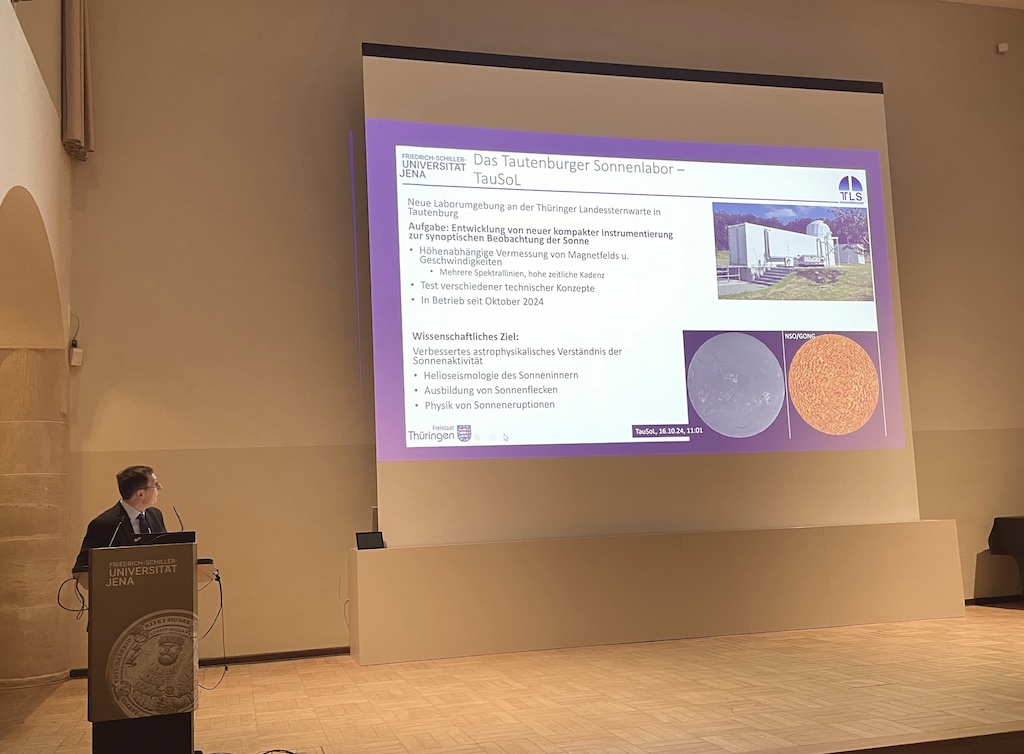 Markus Roth describes the research goals of the Tautenburg Solar Lab Markus Roth describes the research goals of the Tautenburg Solar Lab |
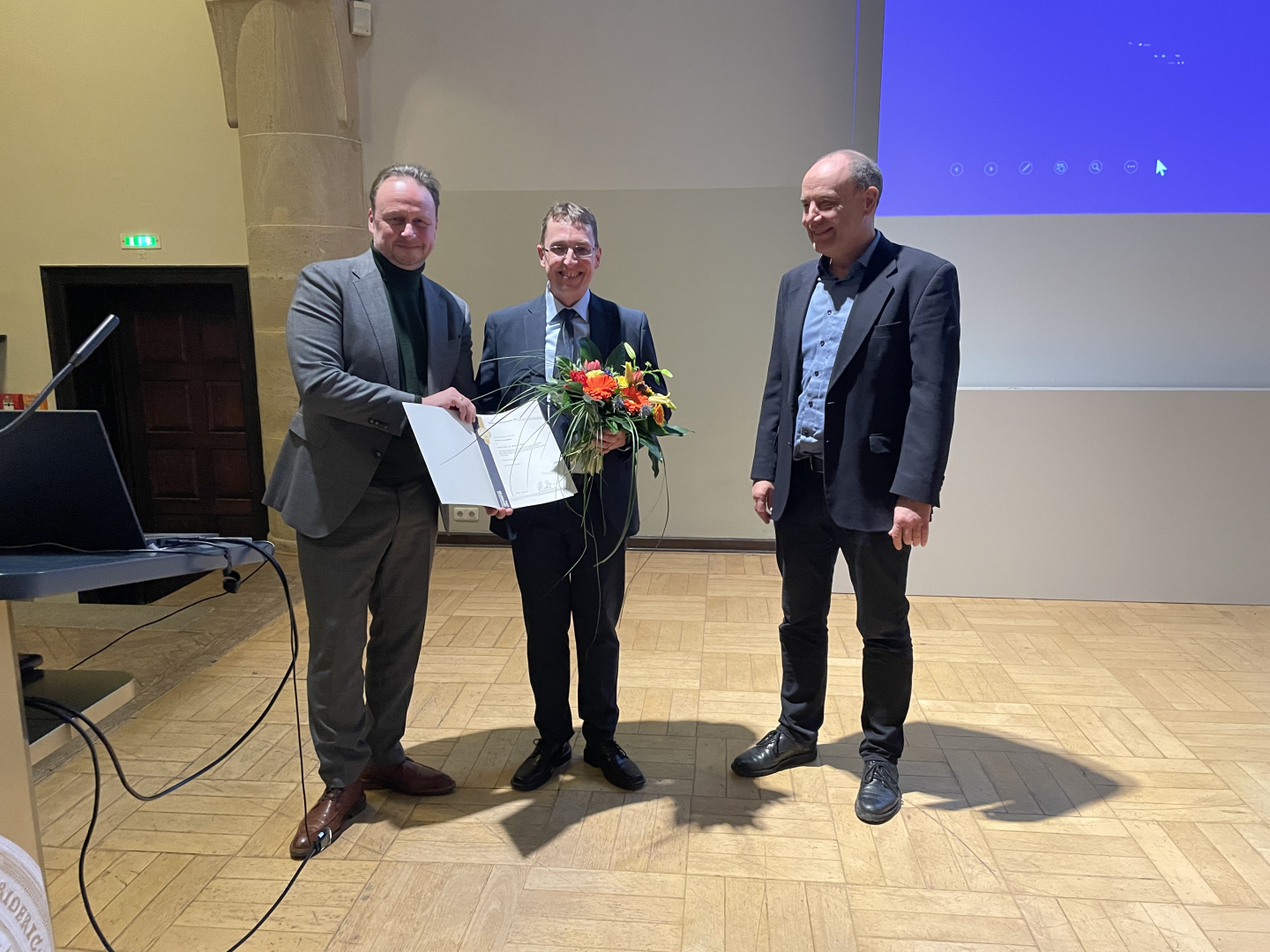 Professor Dr. Andreas Marx, president of Friedrich-Schiller-University, Professor Dr. Markus Roth, director Thuringian State Observatory, and Universitäts-Professor Dr. Ulf Peschel, Dean of the Physics and Astronomy Department at Friedrich-Schiller-University Professor Dr. Andreas Marx, president of Friedrich-Schiller-University, Professor Dr. Markus Roth, director Thuringian State Observatory, and Universitäts-Professor Dr. Ulf Peschel, Dean of the Physics and Astronomy Department at Friedrich-Schiller-University |
Extreme winds measured on planet outside our Solar System
21.01.2025
Astronomers at the Thuringian State Observatory have teamed up with international researchers and measured supersonic winds around the equator of WASP-127b, a giant exoplanet. These supersonic jets can reach speeds up to 33.000 kilometers per hour. The discovery provides unique insights into the weather patterns of a distant world.
Up until a few years ago, astronomers could only measure the mass and the radius of extrasolar planets (planets around other stars than our Sun). Now, high-resolution instruments like CRIRES+ at the European Southern Observatory's Very Large Telescope enable scientists to learn more about the dynamics of an exoplanet’s atmosphere.
A team of astronomers, led by Dr. Lisa Nortmann at Georg-August-Universität in Göttingen, studied the atmosphere of the exoplanet WASP-127b using high-resolution infrared spectroscopy. WASP-127b is a type of exoplanet known as a "hot Jupiter" due to its large size and close orbit around its host star. The giant gas planet is slightly larger than Jupiter, but only has a fraction of its mass. Its host star WASP-127 is located over 500 light-years away from Earth.
The planet cannot be observed directly because it is too far away, and the star shines too bright. To find out more about the planet’s atmosphere, the team used an indirect approach: When the planet transits in front of its star, the light of the star travels through the planet's upper atmosphere. The planet's atmosphere blocks certain parts of the star light. Researchers can learn more about the atmosphere based on which parts of the star light are blocked.
Supersonic Winds around the Planet's Equator
The team detected water vapor (H₂O) and carbon monoxide (CO). The speed of the molecules in the atmosphere can be measured. To their big surprise, the researchers have detected two opposing velocity signals. One part of the atmosphere is moving toward the observers at an astonishing speed of nine kilometers per second (almost 33.000 kilometers per hour), while another part is moving away from the observers at the same speed.
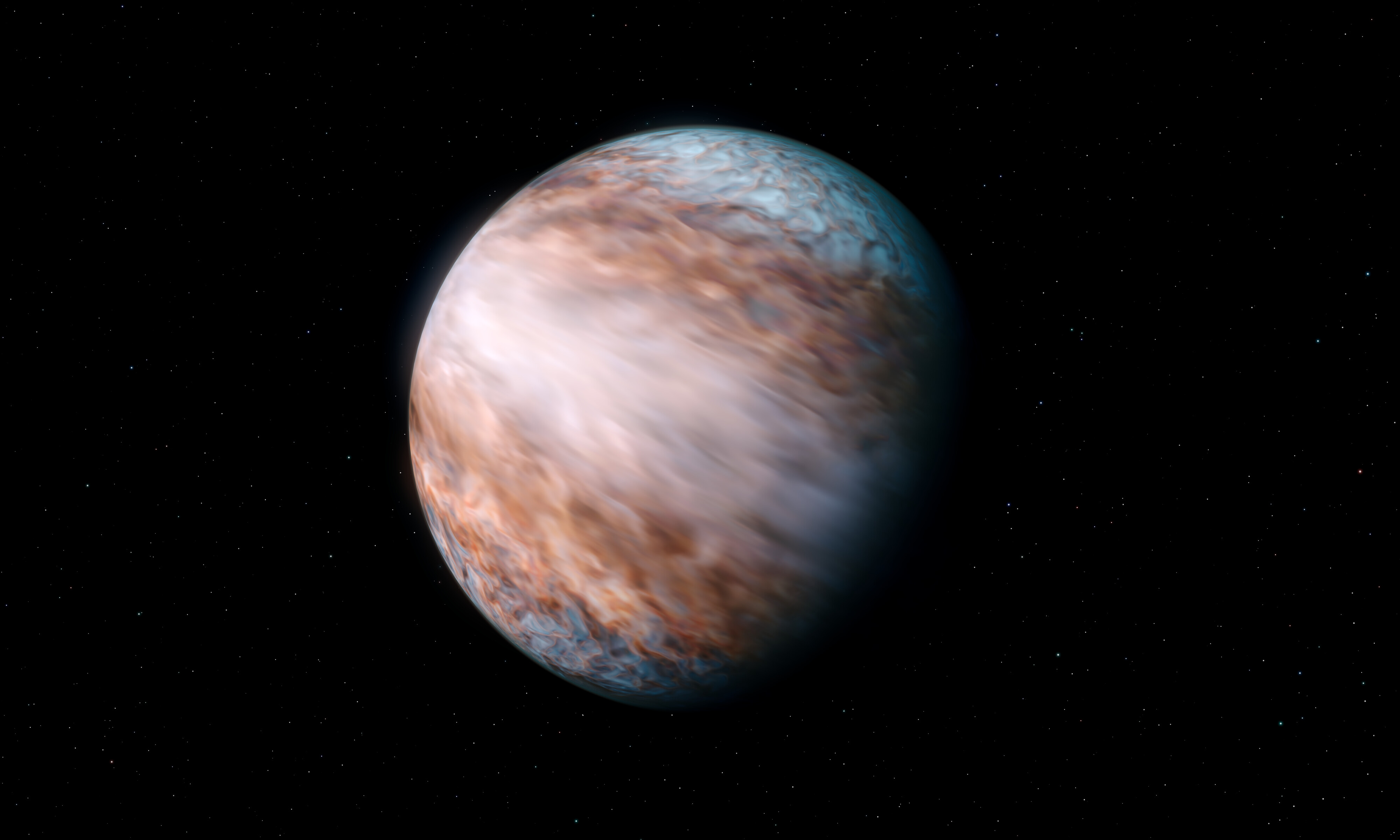 Astronomers have measured supersonic jet winds on WASP-127b, a giant gas planet located about 520 light-years from Earth. Credit: ESOThe researchers conclude that extremely strong winds circulate at supersonic speed at the equator of the exoplanet WASP-127b. The equatorial jet wind moves nearly six times as fast as the planet rotates. “This is something we haven’t seen before,” Lisa Nortmann, lead author of the study, points out.
Astronomers have measured supersonic jet winds on WASP-127b, a giant gas planet located about 520 light-years from Earth. Credit: ESOThe researchers conclude that extremely strong winds circulate at supersonic speed at the equator of the exoplanet WASP-127b. The equatorial jet wind moves nearly six times as fast as the planet rotates. “This is something we haven’t seen before,” Lisa Nortmann, lead author of the study, points out.
The extreme wind speeds and the clearly separated signals enable the astronomers to analyze different regions separately. The atmosphere is slightly hotter where the jet stream moves from the bright to the dark side of the planet in comparison to the opposite side (where the jet stream enters the bright side coming from the dark side). There are also differences between the equator and the poles. Since there are no strong signals from the poles, it can be assumed that the climate is colder there.
Distant stars and their planets are observed as point sources while planets in our Solar System can be observed with spatial resolution. "It is exciting to be able to detect differences in various regions of an exoplanet inspite the missing spatial resolution," Nortmann explains the novelty of the results.
A better understanding of weather on distant worlds
Artie Hatzes, scientist at the Thuringian state observatory, is part of the research team and lead the consortium that built the CRIRES+ instrument. He is very content that the high-resolution spectrograph provides such amazing results. „It is great that CRIRES+ at the European Southern Observatory's Very Large Telescope can detect such details in the atmosphere of extrasolar planets. Our understanding of these distant worlds is growing. The results complement observations made with space telescopes". Currently, such research can only be done with ground-based observatories because the instruments on satellite telescopes do not have the necessary velocity precision.
These measurements are a good basis for further research into exoplanet atmospheres. “The detailed mapping of the atmosphere of WASP-127b offers the opportunity to test theoretical circulation models,” Nortmann emphasizes. WASP-127b, with its unique atmospheric characteristics and rapid winds, provides a fascinating case study of atmospheric dynamics on planets far beyond our solar system.
More Information
The research was presented in the paper „CRIRES+ Transmission Spectroscopy of WASP-127b: Detection of Resolved Signatures of a Supersonic Equatorial Jet and Cool Poles in a Hot Planet“ , published today in „Astronomy & Astrophysics“.
* The team is composed of Lisa Nortmann (Institut für Astrophysik und Geophysik, Georg-August-Universität, Göttingen, Germany [IAG]), Fabio Lesjak (IAG), Fei Yan (Department of Astronomy, University of Science and Technology of China, Hefei, China), David Cont (Universitäts-Sternwarte, Fakultät für Physik, Ludwig-Maximilians-Universität München, Germany; Exzellenzcluster Origins, Garching, Germany), Stefan Czesla (Thüringer Landessternwarte Tautenburg, Germany [TLS]), Alexis Lavail (Institut de Recherche en Astrophysique et Planétologie, Université de Toulouse, France), Adam D. Rains (Department of Physics and Astronomy, Uppsala University, Sweden [Uppsala University]), Evangelos Nagel (IAG), Linn Boldt-Christmas (Uppsala University), Artie Hatzes (TLS), Ansgar Reiners (IAG), Nikolai Piskunov (Uppsala University), Oleg Kochukhov (Uppsala University), Ulrike Heiter (Uppsala University), Denis Shulyak (Instituto de Astrofísica de Andalucía, Glorieta de la Astronomía, Spain), Miriam Rengel (Max-Planck-Institut für Sonnensystemforschung, Göttingen, Germany), and Ulf Seemann (European Southern Observatory, Garching, Germany).
Additional Links:
NASA-Webseite: Details about the extrasolar planet WASP-127b
Press release European Southern Observatory (with video and images)
Contact:
Prof. Dr. Artie Hatzes
Thüringer Landessternwarte
Sternwarte 5
07778 Tautenburg
Dr. Lisa Nortmann
Georg-August-Universität Göttingen
Tel: +49 1515 119 54 35
A Tiny Telescope for the Thuringian State Observatory
19.12.2024
Young visitors enthusiastically surrounded the world's largest plug-in building block model of the Alfred Jensch Telescope during the Long Night of Stars 2024 . On that day, it was presented to the public for the first time. The model offers the opportunity to explain to children (and their parents) how the optical telescope works.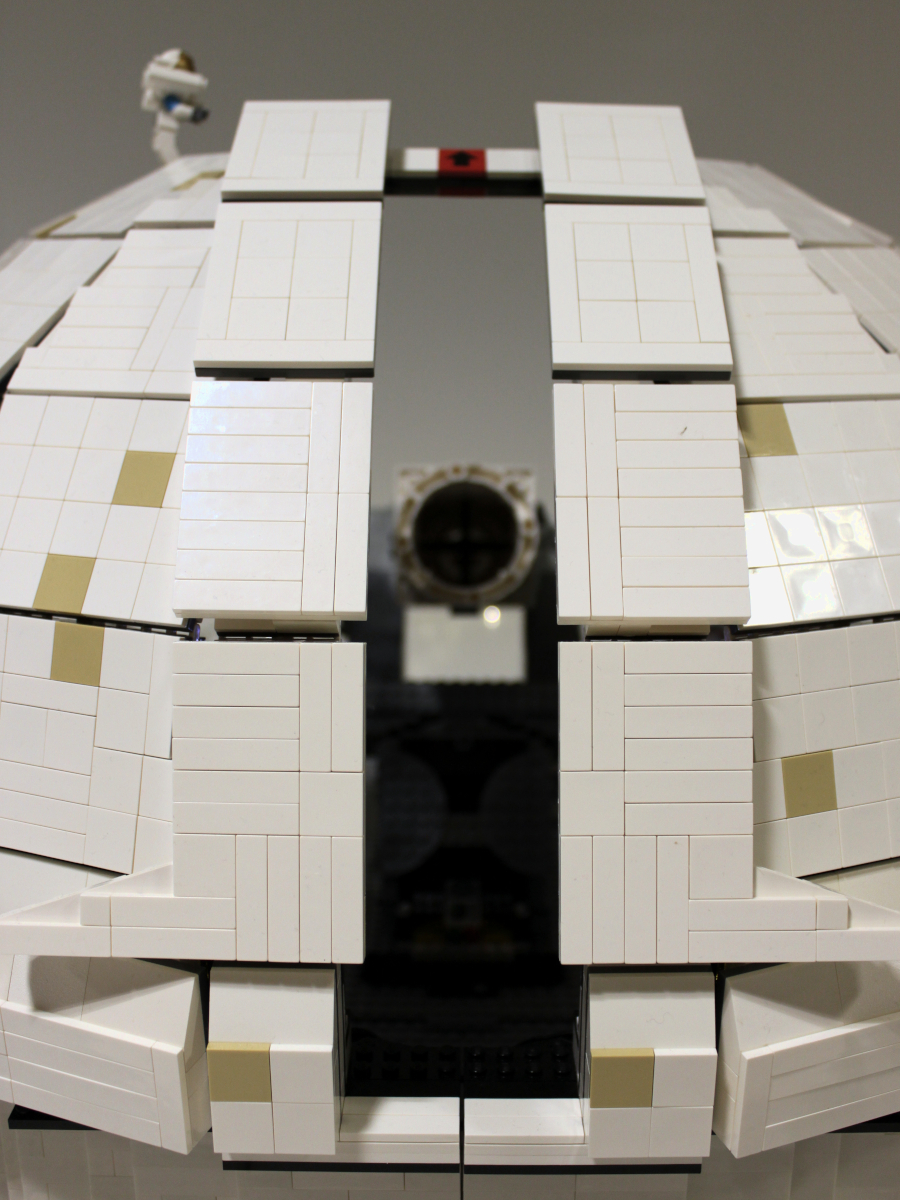 The Tautenburg Tiny Telescope in the opened model dome. Foto: TLS
The Tautenburg Tiny Telescope in the opened model dome. Foto: TLS
Dr. Thomas Sperling und Dr. Christian Andreas, both researchers at the Thuringian State Observatory, completed the brick model in their spare time in around six months with a great deal of dedication. They built a true-to-scale replica of the Alfred Jensch telescope, half of the dome roof and the observation platform which was used for observations in the past. Sperling and Andreas gave the 50-centimetre-high model the name "Tautenburg Tiny Telescope".
It was important to the two scientists to integrate basic functions, such as the movement of the telescope around two axes. "This was ultimately a key requirement for our project. We hope that it will also get the younger generation interested in our work and in astronomy," Sperling said. Originally, the idea was to simply replicate the telescope. Gradually, however, further details - such as the wooden observation platform, part of the dome structure and the TES telescope ("Tautenburg Exoplanet Search Telescope”) were added.
A total of around 4,000 individual parts installed
There was no building plan. "We initially based it on the size of classic LEGO® figures, which also explains the 1:45 scale. We then expanded the model piece by piece using old construction plans and floor plans," Andreas described the process. In total, around 4,000 individual parts were gradually added.
Movable in two directions
Mounting the telescope was a particular challenge. In order for an optical telescope to observe a celestial object - such as a star - throughout the night, two axes of movement are required: from north to south and from east to west in relation to the celestial poles and the celestial equator. "You can think of it like longitude and latitude lines in the night sky", Sperling explained.
For smooth tracking in the sky, the telescope's center of gravity must also be as close to these axes as possible . "You can compare it to a seesaw", Andreas added: "If you want to bob up and down really quickly, the children have to find exactly the right distance from each other so that the weights on both sides compensate for each other".
The Alfred Jensch telescope was designed in such a way that the weight of the telescope tube is balanced along one axis by the mirror, which weighs more than two tons. In the model, around 800 grams of lead plates had to be hidden behind the plastic mirror for this purpose.
Trial and Error - just like in research
The two astronomers had to work hard, but were rewarded with an "extragalactic fun factor", Sperling said. He added: "Of course, we benefited from the fact that we have been enthusiastic about LEGO® since we were children. And the approach was not so different from our scientific work. Even in basic research, it often starts with just an idea. The path to results is then more a matter of trial and error, sometimes accompanied by setbacks, similar to the search for the exit from a labyrinth".
The positive response from the public, young and old, during the Long Night of the Stars shows that the effort was worth it. The two builders permanently handed over the model to the observatory on November 5, 2024, in the presence of the institute's director, Prof. Dr. Markus Roth. It can now also be viewed as part of guided tours of the institute. If you look closely, you may discover other nocturnal superheroes in the model alongside busy astronomers.
Free guided tours of the institute for individuals take place on the first Thursday of each month at 4 pm at the Thuringian State Observatory and last around 45 minutes. Registration is not required.
Author: Christian Andreas
Note: LEGO® is a trademark of the LEGO Group. This website is not sponsored, authorized or endorsed by the LEGO Group.
 A detail in the model of the Alfred Jensch Telescope. Foto: TLS A detail in the model of the Alfred Jensch Telescope. Foto: TLS |
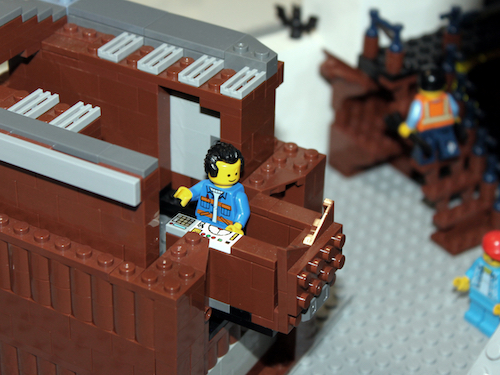 The observation desk, located in the dome, as a model. Foto: TLS The observation desk, located in the dome, as a model. Foto: TLS |
The Thuringian State Observatory can now also observe the Southern Sky
16.12.2024
As part of an international consortium, the Thuringian State Observatory has put a new spectrograph into operation. This optical instrument is used to study the activity of stars and discover possible companions. The spectrograph was installed on the modernized 1.52-metre telescope of the European Southern Observatory in La Silla, Chile, in November 2024 and is ready for operation. This means that the Thuringian State Observatory now also has an observation instrument for the night sky of the southern hemisphere.
With the new “PLATOSpec” spectrograph on the 1.52-metre telescope of the European Southern Observatory (ESO) in La Silla, Chile, researchers at the Thuringian State Observatory can observe stars in the southern night sky. The telescope was built in the 1960s and has been given new life.
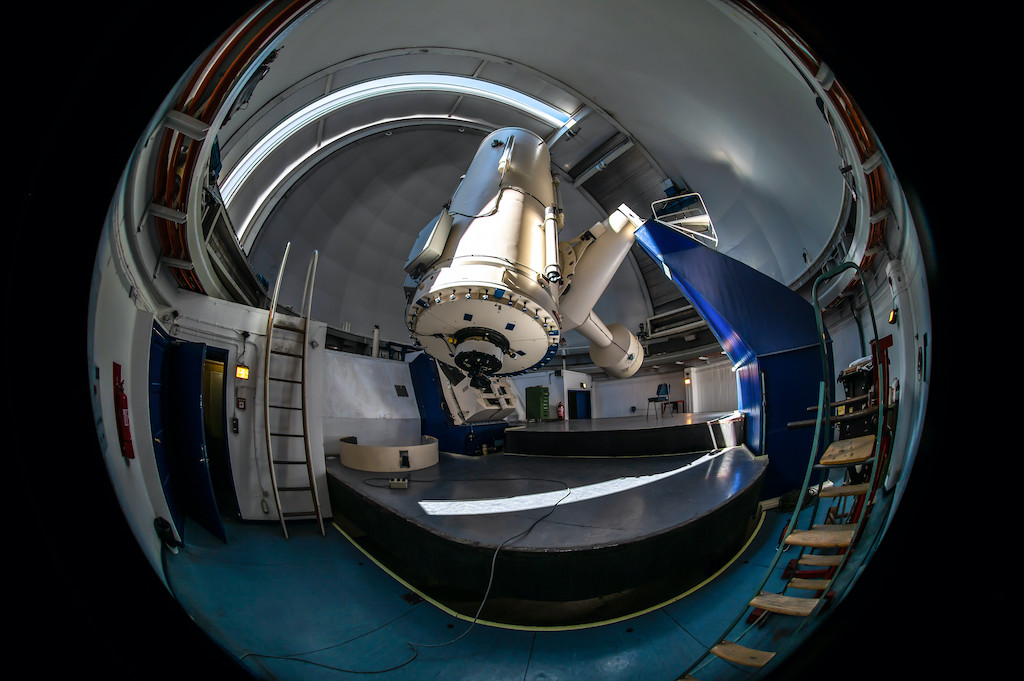 The modernized 1,52-Metre-Telescope at the ESO La Silla Observatory in Chile. Credit: Zdeněk Bardon/ESOThe Thuringian State Observatory is part of a consortium that had the idea of modernizing the telescope and equipping it with a new spectrograph. After just under two years of construction, the spectrograph was connected to the modernized telescope and tested in November 2024. It is now ready for scientific research.
The modernized 1,52-Metre-Telescope at the ESO La Silla Observatory in Chile. Credit: Zdeněk Bardon/ESOThe Thuringian State Observatory is part of a consortium that had the idea of modernizing the telescope and equipping it with a new spectrograph. After just under two years of construction, the spectrograph was connected to the modernized telescope and tested in November 2024. It is now ready for scientific research.
As part of the modernization the telescope and the spectrograph can be operated remotely. An observation room was set up at the Thuringian State Observatory specifically for this purpose. Markus Roth, Director of the Thuringian State Observatory, explains why this instrumentation project is important for research in Thuringia: “PLATOSpec enables us to observe stars in the southern night sky from Tautenburg and to participate in major international research projects.”
The tasks of the new spectrograph
The new high-resolution spectrograph “PLATOSpec” is a versatile research instrument. It was specially developed to better investigate the magnetic activity of stars. Its main task is to support the European Space Agency's PLATO satellite telescope with observations from Earth. PLATOSpec will characterize stars with planets and search for other planets. The PLATO satellite telescope is due to be launched in 2026 and will initially observe millions of stars in the southern night sky.
These stars will be further examined with telescopes on Earth: How strong is their magnetic activity? Do they possibly have a companion, for example one or more planets orbiting around them? How big is the mass of these planets? PLATOSpec's task is to vet stars: stars that potentially could have Earth-like planets are identified so that they can then be further observed with a large telescope such as ESO's Very Large Telescope (VLT).
An international project
 The various components of the PLATO Spec instrument on the ESO 1.52-m telescope. Credit: Leonardo VanziThe consortium partners who modernized the 1,52-metre-telescope, financed and built the spectrograph PLATOSpec are the Astronomical Institute of the Czech Academy of Sciences (responsible for the telescope modernisation and front end), the German Thuringian State Observatory Tautenburg (calibration unit), the Pontificia Universidad Católica de Chile (spectrograph). The research funding of the Free State of Thuriniga financed the share of the Thuringian State Observatory in the PLATOSpec project.
The various components of the PLATO Spec instrument on the ESO 1.52-m telescope. Credit: Leonardo VanziThe consortium partners who modernized the 1,52-metre-telescope, financed and built the spectrograph PLATOSpec are the Astronomical Institute of the Czech Academy of Sciences (responsible for the telescope modernisation and front end), the German Thuringian State Observatory Tautenburg (calibration unit), the Pontificia Universidad Católica de Chile (spectrograph). The research funding of the Free State of Thuriniga financed the share of the Thuringian State Observatory in the PLATOSpec project.
The workshops of the Thuringian State Observatory have developed, built and tested the calibration unit for the PLATOSpec spectrograph. The calibration unit serves as a reference point for the spectra recorded with the telescope. It was installed on the telescope at the end of March 2024 together with a new front end. The front end connects the spectrograph to the telescope. It was also commissioned by the Thuringian State Observatory and financed by the Free State of Thuringia.
Eike Guenther, astronomer at the Thuringian State Observatory, helped plan the project and accompanied the commissioning of PLATOSpec at ESO's La Silla Observatory in Chile: “With PLATOSpec and the modernized telescope, the Thuringian State Observatory now has the opportunity to observe stars at one of the best astronomical locations in the world. I am delighted that we can make an important contribution to the PLATO satellite telescope with this instrument.”
Links
Machine Learning meets Astronomy in Tautenburg
06.12.2024
There are a lot of advantages (and a few disadvantages) to applying Machine Learning to astronomy data sets. Rok Hribar, expert in Machine Learning, visited the Thuringian State Observatory in November 2024 to get a few projects going.
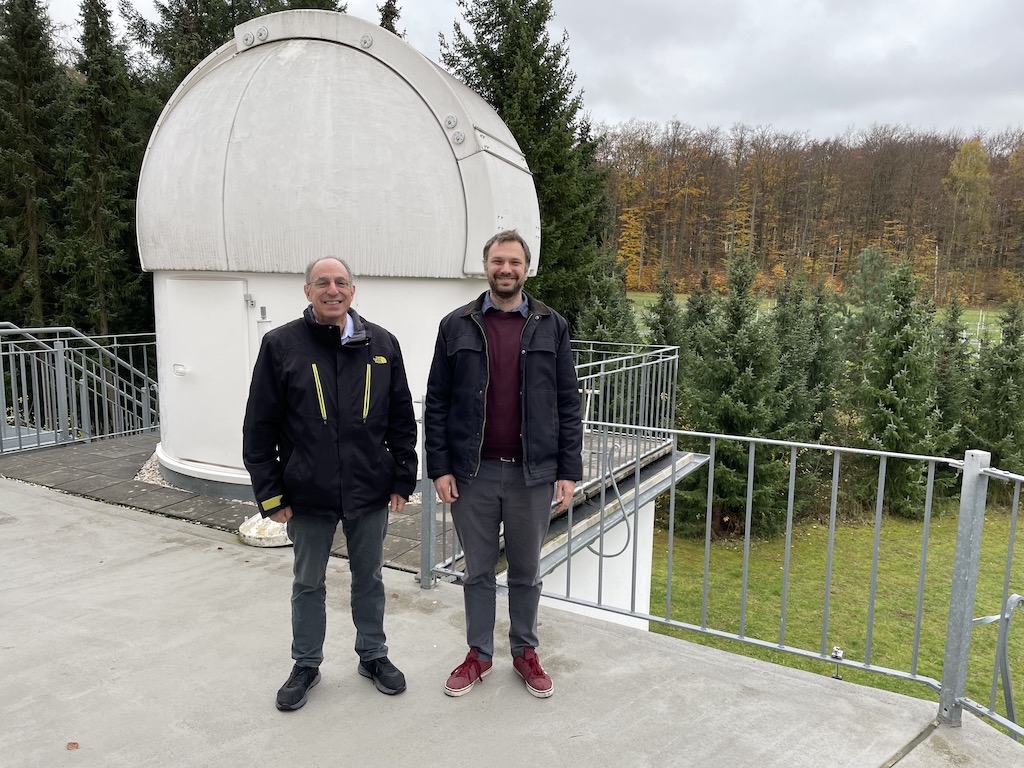 Artie Hatzes (left) and Rok Hribar at the Thuringian State Observatory. Photo: TLSHribar is a researcher at the Computer Systems Department at the Jožef Stefan Institute in Ljubljana, Slovenia. He currently spends a year at DLR (Deutsches Zentrum für Luft- und Raumfahrt) in Berlin as part of the EXOWORLD staff exchange program supported by the European Union. The Jožef Stefan Institute is the leading Slovenian scientific research institute, covering a broad spectrum of basic and applied research. Like the Thuringian State Observatory, it is part of the EXOWORLD consortium. Artie Hatzes, researcher at TLS, invited Rok Hribar to spend a week in Tautenburg to talk to astronomers about joint Machine Learning projects. “It is great to have the opportunity to collaborate with an expert in Machine Learning because there are many applications in Astronomy that profit from it,” Hatzes says.
Artie Hatzes (left) and Rok Hribar at the Thuringian State Observatory. Photo: TLSHribar is a researcher at the Computer Systems Department at the Jožef Stefan Institute in Ljubljana, Slovenia. He currently spends a year at DLR (Deutsches Zentrum für Luft- und Raumfahrt) in Berlin as part of the EXOWORLD staff exchange program supported by the European Union. The Jožef Stefan Institute is the leading Slovenian scientific research institute, covering a broad spectrum of basic and applied research. Like the Thuringian State Observatory, it is part of the EXOWORLD consortium. Artie Hatzes, researcher at TLS, invited Rok Hribar to spend a week in Tautenburg to talk to astronomers about joint Machine Learning projects. “It is great to have the opportunity to collaborate with an expert in Machine Learning because there are many applications in Astronomy that profit from it,” Hatzes says.
Automating the process of data reduction
Astronomers produce a lot of observational data. Ideally, Machine Learning can automate the process of reducing and analyzing this data – doing it much faster than people can ever do it. “With Machine Learning, we can model things that people cannot process because the data set is too big. Machine Learning also reduces manual labor,” Hribar emphasizes the advantages.
In his colloquium talk, the computer expert described how Machine Learning is applied to astronomical data sets. Hribar already started a few projects with astronomers at DLR in Berlin, at Rheinisches Institut für Umwelt-Forschung an der Universität Köln in Cologne, and at Universita degli Studi di Torino, Italy. These institutes are also part of the consortium “Understanding the evolution of EXOplanets and towards habitable WORLDs (EXOWORLD)”.
How to set up a Machine Learning project
Hribar explains that a Machine Learning project is always an iterative process. First, the astronomers tell him, what problem they want to solve. Before starting, it is essential to discuss the problem in depth with the astronomer. Hribar outlines how he tackles a problem: “It is always useful to understand the astronomical question very well because that influences which method we will apply.”
“Usually people already have ideas where Machine Learning can be applied,” Hribar says. At the beginning, he looks at the data set which is used to train the Machine Learning model. What properties does the data have? Which properties are most important to solve the problem?
A Trial-and-Error-Process
The next step is choosing the methodology. That means preparing the data and choosing the appropriate Machine Learning model. “Preparation of the data is 90 percent of the work,” Hribar points out. When a chosen model works satisfactorily, the data and the model are fine-tuned. This is a trial-and-error-process.
One disadvantage can be that Machine Learning can hide things, Hribar says: “Traditionally, when you use a software to reduce data, you understand what the software is doing. With Machine Learning you don’t really know what the model is doing”. Therefore, one big question still is: How trustworthy are the results?
In order to deal with this question, a step by step process is applied: “We see the intermediate results and can better understand what the model is doing or where it might be wrong,” Hribar describes the correction mechanism. Validating each step brings confidence that the results are trustworthy.
During his visit to Tautenburg, Rok Hribar started some projects with scientists at the Thuringian State Observatory that will be developed further. Hatzes thanks him for sharing his expertise: “I really appreciate that Rok Hribar took his time to visit the Thuringian State Observatory. The scientists here were very interested in talking to him about possible projects.”
Background Information
The EXOWORLD project that funds Hribar’s research stay at DLR in Berlin is supported by the European Union under the Horizon Europe Programme Marie Skłodowska-Curie Actions Staff Exchanges (Project ID: 101086149). “Understanding the evolution of EXOplanets and towards habitable WORLDs (EXOWORLD)” is a consortium that comprises 12 organisations from eight countries. It leverages interdisciplinary and international expertise to study the diversity of exoplanets.
Radio astronomers meet for a workshop at the Thuringian State Observatory
19.11.2024
Around twenty scientists from the Max Planck Institute for Radio Astronomy (MPIfR) and the Thuringian State Observatory met for a workshop in Tautenburg at the end of October 2024. The two astronomy institutes are working together to analyze data obtained when measuring the galactic plane with the MeerKAT radio telescope in South Africa. During the workshop in Tautenburg, the scientists discussed the current status of the data analysis. They also prepared the first scientific studies of the ongoing survey.
MeerKAT radio telescope: a new view of the galactic plane
The MeerKAT radio telescope is used, among other things, for sky surveys of the Milky Way. One of the surveys was led by South African scientists. The data has already been published (SMGPS, SARAO MeerKAT Galactic Plane Survey). A complementary project, led by scientists from the Max Planck Institute for Radio Astronomy in Bonn, has the primary goal of searching for and investigating pulsars in the Milky Way.
A mapping of the southern part of the Milky Way and the center of the Milky Way turns out to be by-product of the survey. The collaboration between the MPIfR and TLS aims to analyze the recorded data in order to learn more about objects that can be observed in the Milky Way with radio telescopes. In particular, these are regions where new stars have recently formed or are currently forming (star forming regions) and the remnants of stars that have reached the end of their evolution with an explosion (supernova remnants). In addition, outer shells that stars 'shed' during their development are also observed, as well as mysterious line-like structures that are thought to make the magnetic fields in the Milky Way visible.
Three different frequency bands provide three different “colors”
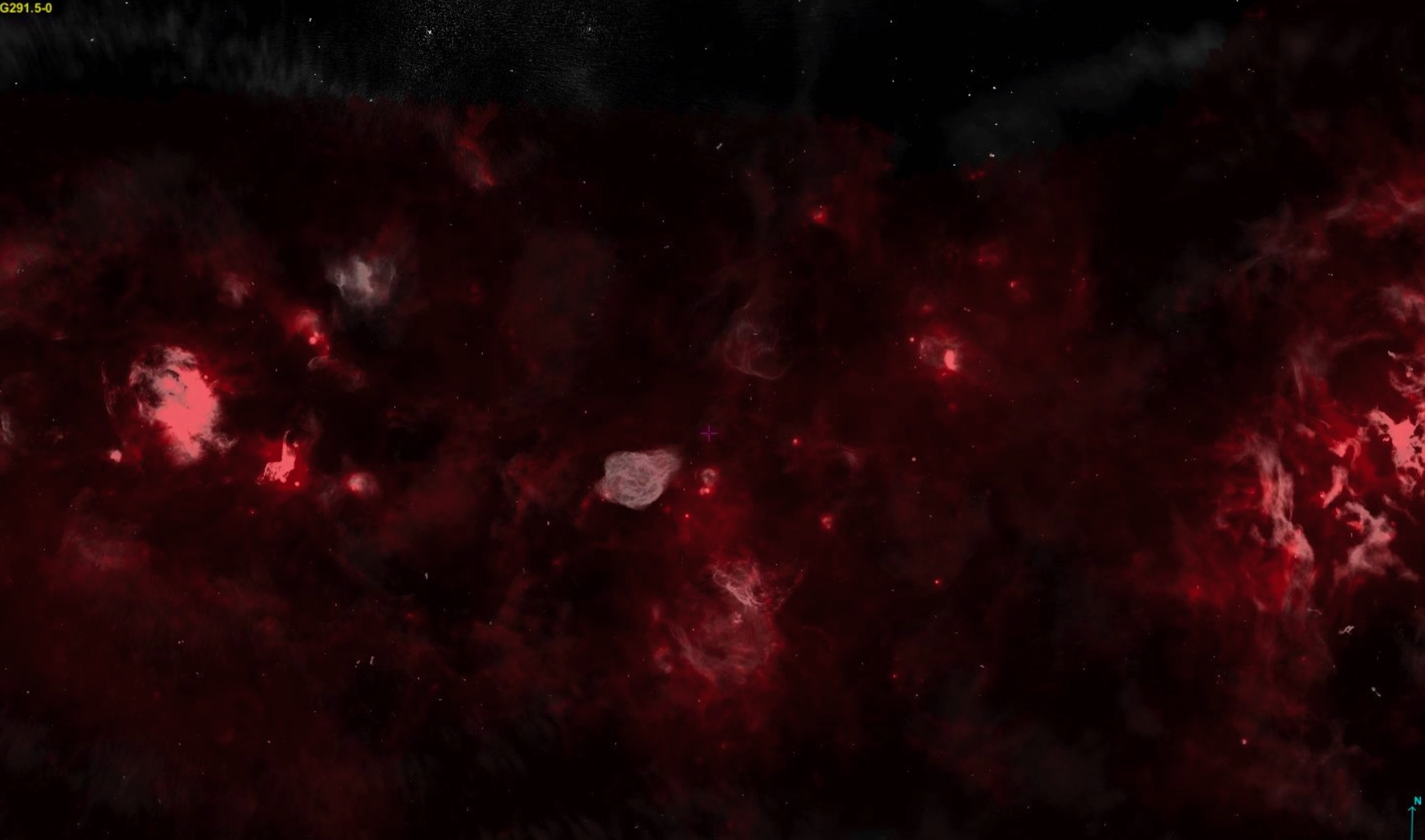 An observation of the galactic plane with the radio telescope MeerKAT and the WISE survey (Infrared light). Photo: Albert GenestThe survey is still ongoing. In total, the MeerKAT telescope will map the southern Milky Way with 3,000 hours of telescope time as part of the MMGPS (MeerKAT Galactic Plane Survey). The special feature of this mapping is that three different frequency bands are used, which are like “colors” for radio telescopes. The receivers for one of the “colors” were developed at the Max Planck Institute for Radio Astronomy. This multi-colored mapping of the galactic plane is unique and provides a wealth of information. At the workshop in Tautenburg, the current status of the survey and initial results were presented. The scientists also discussed the next steps in the analysis.
An observation of the galactic plane with the radio telescope MeerKAT and the WISE survey (Infrared light). Photo: Albert GenestThe survey is still ongoing. In total, the MeerKAT telescope will map the southern Milky Way with 3,000 hours of telescope time as part of the MMGPS (MeerKAT Galactic Plane Survey). The special feature of this mapping is that three different frequency bands are used, which are like “colors” for radio telescopes. The receivers for one of the “colors” were developed at the Max Planck Institute for Radio Astronomy. This multi-colored mapping of the galactic plane is unique and provides a wealth of information. At the workshop in Tautenburg, the current status of the survey and initial results were presented. The scientists also discussed the next steps in the analysis.
Of Black Holes and Cosmic Collisions: The Long Night of Sciences in Jena
30.10.2024
The "Long Night of Sciences" will take place in Jena on November 22, 2024. The Thuringian State Observatory participates with talks about astronomical topics and a live observation of the radio sky.
Do you want to hear how stars sound? Or what happens when stars explode? Then join us for our talks during the Long Night of Sciences in Jena. Astronomers from the Thuringian State Observatory will give exciting insights into interesting astronomical events. The talks start every hour and will last about 45 Minutes.
Address: Helmholtzweg 5, Jena, Lecture Room 2 (Hörsaal 2).
The Long Night of Sciences in Jena is on November 22, 2024, between 6 and 12 pm.
On the ground floor of the building at Helmholtzweg 5, we show live observations of the radio sky, observed with our radio telescope LOFAR in Tautenburg.
Find more information and updates of the program on this website.
The programm:
| When? | Topic: | Speaker: |
| 18:00 – 18:45 h | Kosmische Gamma-Ray Bursts - spektakuläre Sternexplosionen im Weltall | Sylvio Klose |
| 19:00 – 19:45 h | Die Sonne – der Stern, mit dem wir leben | Markus Roth |
| 20:00 – 20:45 h | Sterngeschwister | Veronika Schaffenroth |
| 21:00 – 21:45 h | Von Schwarzen Löchern und Kosmischen Kollisionen | Matthias Hoeft |
| 22:00 – 22:45 h | The Sound of Stars (in English) | Aashana Tripathi |
| 23:00 – 23:45 h | Der Himmel in Radiowellen: Galaxien am Ende des Universums | Heinz Andernach |
Long Night of the Stars: The night sky is the biggest show
28.10.2024
A sky full of stars, live observations with the radio and reflector telescopes and the guest appearance of a comet: The Long Night of the Stars offered the visitors many highlights.
The guests were welcomed with astronomical knowledge. The program for the Long Night of Stars informed them that sunset on October 26th, 2024 was at 5.58 pm. At 7.10 pm, the sun was 12 degrees below the horizon. That was the end of the nautical twilight, individual stars appeared. At 7.49 pm, the sun was 18 degrees below the horizon. Then it was completely dark and the starry sky became visible. In front of the open dome Photo: TLS
In front of the open dome Photo: TLS
Every half hour there were tours presenting and explaining the 2 meter telescope. The first three tours were aimed specifically at the younger audience. There was a great rush of visitors - when can you see a 2 meter telescope in action? At dusk, the dome was opened. Visitors were able to take part in a live observation with the 2 meter Alfred-Jensch-Telescope.
The coordinates of the target object are set with the help of a computer program. The telescope moves to this position with a quiet whirring sound and the dome with the open slit rotates with it. The exposure time depends on the object. For the demonstrations, the image was then projected onto a large screen.
 The comet C/2023 A3 Tsuchinshan-ATLAS viewed with the 2 meter telescope. Photo: TLSMany visitors wanted to take a look at the comet C/2023 A3 Tsuchinshan-ATLAS. It was visible in the west after sunset until around 9 pm. However, it was difficult to catch with the naked eye and even with binoculars, as it was already too faint. But when the 2 meter Alfred Jensch telescope with its particularly large field of view and light-sensitive CCD camera brought the comet into view for the public, it was a real “wow” moment.
The comet C/2023 A3 Tsuchinshan-ATLAS viewed with the 2 meter telescope. Photo: TLSMany visitors wanted to take a look at the comet C/2023 A3 Tsuchinshan-ATLAS. It was visible in the west after sunset until around 9 pm. However, it was difficult to catch with the naked eye and even with binoculars, as it was already too faint. But when the 2 meter Alfred Jensch telescope with its particularly large field of view and light-sensitive CCD camera brought the comet into view for the public, it was a real “wow” moment.
The observatory had set up smaller telescopes on the meadow next to the new Tautenburg solar laboratory with the support of members of the Volkssternwarte Urania Jena e.V.. Visitors were able to use them to observe the stars for themselves. The planet Saturn shone in the night sky after 7 pm and Jupiter after 10 pm. As the weather was exceptionally good for the time of year and the night sky was relatively clear, the small telescopes were very busy until the end of the event.
There were even more highlights for the young audience: An entertaining and exciting book presentation of “Bastian oder Wie man aus einer Ente eine Rakete baut” by Svenja and Nils Kretschmer. This was so popular that Svenja and Nils Kretschmer did additional readings. The true-to-scale model of the 2-meter mirror telescope and the dome made of building blocks was also surrounded by children all evening. Using the model, the master builders were able to explain how the (real) telescope works and how it can be converted from Schmidt to Coude mode.
The astronomers showed the clearly visible constellations in the night sky outside. Inside, in the research building, they reported on their work. Markus Roth, Director of the Thuringian State Observatory, is delighted with the great interest in astronomical research in Tautenburg: “Around 1,400 visitors came to the Thuringian State Observatory for the Long Night of the Stars. We would like to thank them for coming and for their patience and understanding when it sometimes took a little longer before they could take a look through the telescopes.”
In June 2025 at the latest, the next exciting lectures on astronomy and guided tours will take place during the “Open Day”. The Thurinigian State Observatory also welcomes visitors for Guided Tours on every first Thursday of the month at 4 pm.
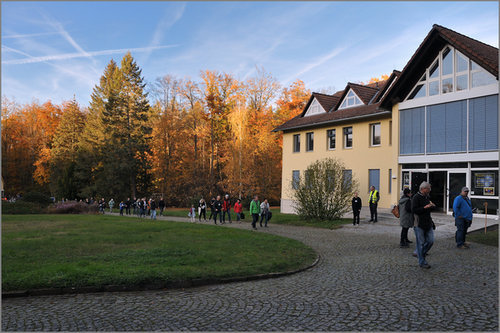 Visitors on their way to the telescopes. Photo: TLS Visitors on their way to the telescopes. Photo: TLS |
 Alexander Drabent explains observations with the radio telescope LOFAR. Photo: TLS Alexander Drabent explains observations with the radio telescope LOFAR. Photo: TLS |
 Live observations with the 2 meter telescope. Photo: TLS Live observations with the 2 meter telescope. Photo: TLS |
 Svenja und Nils Kretschmer read from their book „Bastian oder Wie man aus einer Ente eine Rakete baut“. Photo: TLS Svenja und Nils Kretschmer read from their book „Bastian oder Wie man aus einer Ente eine Rakete baut“. Photo: TLS |
Program of the Long Night of the Stars on October 26 2024
23.10.2024
On October 26th, 2024, the Thuringian State Observatory invites the public to the "Long Night of the Stars". The observatory in the Tautenburg Forest can be visited between 5 pm and midnight. We will be observing the night sky, explain constellations and talk about our scientific projects. There will be special events for children.
If the weather permits, observations of the night sky with our 2 Meter telescope can be experienced live. Every half and full hour a demonstration will be given in the dome where live-observations with the telescope will be performed and projected onto the dome.
Free tickets should be obtained at the entrance of the observatory
The entrance to the observatory is free. Group size to visit the dome with its 2 meter telescope is limited to 70 visitors at the same time due to limited space. In order to avoid that too many people are in the dome at the same time, tickets to visit the dome will be handed out in front of the dome.
Tours for kids
We will offer three tours for children: at 5.30 pm, 6 pm and 6.30 pm
Children's Book presentation
Nils and Svenja Kretschmer will read from their book "Bastian - oder Wie man aus einer Ente eine Rakete baut".
Where? First floor of the Neubau
When? at 6 pm, 6.30 pm and 7 pm
Star Party - admire constellations in the night sky
In collaborations with the Urania-Observatory Jena, it will also be possible to look at the night sky directly with small telescopes. Observations will be possible starting at 7 pm. Enjoy the very dark night sky at the observatory in Tautenburg - something that is hard to find in our cities.
At 8 pm, 9 pm and 10 pm the stellar constellations will be explained.
To make sure everyone gets a beautiful view of the stars, we will be avoiding artificial light. The roads will be illuminated weakly with glow sticks. The moon will not be visible during this night and will not brighten up the sky.
A special highlight will be the observation of the comet Tsuchinshan-ATLAS (C/2023 A3). The comet will be visible after sun set, if the weather permits.
A station of the LOFAR-radio telescope is located on the grounds of the observatory . We will explain how it works and introduce people to the science, which is done with it.
In the main building, visitors can listen to talks: Astronomers will talk about their current scientific projects, research methods and results.
|
Time |
Talk (in German) |
Speaker |
|
17:30 |
Comets (if the weather permits, the comet Tsuchinshan-ATLAS can be observed after the talk) |
Dr. Jochen Eislöffel |
|
18:30 |
Giant-radio galaxies, the largets objects in the universe |
Prof. Dr. Heinz Andernach |
|
19:30 |
Star sibblings |
Dr. Veronika Schaffenroth |
|
20:30 |
Are there black holes? |
Prof. Dr. Markus Roth |
|
21:30 |
How young stars are growing - accretion outbursts explained |
Dr. Verena Wolf |
|
22:30 |
Extrasolar planets - the strange sibblings of the Earth |
Dr. Eike W. Guenther |
A few practical details:
Unfortunately, the dome and the grounds are not barrier free!
Please dress in warm clothes, as most of the event takes place outdoors, and it can already be quite cold at the end of October.
To warm up again after observing the stars, there will be the possibility to buy food and drinks on the grounds of the observatory.
The entrance to the Long Night of the Stars is free, a reservation is not necessary.
We are looking forward to your visit on October 26th, 2024, starting at 5 pm.
The Thuringian State Observatory starts observing the sun
17.10.2024
After just two years of development and construction, the Thuringian State Observatory now has a modern solar laboratory. Guests from politics, research and industry will come to Tautenburg for the inaugural ceremony on October 17, 2024.
The Thuringian State Observatory has a new observation facility. The light of the sun is studied in the Tautenburg Solar Laboratory (TauSoL) in order to better understand its magnetic cycle. The laboratory is also used to develop a prototype for automated solar observatories. Their data will contribute to explore the interior of the sun.
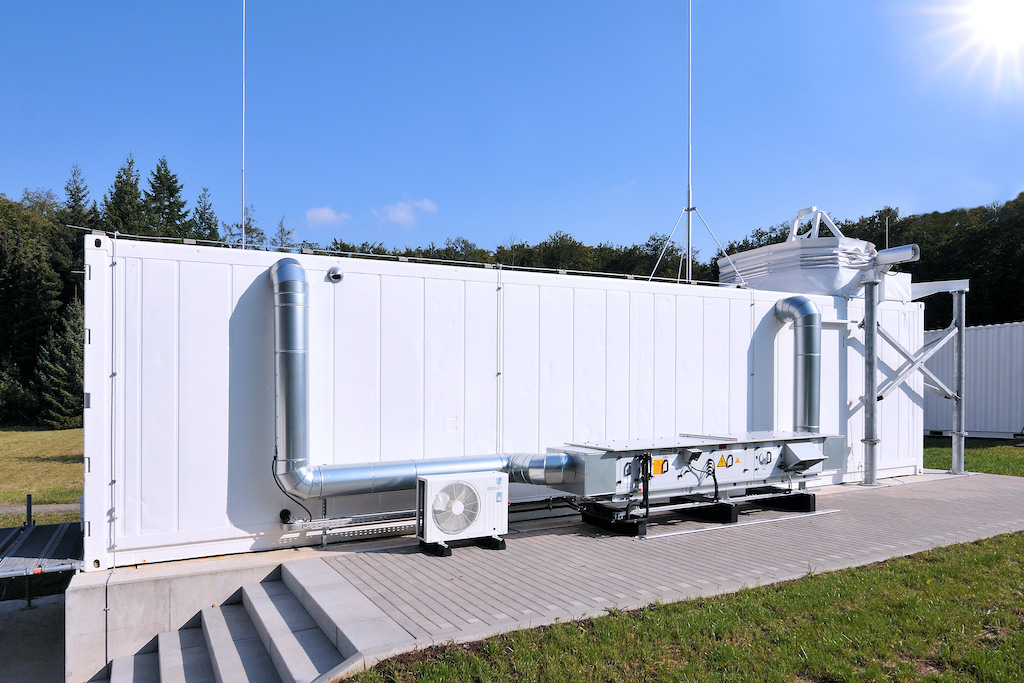 The Tautenburg Solar Laboratory (TauSoL) with the heliostat on the roof. Photo: TLSThe Tautenburg Solar Laboratory is housed in an air-conditioned container twelve meters long and almost 2.5 meters wide. A heliostat is installed on the roof of the container. It is protected from the weather by a foldable dome when no observations are being made.
The Tautenburg Solar Laboratory (TauSoL) with the heliostat on the roof. Photo: TLSThe Tautenburg Solar Laboratory is housed in an air-conditioned container twelve meters long and almost 2.5 meters wide. A heliostat is installed on the roof of the container. It is protected from the weather by a foldable dome when no observations are being made.
An image of the entire visible solar disk
A heliostat is a special two-mirror system that continuously guides sunlight into the interior of the container through an opening in the roof. One mirror of the heliostat automatically tracks the sun, while the other, fixed mirror, directs the light vertically downwards into the container. There, the light hits a permanently installed telescope, which produces an image of the entire visible solar disk.
A stable table for optical setups is installed in the container. The table's feet have their own foundation so that no vibrations can be transmitted via the container to the sensitive measurement setup. The scientists at the Thuringian State Observatory will carry out various tests with telescopes and spectrometers in this optics laboratory. They will develop an ideal instrument for spectral and polarimetric analysis of the entire visible sun.
The solar laboratory will be used to research the sun's magnetic cycle. The first step is to build a two-dimensional spectropolarimeter with which the entire image of the sun can be examined spectropolarimetrically at different wavelengths of the solar spectrum. Spectropolarimeters are optical devices for measuring the wavelength-dependent degree of polarization of light.
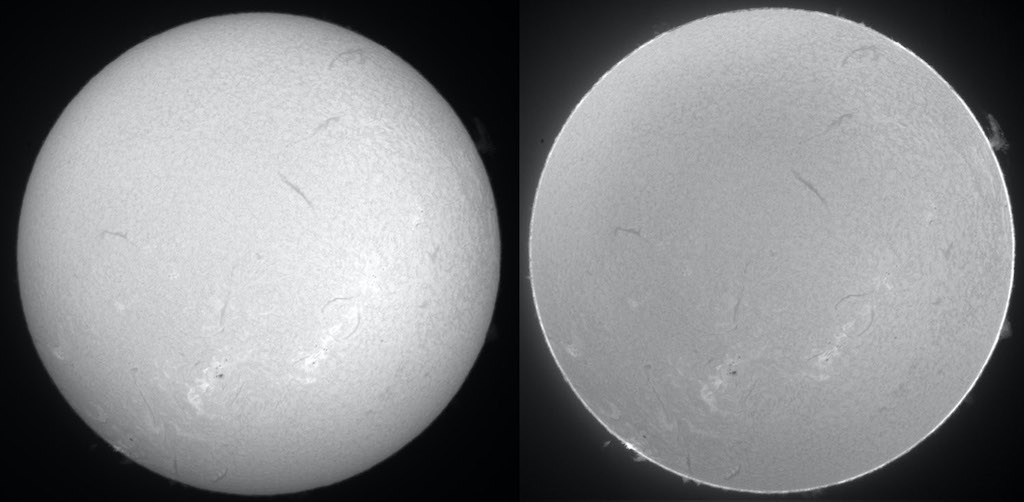 First image of the sun taken with TauSoL in the light of the H-alpha spectral line. In the right image, the outermost edge of the sun was highlighted in order to make the solar prominences shooting beyond the edge of the Sun visible. Photo: TLSMagnetic fields from stars generate polarized light. In polarized light, the light waves only oscillate in a certain direction or a certain plane. In non-polarized light, on the other hand, all possible directions of oscillation are superimposed. In the case of the sun, light of certain wavelengths that is emitted in the area of strong magnetic fields on the sun can exhibit a characteristic polarization. By measuring the spectral distribution of this polarization, the direction and strength of the magnetic field on the sun can be determined.
First image of the sun taken with TauSoL in the light of the H-alpha spectral line. In the right image, the outermost edge of the sun was highlighted in order to make the solar prominences shooting beyond the edge of the Sun visible. Photo: TLSMagnetic fields from stars generate polarized light. In polarized light, the light waves only oscillate in a certain direction or a certain plane. In non-polarized light, on the other hand, all possible directions of oscillation are superimposed. In the case of the sun, light of certain wavelengths that is emitted in the area of strong magnetic fields on the sun can exhibit a characteristic polarization. By measuring the spectral distribution of this polarization, the direction and strength of the magnetic field on the sun can be determined.
Predicting solar flares more accurately
The renowned solar physicist Markus Roth, Director of the Thuringian State Observatory, is delighted that the research work in the solar laboratory is starting. “After around two years of planning and construction, the Thuringian State Observatory is now adding another research station to its observation facilities. The sun is the star that is closest to us. We are therefore best placed to study it. Our aim is to learn more about how a magnetic field is generated inside stars, how the magnetic field changes and how it is influenced by plasma flows inside the star.” The answers to these questions are supposed to help make solar flares more predictable in the future.
Strong eruptions occur repeatedly on the sun, which hurl a lot of material into space. This material (plasma) can affect technological facilities in space and on Earth as a solar storm. For example, satellites for communication or navigation could fail or the power supply on Earth could be disrupted.
“With the new solar laboratory, the Thuringian State Observatory will become one of the leading German research institutions for researching the sun,” Roth emphasizes. Guests from politics, the Thuringian ministries, the companies involved in the construction, and research partners of the Thuringian State Observatory will attend the opening of the Tautenburg Solar Laboratory on October 17, 2024.
Contact
We will gladly answer any further questions!
Professor Dr. Markus Roth
Director
Telefon: 036427 / 863 51
A new Solar Lab for the Thuringian State Observatory
09.10.2024
The Tautenburg Solar Laboratory (TauSoL) is starting observation. On Thursday, October 17th, 2024, it will be officially put into operation with a ceremony.
Guests from research, the relevant ministries, project partners, and companies involved in the construction are expected to attend the opening of the new solar laboratory at the Thuringian State Observatory. Wolfgang Tiefensee, Thuringia's acting Minister for Economic Affairs, Science and Digital Society, has confirmed his attendance.
Professor Dr. Markus Roth, Director of the Thuringian State Observatory, will welcome the guests with a short talk on “The sun - a special star for us”. After the welcoming speeches, the solar laboratory will be officially put into operation. Guests will then be able to visit the solar laboratory and learn more about its objectives, such as researching the sun's magnetic field. If the weather permits and the sun is shining, there will be an opportunity to see a live image of the sun.
The steps on the way to the new solar laboratory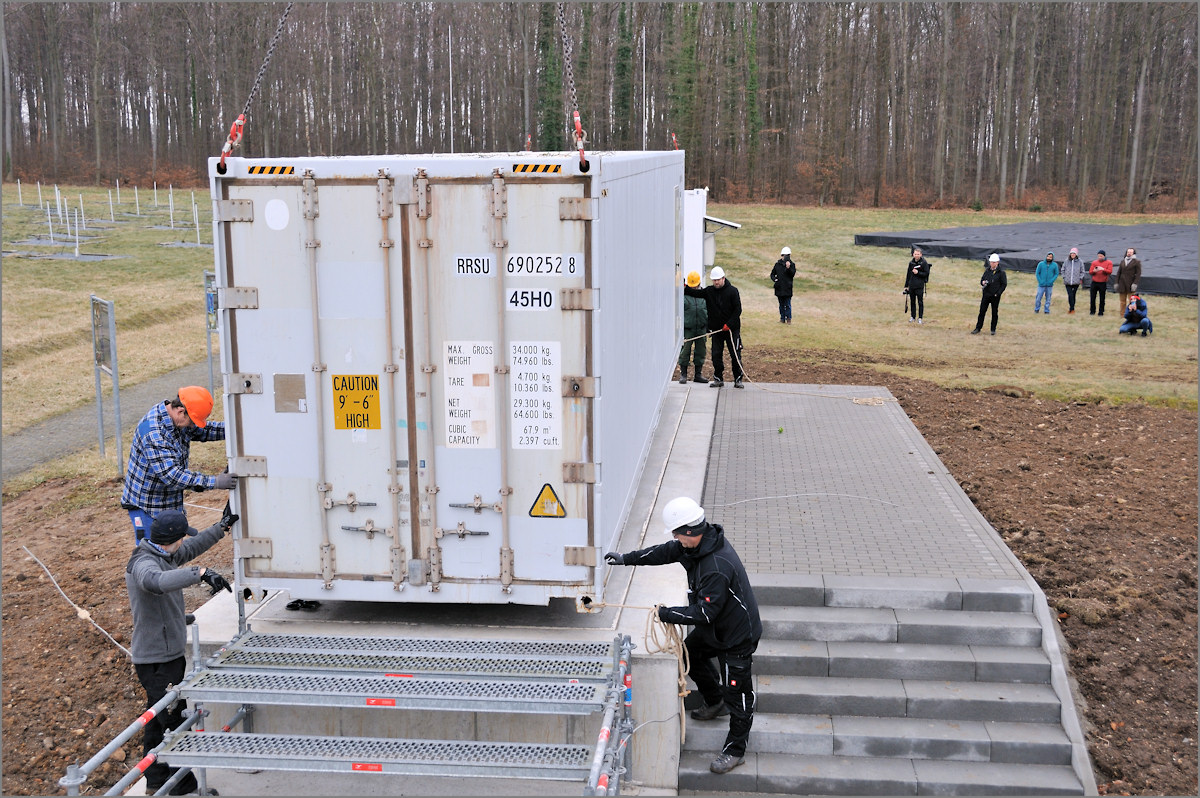
April 2022:
Planning for a solar laboratory at the Thuringian State Observatory begins.
Fall 2022:
The first contracts are awarded.
Summer to winter 2023:
Start of construction; the foundation for the TauSoL container is completed.
End of January 2024:
The 12-metre-long, 5-tonne container is lifted onto the foundation with a mobile crane.
Spring and summer 2024:
interior work, installation work, assembly of the dome and heliostat
September 2024:
first tests
October 17, 2024:
Official commissioning of the Tautenburg Solar Laboratory
Observing campaign at TLS on T Coronae Borealis - A recurrent nova about to explode
07.08.2024
In ancient times, the Romans or ancient Greeks were already observing "new stars", which they called stella novae. These are transient astronomical events that cause a sudden brightness increase of a stellar object up to 6 to 19 magnitudes, which then slowly fades over weeks or months. Such nova eruptions are observed in close binary systems involving white dwarfs, which are the remnants of low- and intermediate-mass stars, and a companion that transfers mass onto the white dwarf. The companions are low-mass main-sequence stars in most cases, but can also be evolved stars as a subgiant or red giant. In the latter case, the objects are called symbiotic stars. The matter accreted onto the surface of the white dwarf is building up a dense but shallow atmosphere. The strong gravitation from the white dwarf compresses this atmosphere, which consists mostly of hydrogen, and heats it up. When a critical temperature is reached, a runaway fusion of hydrogen sets in and this sudden increase in energy causes the violent ejection of the shallow atmosphere into the surrounding space. The expansion and cooling of the ejecta makes it emit in the optical. Most novae are observed only once, but there are ten objects where several novae have been observed so far. They are called recurrent novae.


Top: Evolution of the spectrum of T Coronae Borealis from March 2024 to the present obtained during our observation campaign using the Coude spectrograph at the TLS 2m-telescope demonstrated on the Balmer Hα line. Bottom: AAVSO light curve of T Coronae Borealis in the B, V, R and I band from 2014 to the present and from the last nova outburst (Image: TLS / HP Dörr / V. Schaffenroth).
T Coronae Borealis (constellation crown) is a symbiotic binary in a distance of about 3000 light years with an orbital period of 227.5687 days and one of these few recurrent novae. The primary star is a white dwarf with a radius close to the radius of the earth and a mass of about 1.4 solar masses. The companion is a red giant of about 75 solar radii and a mass of 1.1 solar masses. So far, two nova outbursts of this object on May 12, 1866 and February 9, 1946 have definitely been recorded. It may have been observed in 1217 and 1787 as well. T Coronae Borealis has normally a magnitude of about 10, but in outburst it will reach a magnitude of about 2-3 and will so be visible with the naked eye. In February 2015 the object brightened about 0.75 magnitudes and became bluer. For the next 6 years, it stayed brighter than normal. In March 2023 the luminosity decreased. The fading in R and I is significantly lower than in B and V, which is consistent with increasing absorption as a result of dust. The same was observed before the last nova outburst. The next outburst is therefore expected to occur in the coming months. In addition, the spectra of the T Coronae Borealis show a significant evolution, which we detected in our observing campaign using the Coude spectrograph mounted at the TLS 2m-telescope. Until the beginning of this year, a significant weakening of the emission in the Hα spectral line, which comes from the accretion disk and whose strength is linked to the mass transfer rate, can be observed. In the last months, the emission line got stronger again, which might mean an increasing accretion rate.
How to find T Coronae Borealis ?
It will be visible in the constellation Northern Crown (RA=15:59:30.2 DEC=+25:55:12.6)
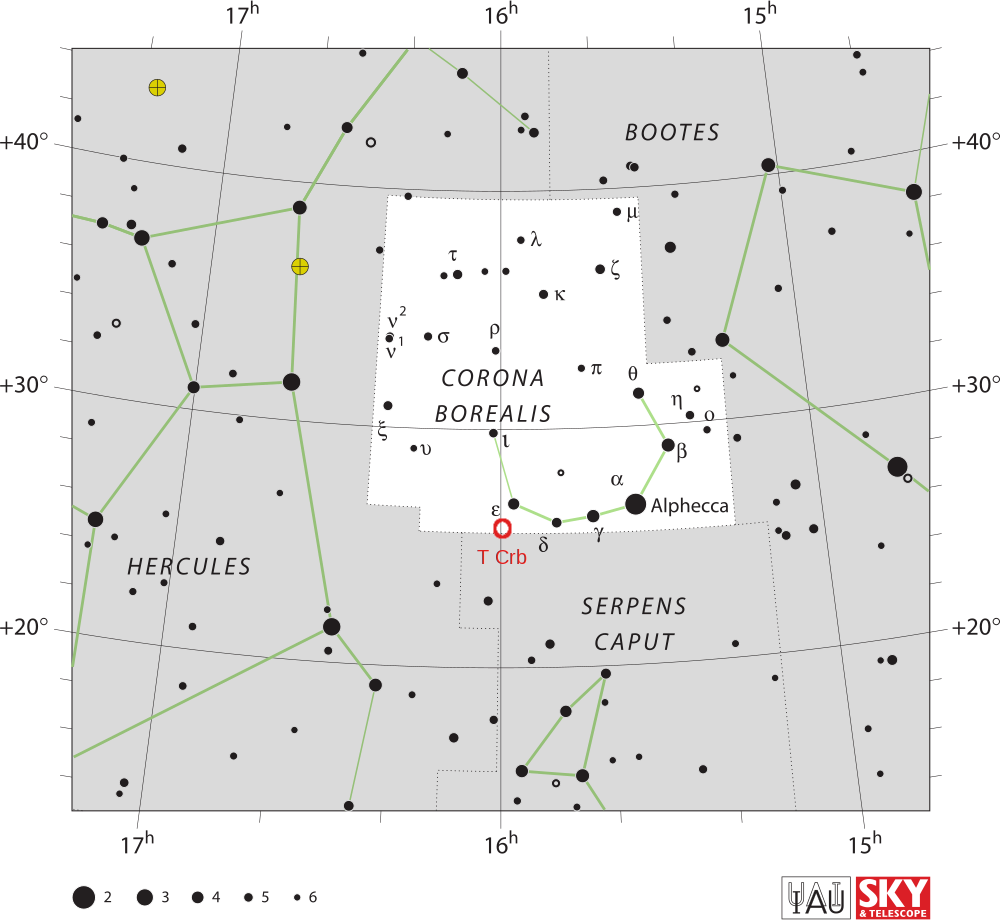
Map of the constellation Northern Crown with the position of T Coronae Borealis
Contact:
Dr. Veronika Schaffenroth
E-Mail: schaffenroth@tls-tautenburg.de
TLS Researchers find proof of the most energetic accretion burst of a massive young star
30.07.2024
Young stars brighten considerably when they go through phases of rapid growth. Such episodes are known as accretion bursts. Researchers at the Thuringian State Observatory identified the most energetic accretion burst of a massive young star yet discovered. For the first time, they modeled how the thermal radiation of the dust in the vicinity of the young star changes during such an event. Such time-dependent simulations enable astronomers to better analyse accretion outbursts of young stars.
Researchers at the Thuringian State Observatory (TLS) in Tautenburg found proof of the most energetic accretion burst of a massive young star yet discovered. Stars form in dense clouds of gas and dust. Young stars, known as protostars, grow when matter from their surroundings falls onto them. However, this is not a steady process. Sometimes protostars gain a particularly large amount of mass within a short time.
Such growth spurts in young stars are called accretion bursts. If an accretion burst occurs, astronomers want to know how long it lasts and how much energy is released. The answer to these questions gives them a better understanding of such bursts.
Increase in microwave radiation points to an accretion burst
In 2019, radio astronomers reported a sudden increase in methanol maser emission, a specific type of microwave radiation, in the star-forming region G323.46-0.08 (G323 for short). This region is located in the constellation Circinus on the southern sky. They suspected that a young massive star in this region was undergoing an accretion burst. Stars with more than eight solar masses are called massive.
Dr. Verena Wolf and Dr. Bringfried Stecklum, scientists at the Thuringian State Observatory, investigate how stars form. Together with an international team they wanted to clarify the cause of the increase in the microwave radiation. Was there really an accretion burst?
Therefore, they searched for images of G323 and found what they were looking for in the archive of the VISTA telescope (Visible and Infrared Survey Telescope for Astronomy) of the European Southern Observatory (ESO). VISTA mapped the southern Milky Way in the near infrared wavelength range.
 The star-forming region G323 imaged with the VISTA telescope of the European Southern Observatory in the near infrared wavelength range. The image on the right from 2015 shows that the region shines much brighter than in 2010, proving the presence of an accretion burst. (The cyan-colored area in the center of the image marks a spot where the object was too bright for the detector.) Credit: TLS / Wolf et al. 2024
The star-forming region G323 imaged with the VISTA telescope of the European Southern Observatory in the near infrared wavelength range. The image on the right from 2015 shows that the region shines much brighter than in 2010, proving the presence of an accretion burst. (The cyan-colored area in the center of the image marks a spot where the object was too bright for the detector.) Credit: TLS / Wolf et al. 2024
Infrared images confirm the growth spurt
"With the VISTA images we were able to confirm the accretion burst," says Dr. Stecklum. Numerous images of the star-forming region G323 at different times allowed the team to measure the temporal brightness change during the event. The burst lasted around eight years, from 2012 to 2020. It is the sixth confirmed accretion burst of a massive protostar.
Moreover, Wolf, Stecklum, and their team successfully modeled the progression of the radiation burst. They utilized specialized software, which was developed by their colleague, Professor Dr. Tim Harries, who works at the University of Exeter, UK.
In a first step, they simulated the temperature change of the dust at different times during and after the burst. Then, they calculated how this temperature change affects the thermal radiation of the dust. The simulation predicted that the afterglow of the accretion event could still be detectable in the far infrared wavelength range in 2022, even though the burst already finished in 2020. This created the opportunity to narrow down the burst energy with far infrared measurements.
Images taken with the SOFIA telescope confirm the model
 SOFIA plane and telescope, Credit: NASA / Jim Ross
SOFIA plane and telescope, Credit: NASA / Jim Ross
In order to obtain images of G323 in the far infrared wavelength range, the research team applied for observations with the airborne observatory SOFIA (Stratospheric Observatory For Infrared Astronomy). The SOFIA aircraft and telescope have been operated by the US space agency NASA and the German Aerospace Center (DLR) until December 2022. The observations in the far infrared showed a slight increase in brightness in accordance with the simulation.
More precise estimation of the accreted mass
With the combination of the VISTA data and the SOFIA data, Wolf, Stecklum and the team achieved a breakthrough: "This allowed us to accurately determine the energy released during the accretion burst and to estimate the accreted mass," says Dr. Wolf.
They found that the accretion burst of G323 is likely the strongest burst ever observed in a massive young star. In eight years, as much energy was released as the Sun emits in 740,000 years. Dr. Wolf explains the exceptional event: "Presumably, a huge clump with approximately seven times the mass of Jupiter fell onto the star.”
The combination of observational data across various wavelength regimes and the computer simulation allowed the research team, for the first time, to precisely examine the interplay between the local dust distribution and the protostellar accretion burst.
Time-dependent simulations like these are not restricted to protostars, but they can be used to better describe dust-enshrouded variable objects. These include, for example, active galactic nuclei and evolved pulsating stars.
The team led by Verena Wolf and Bringfried Stecklum has published the results of their research in the scientific article "The accretion burst of the massive young stellar object G323.46-0.08" in the journal "Astronomy & Astrophysics" (Link: www.aanda.org/10.1051/0004-6361/202449891) Verena Wolf’s research work was supported by the German Aerospace Center (DLR) under grant number 50OR1718.
The Research Team
The members of the research team are:
Bringfried Stecklum, Verena Wolf, Jochen Eislöffel (Thüringer Landessternwarte Tautenburg, Germany),
Paul Boley, Pierre Cruzalebes, Alexis Matter (Université Côte d'Azur, Observatoire de la Côte d'Azur, Nice, France),
Alessio Caratti o Garatti (INAF, Osservatorio Astronomico di Capodimonte, Italy),
Christian Fischer (German SOFIA Institute, University of Stuttgart, Germany),
Tim J. Harries (Department of Physics and Astronomy, University of Exeter, UK),
Hendrik Linz (Max Planck Institute for Astronomy, Heidelberg, Germany),
Aida Ahmadi (ASTRON, Netherlands Institute for Radio Astronomy, Dwingeloo, The Netherlands),
Julia Kobus (Institute of Theoretical Physics and Astrophysics, University of Kiel, Germany),
Xavier Haubois (European Organisation for Astronomical Research in the Southern Hemisphere, Santiago, Chile)
Background: How do stars form?
Stars are formed in the central regions of dense clouds of molecular gas and dust that collapse under their own gravity. Even a very small initial rotation of these clouds leads to a flattening of the collapsing core. Thereby, a protoplanetary disk of gas and dust forms which regulates the flow of matter onto the young star and may become the birthplace of planets.
Initially, matter falls from the envelope, in which the protostar is embedded, onto the disk. Due to mutual friction, it slows down and it moves towards the young star. The result is an unsteady flow of matter from the disk onto the protostar.
The protostar undergoes an accretion burst, if a particularly large amount of mass falls onto it within a brief period. The potential energy released from this infall causes intense heating. The strength and duration of the burst depends on the mass and compactness of the infalling object.
Weaker bursts occur frequently. Strong ones, such as the one observed in G323, are rare. Nevertheless, they play an important role. Young stars may acquire about half of their final mass through strong growth spurts.
Accretion bursts provide a unique opportunity to witness the formation of young stars. This is especially true for massive stars. By observing these events, scientists hope to answer questions like, how much does the luminosity change? What is the burst duration? How much energy is released? How much mass fell onto the protostar? Furthermore, they want to learn how the protoplanetary disk is structured and how it loses its mass.
Since 1939, several hundred accretion bursts have been observed in low-mass stars. But for massive protostars, only six bursts are known. This is because young high-mass stars are much rarer, evolve more quickly, and they are situated in much denser regions, compared to their low-mass counterparts.
The Thuringian State Observatory
The Thuringian State Observatory Tautenburg (TLS) is a research institute funded by the Free State of Thuringia, Germany. It conducts basic research in astrophysics. Researchers at TLS use various telescopes throughout the world for their observations of galaxies, stars, the sun, gamma ray bursts, and extrasolar planets.
The Thuringian State Observatory uses and operates the 2-meter Alfred Jensch Telescope for observations in the optical spectral range and a station of the European Low Frequency Array Radio Telescope (LOFAR). It is also building a solar lab to develop a prototype of an automated telescope for the continuous observation of the sun.
Contact
We are happy to answer your questions:
Dr. Verena Wolf
Telefon: +49 36427 863 754
Dr. Bringfried Stecklum
Telefon: +49 36427 863 755
Thüringer Landessternwarte
Sternwarte 5, 07778 Tautenburg
Learn more about SOFIA
Learn more about ESO's VISTA telescope.
An Upgrade for the international Radio Telescope LOFAR
05.07.2024
The last regular observation cycle of the first generation of the LOFAR radio telescope ended on May 31, 2024. The radio telescope will be upgraded over the next two years. On June 10, 2024, the founding of the LOFAR European Research Infrastructure Consortium (LOFAR ERIC) was celebrated.
When you work at the Thuringian State Observatory you are familiar with the LOFAR field. The radio telescope is located behind the 2-Meter Alfred-Jensch-Telescope. It consists of two antenna fields: one for the low band antennas, ranging between 10 and 90 MHz, and one for the high band antennas, ranging between 110 and 250 MHz.
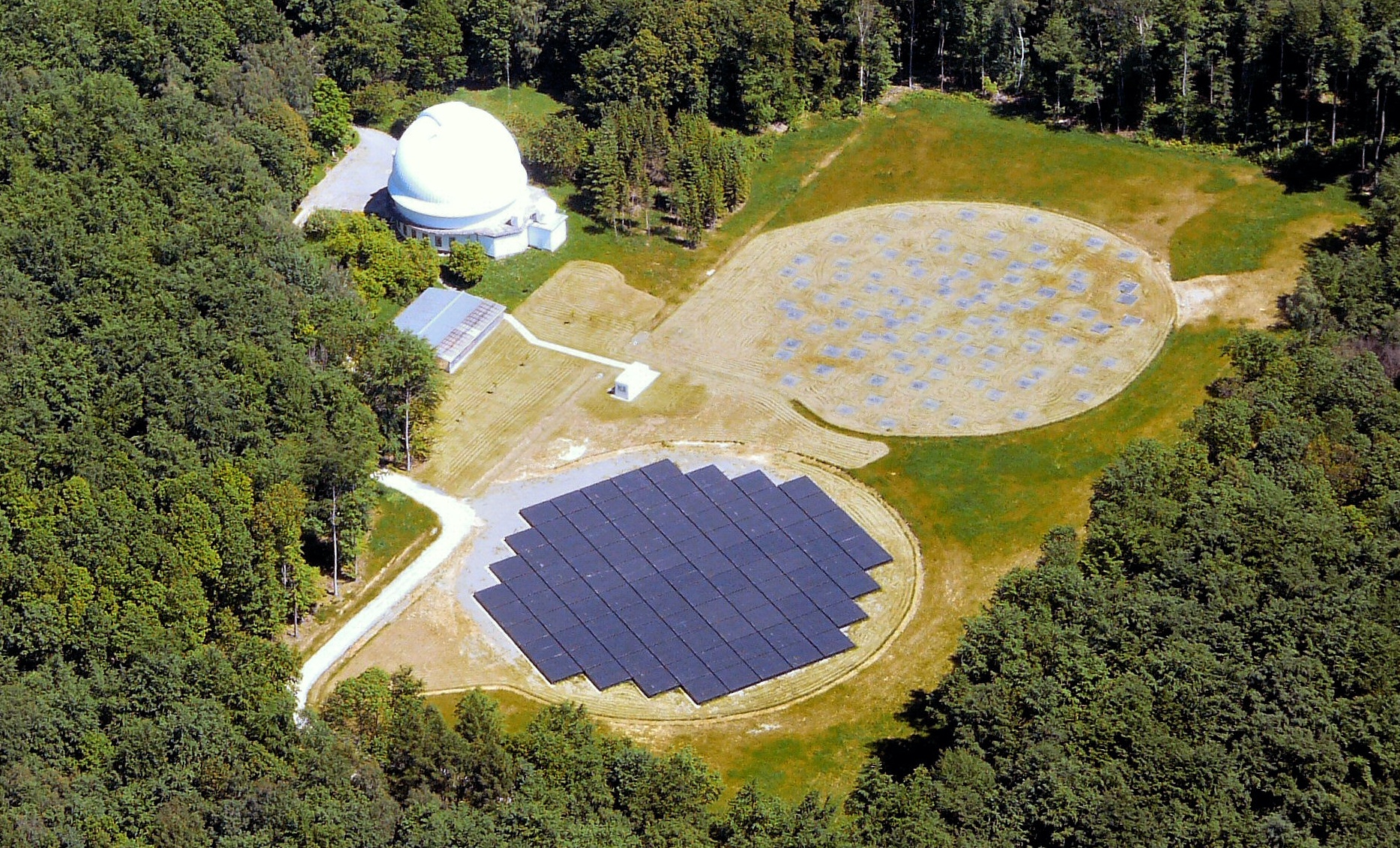 The LOFAR station in Tautenburg shortly after it was built. Photo: TLS / Michael Pluto
The LOFAR station in Tautenburg shortly after it was built. Photo: TLS / Michael Pluto
The Tautenburg station of the European radio telescope LOFAR (Low Frequency Array) was put into operation in 2010. LOFAR began as a national project in the Netherlands and now comprises more than 50 stations across Europe (as of 2024). This joint project fundamentally advanced low-frequency radio astronomy and led to a wealth of scientific publications.
LOFAR is the world's first radio telescope that made it possible to create detailed maps of the sky at very low radio frequencies for the first time. With these maps, scientists can, for example, study the effects of black holes in distant galaxies and trace the history of star formation in the development of the universe.
Researchers at the Thuringian State Observatory played a leading role in data processing for the "LOFAR 2 Meter Sky Survey". Around half of the data collected for this survey was processed by Dr. Alexander Drabent, scientist at the Thuringian State Observatory.
The station in Tautenburg was the second international station outside the Netherlands. The first radio sky image with the Tautenburg LOFAR station was recorded back in April 2009. After 14 years of observation, it is now time for further development.
More detailled observations
Over the next two years, the radio telescope will be transformed to "LOFAR 2.0". The electronics will be improved so that even more precise observations can be made. Dr. Alexander Drabent explains, how: "The processing capacity will be increased so that the radio telescope will be able to process more signals simultaneously than before." For this purpose, the hardware is being upgraded.
Each LOFAR station consists of two antenna arrays. Until now, it was possible to observe with either one or the other field. In the future, it should be possible to receive radio signals with both arrays at the same time.
Joint further development under a new structure
The radio telescope is not only getting a technical upgrade, the legal form has also been adapted to the international research project. LOFAR was previously organized as a Dutch foundation. At the beginning of 2024, LOFAR was transferred to an independent legal form: a consortium for a European research infrastructure, known as the European Research Infrastructure Consortium (ERIC).
 Reception at Dwingeloo, Netherlands, to celebrate LOFAR ERIC, Photo: ASTRONThe European Commission decided to establish LOFAR as a European research infrastructure consortium due to the Europe-wide importance of the radio telescope. The LOFAR ERIC Council officially founded LOFAR ERIC on January 22, 2024, following several years of preparations to make the international LOFAR telescope fit for the future with the new European legal form.
Reception at Dwingeloo, Netherlands, to celebrate LOFAR ERIC, Photo: ASTRONThe European Commission decided to establish LOFAR as a European research infrastructure consortium due to the Europe-wide importance of the radio telescope. The LOFAR ERIC Council officially founded LOFAR ERIC on January 22, 2024, following several years of preparations to make the international LOFAR telescope fit for the future with the new European legal form.
"The new organizational structure as European Research Infrastructure Consortium reflects the participation of many European countries and enables them to further develop LOFAR together," explains Professor Dr. Matthias Hoeft, Deputy Director of the Thuringian State Observatory. He coordinates the German LOFAR consortium. This means that the Thuringian State Observatory represents German scientific interests in the LOFAR ERIC Council as so-called Representing Entity.
On June 10, 2024, Professor Dr. Hoeft, and the Director of the Thuringian State Observatory, Professor Dr. Markus Roth, attended the founding ceremony of LOFAR ERIC in Dwingeloo. The reception took place at the headquarters of the international radio telescope at ASTRON in the Netherlands.
Active cooperation with astrophysicists from Uganda
10.06.2024
The Thuringian State Observatory has been cooperating with universities in Uganda for many years. In May, two astrophysicists from the African country visited again. One of them knows the Tautenburg Observatory very well because he did his Ph.D. work there.
Dr. Benard Nsamba and Dr. Cosmos Dumba, both from Uganda, came to visit the Thuringian State Observatory (TLS) in May 2024. Dr. Nsamba is a lecturer and Branco Weiss Fellow at the Department of Physics at Kyambogo University in Uganda's capital Kampala. Dr. Dumba is a lecturer at Mbarara University of Science and Technology in the city of Mbarara, Uganda.
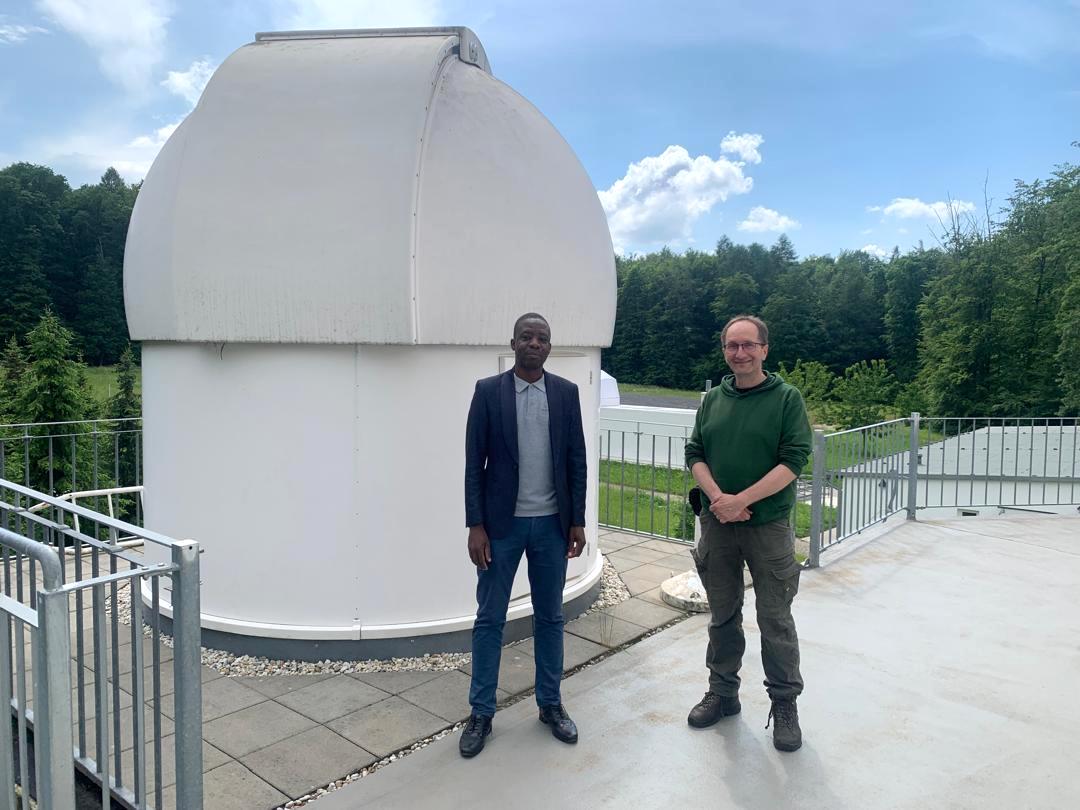 Cosmos Dumba, Mbarara University, and Johannes Winkler, head of the mechanics workshop at Thuringian State Observatory (Foto: TLS)
Cosmos Dumba, Mbarara University, and Johannes Winkler, head of the mechanics workshop at Thuringian State Observatory (Foto: TLS)
Dr. Dumba came to the Thuringian State Observatory in 2014 to do his doctoral thesis in the field of radio astronomy. His research work was supervised by Professor Dr. Matthias Hoeft, Deputy Director of the Thuringian State Observatory. After he received his doctorate from Friedrich Schiller University Jena in 2019, Dr. Dumba went back to Uganda and initiated the cooperation with TLS.
Dr. Nsamba's research focus is asteroseismology. He received his doctorate from the University of Porto in Portugal. At Kyambogo University in Uganda, he heads a group that is a partner of the Max-Planck-Institute for Astrophysics in Garching.
The cooperation between the universities in Uganda and the Thuringian State Observatory is very active. Dr. Eike Günther, a scientist at the Thuringian State Observatory, is a guest lecturer there. He also was the Ph.D. advisor for Priscilla Muheki, wo was the first student to receive a Ph.D. in Astronomy from a Ugandan university. In addition, several TLS scientists gave lectures at the first “Sub-Saharan Africa Advanced Astronomy Summer School” in 2022, organized by Dr. Dumba and Dr. Nsamba.
Aiming to expand cooperation
During this year's visit, Dr. Nsamba and Dr. Dumba talked with researchers at TLS how they could intensify their scientific collaboration. Kyambogo and Mbarara Universities are in the process of expanding their previously small astronomy departments. The scientists discussed which joint research projects can be tackled and whether a scientific exchange between students and scientists is possible.
Dr. Cosmos Dumba gave an online presentation for students at Mbarara University of Science & Technology during his visit to Tautenburg. As part of his lecture „Observational Techniques in Astronomy“, he explained how the different operating modes of the 2-meter universal telescope at the Thuringian State Observatory work. The telescope can operate in both Coudé and Schmidt mode.
„It's very motivating for the students when I can show them the various observation techniques using the 2-meter telescope in Tautenburg as an example“, comments Dr. Cosmos Dumba. He plans to offer such virtual lectures on a regular basis - with the support of scientists at TLS.
ESO signs agreement for ANDES instrument on the ELT
06.06.2024
ESO has signed an agreement with an international consortium of institutions for the design and construction of ANDES. The Thuringian State Observatory is part of the international consortium. ANDES stands for "ArmazoNes high Dispersion Echelle Spectrograph".
ANDES is a powerful spectrograph that will be installed on ESO's Extremely Large Telescope (ELT). A spectrograph splits light into its component wavelengths. Astronomers use it to determine important properties about astronomical objects, such as their chemical compositions. The instrument will have a record-high wavelength precision in the visible and near-infrared regions of light. When working in combination with the powerful mirror system of the ELT, it will pave the way for research spanning multiple areas of astronomy.
Researchers will use the instrument to search for signs of life on extrasolar planets and to identify the very first stars in the universe. In addition, astronomers will be able to use ANDES data to test whether the fundamental constants of physics vary with time and space. Its comprehensive data will also be used to directly measure the acceleration of the Universe’s expansion, one of the most pressing mysteries about the cosmos.
The agreement was signed by ESO’s Director General, Xavier Barcons, and by Roberto Ragazzoni, the President of Italy’s National Institute for Astrophysics (INAF), the institution leading the ANDES consortium. The international consortium is made up of numerous research institutes in 13 countries. In addition to the Thuringian State Observatory, the German members of the consortium include the Leibniz-Institut für Astrophysik Potsdam (AIP), the Institut für Astrophysik und Geophysik, Georg-August-Universität Göttingen (IAG), the Atmospheric Physics of Exoplanets Department, Max-Planck-Institut für Astronomie Heidelberg (MPIA), the Zentrum für Astronomie, Universität Heidelberg (ZAH), and the Hamburger Sternwarte, Universität Hamburg (UHH).
"ANDES enables cutting-edge research in astronomy. I am delighted that the Thuringian State Observatory is part of the international consortium. This opens the door for us to continue making our contribution to important astronomical discoveries in the future", says Professor Dr. Markus Roth, Director Thuringian State Observatory.
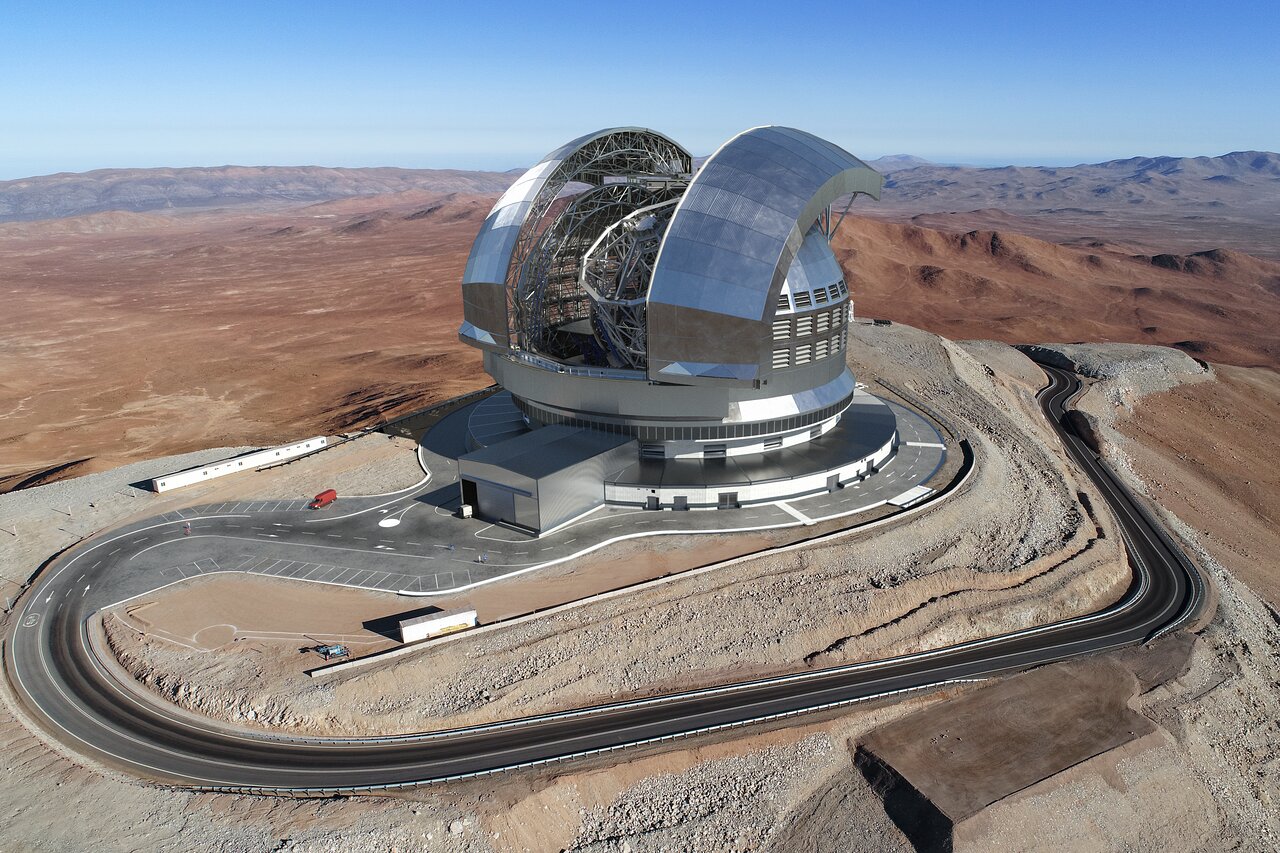 This is how the ELT will look like. Credit: ESOESO’s ELT is currently under construction in the Atacama Desert of Northern Chile. Its main mirror will have a diameter of 39 meters and consist of 798 hexagonal segments. The ELT is scheduled to go into operation by 2030. It will be the largest optical telescope in the world and will usher in a new era of ground-based astronomy.
This is how the ELT will look like. Credit: ESOESO’s ELT is currently under construction in the Atacama Desert of Northern Chile. Its main mirror will have a diameter of 39 meters and consist of 798 hexagonal segments. The ELT is scheduled to go into operation by 2030. It will be the largest optical telescope in the world and will usher in a new era of ground-based astronomy.
The ANDES project is developed by an international consortium composed of research institutes in 13 countries. They are:
- Brazil: Board of Stellar Observational Astronomy, Universidade Federal do Rio Grande do Norte, Observatório Nacional
- Canada: Observatoire du Mont-Mégantic and the Trottier Institute for Research on Exoplanets, Université de Montréal
- Denmark: Instrument Centre for Danish Astrophysics on behalf of Niels Bohr Institute, Aarhus University, Danmarks Tekniske Universitet
- France: Centre National de la Recherche Scientifique (CNRS) on behalf of Observatoire de la Côte d’Azur, Université Côte d’Azur (LAGRANGE), Laboratoire d’Astrophysique de Marseille, Aix-Marseille Université, Centre National d’Etudes Spatiales (LAM), Institut de Recherche en Astrophysique et Planetologie, Université Toulouse III-Paul Sabatier (IRAP), Institut de Planétologie et d’Astrophysique de Grenoble, Université Grenoble-Alpes (IPAG), Laboratoire Univers et Particules de Montpellier, Université de Montpellier (LUPM), Institut d’Astrophysique de Paris, Sorbonne Université (IAP), Laboratoire de Météorologie Dynamique, Ecole Normale Supérieure, Ecole Polytechnique, Sorbonne Université (LMD)
- Germany: Leibniz-Institut für Astrophysik Potsdam (AIP), Institut für Astrophysik und Geophysik, Georg-August-Universität Göttingen (IAG), Atmospheric Physics of Exoplanets Department, Max-Planck-Institut für Astronomie Heidelberg (MPIA), Zentrum für Astronomie, Universität Heidelberg (ZAH), Thüringer Landessternwarte Tautenburg (TLS), Hamburger Sternwarte, Universität Hamburg (UHH)
- Italy: INAF, Istituto Nazionale di Astrofisica (Lead Technical Institute)
- Poland: Nicolaus Copernicus University in Torun
- Portugal: Instituto de Astrofísica e Ciências do Espaço (IA) at Centro de Investigaço em Astronomia/Astrofísica da Universidade do Porto (CAUP), Instituto de Astrofísica e Ciências do Espaço at Faculdade de Ciências da Universidade de Lisboa, Associação para a Investigação e Desenvolvimento de Ciências (FCiências.ID)
- Spain: Instituto de Astrofísica de Canarias (IAC); Consejo Superior de Investigaciones Científicas (CSIC, Spain) on behalf of Instituto de Astrofísica de Andalucía (IAA), Centro de Astrobiología de Madrid (CSIC-INTA)
- Sweden: Lund University, Stockholm University, Uppsala University
- Switzerland: Département d’Astronomie, Université de Genève; Weltraumforschung und Planetologie, Physikalisches Institut, Universität Bern
- United Kingdom: Science and Technology Facilities Council, United Kingdom Research and Innovation on behalf of Cavendish Laboratory & Institute of Astronomy, University of Cambridge; UK Astronomy Technology Centre; Institute of Photonics and Quantum Sciences, Heriot-Watt University
- USA: Department of Astronomy, University of Michigan
Learn more about ANDES on ESO's website.
Amateur and professional astronomers keep an eye on minor planets together
30.05.2024
The „Small Planets“ group of the association Vereinigung der Sternfreunde e.V. (VdS) visited the Thuringian State Observatory in Tautenburg on May 26, 2024,. The observation of so-called “Near Earth Objects” is a research focus there. We explain what these Near Earth Objects are and why they are observed.
From May 24 to 26, 2024, 35 members of the “Small Planets” section of the Vereinigung der Sternfreunde e.V. met for their annual conference in Jena and Tautenburg. The VdS was founded in 1953 and is – according to their own description – the largest astronomical association in the German-speaking world with around 4,000 members.
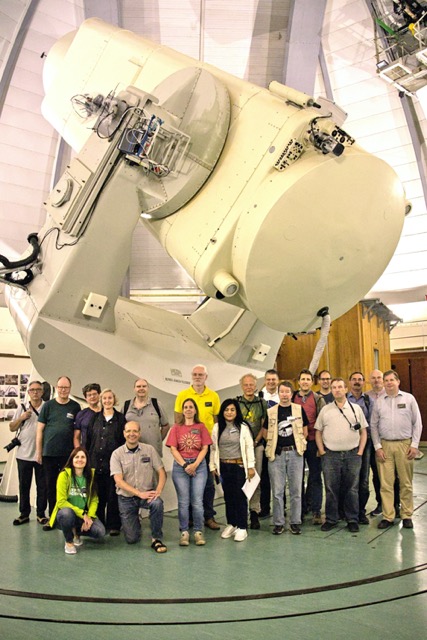 Foto: TLS
Foto: TLS
On Saturday, May 25, the participants listened to presentations in the Senate Hall of the Friedrich Schiller University in Jena. The stargazers discussed observation techniques and methods, the analysis of star occultations by transiting minor planets, measurements with robotic telescopes, how to find new asteroids with amateur equipment and what to do if an object is on a collision course towards Earth.
On Sunday, 26 May, Dr. Bringfried Stecklum, astronomer at the Thuringian State Observatory and coordinator of small planet observations, reported on the history of the Thuringian State Observatory and its many years of experience in tracking down asteroids. He showed the 2-meter Alfred Jensch telescope, other observation facilities such as the LOFAR telescope, the solar laboratory and the plate archive. With the world's largest Schmidt camera, the Alfred Jensch Telescope is the longest-serving telescope in the world in the field of observing minor planets.
What are minor planets?
Our solar system is populated by a vast number of smaller bodies - minor planets or asteroids. Such minor planets are not always just lumps of rock. Their inner structure can be very different. In technical jargon, loosely bound objects are referred to as “rubble piles” or even “flying sand banks”. In most cases, these are former comets whose ice has evaporated during many passes by the sun.
They all have one thing in common: they move in an orbit around the sun. It is important to know the orbit of these minor planets as precisely as possible, as many of them cross the Earth's orbit. And that could be dangerous.
Productive collaboration between amateur and professional astronomers
For some years now, special sky surveys have been carried out to find all Near Earth Objects larger than 100 meters because the orbits of these bodies can change and they could collide with Earth. However, the sky surveys provide so many new objects that their classification and orbit monitoring is only possible with the support of amateur astronomers.
The Minor Planet Center (MPC) currently estimates the total number of discovered minor planets at around 1.3 million (as of May 2024). The Minor Planet Center at the Smithsonian Astrophysical Observatory is the official institution that collects, evaluates and publishes data on minor planets and comets. It operates under the auspices of the International Astronomical Union (IAU).
When professional or amateur astronomers observe minor planets, they send the results of their observations, i.e. the coordinates and brightness of the object at the relevant time, to the Minor Planet Center. Amateur astronomers usually observe brighter objects, while telescopes with a larger diameter, such as the Alfred Jensch Telescope in Tautenburg, select fainter objects.
The Thuringian State Observatory has been involved in the classification and monitoring of Near Earth Objects since 2010. Continuous measurements of the celestial position of newly discovered and known near-Earth asteroids increase the accuracy of their orbits. This makes it easier to assess whether a new object is close to Earth or not, or whether the danger posed by a known asteroid has increased or decreased. With an average of 6,000 measurements per year, the Thuringian State Observatory is now one of the most productive observatories in Europe for this activity.
Why watching a total solar eclipse is so special
14.05.2024

A total solar eclipse, like the one that was visible over North America on April 8, 2024, is one of the most magnificent events we humans can observe from Earth. Why? Because for a brief moment it vividly shows us our place in the universe. We can watch as the moon moves in front of the sun, as the sunlight dims, as the sun "disappears" for a short time in the middle of the day and as the moon then continues on its path.
We were in Texas on April 8, 2024 to observe the total solar eclipse. In conversations with acquaintances, friends or strangers, we often heard that many perceived the chance to see a solar eclipse "on their own doorstep" as nothing special at all. A misconception! In this report, we explain what is so great about such an event. Experiencing a total solar eclipse is great, a little eerie and, for some, spiritual. The risk of addiction is high: anyone who has ever seen a total solar eclipse will want to repeat the experience.
What you can experience during a solar eclipse
Before and during a total solar eclipse, you can experience many sensory impressions and make observations that you would otherwise not be able to see.
A very peculiar light
During a solar eclipse, the moon moves further and further in front of the sun and gradually obscures its light. This can be clearly seen in the minutes shortly before totality, before the moon completely covers the sun. The human eye perceives that the light changes in the middle of the day. The intensity decreases, the light has a different hue. If you didn't know that a solar eclipse was taking place, this change in light could be very eerie. The strange light is one of the most striking features of a solar eclipse (apart from the darkness during totality).
The corona of the sun
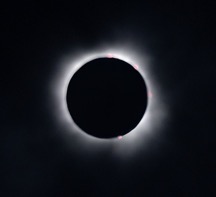 Photo: Evans Caglage, Dallas, Texas
Photo: Evans Caglage, Dallas, Texas
The corona is an impressive sight during a total solar eclipse. This is the hot, thin outer atmosphere of the sun, which is only visible to the eye during a total solar eclipse. Its temperature is around two million degrees Celsius.
The expansion of the corona depends on the 11-year cycle of the sun's magnetic activity. During the so-called solar maximum, magnetic activity is high and the corona is large. This was the case on April 8, 2024, as we are currently in the middle of a fairly strong solar maximum.
Prominences: When the sun has pink spot
Between the visible solar disk and the corona lies the chromosphere with a temperature of 10,000 Kelvin. The chromosphere contains so-called prominences. These are hot gases that float in the solar atmosphere due to magnetic fields. Prominences usually consist of hydrogen gas, which glows in a beautiful pink to reddish color. During a total solar eclipse, the moon covers the sun's disk and gives us a rare glimpse of the sun's chromosphere.
During the solar eclipse on April 8, the sun showed a huge prominence in the south. At first glance, this looked like a small pink pimple. It is rare to see a prominence with the naked eye. Most can only be seen with binoculars. This prominence was about the size of the planet Saturn, which is why it was visible to the naked eye. 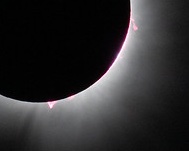 Photo: NASA / Keegan Barber
Photo: NASA / Keegan Barber
The shadow of the moon
If you are in an open field during a solar eclipse when the sky is clear, you can see the core shadow of the moon racing towards you at a speed of 2,500 km/h. This racing shadow can look quite menacing - and impressive. This speeding shadow can look quite menacing - and impressive.
A sunset - but in 360 degrees on the horizon
After a normal sunset, you can see a glow of light on the western horizon. During the total solar eclipse, we saw this glow all around us on the horizon. Another difference to a daily sunset: after the sun has set, the sky is still relatively bright for some time. During a solar eclipse, the moment the moon covers the sun, it is as if someone has turned off the sun's light switch.
Caution: Only observe the sun with special glasses
Please never look at the sun without special eye protection for observing the sun. There are glasses for observing a solar eclipse. They have a film that protects your eyes. Only during the short phase of a total solar eclipse, when the moon completely covers the sun, can you look directly at the sun.
Please also take care when using a camera, telescope or binoculars: Always use a special solar filter placed over the front of the optics or in front of the lens. You can get serious eye damage if you look at the sun with a camera, binoculars or telescope without a special filter.
If you have the opportunity to observe a total solar eclipse, seize it! Did you know? Modern solar telescopes and instruments can create an artificial solar eclipse so that the sun's corona can be studied. From such systematic studies, researchers can learn a lot about the physical processes that lead to solar storms. Research into the sun is one of the focal points of research at the Thuringian State Observatory.
Author: Artie Hatzes
Aurora visible in Thüringen
11.05.2024
Northern lights — aurora borealis — were visible last night in Europe. Many people around Germany posted pictures of the aurora that was visible around midnight between Friday and Saturday. At the Thuringian State Observatory (TLS) in Tautenburg, the Northern Lights made observations by astronomers difficult. "The sky became so bright that most of the stars disappeared. Even a bright star like Beta Lyrae was barely visible, while fainter stars were lost in the glare," reported Dr. Eike Günther, researcher at TLS.
The northern lights originate from flares on the sun. These can emit not only light, but also charged particles. These charged particles hit the magnetic field of the Earth and penetrate along the field lines into the Earth's high atmosphere and thereby stimulate it to glow. This is how we see northern lights.
Our cloud monitoring camera recorded the sky during the entire night, showing the aurora developing (Video).
Green and pink colors were visible.
(Image taken with smartphone from Tautenburg, credit: Eike Guenther)
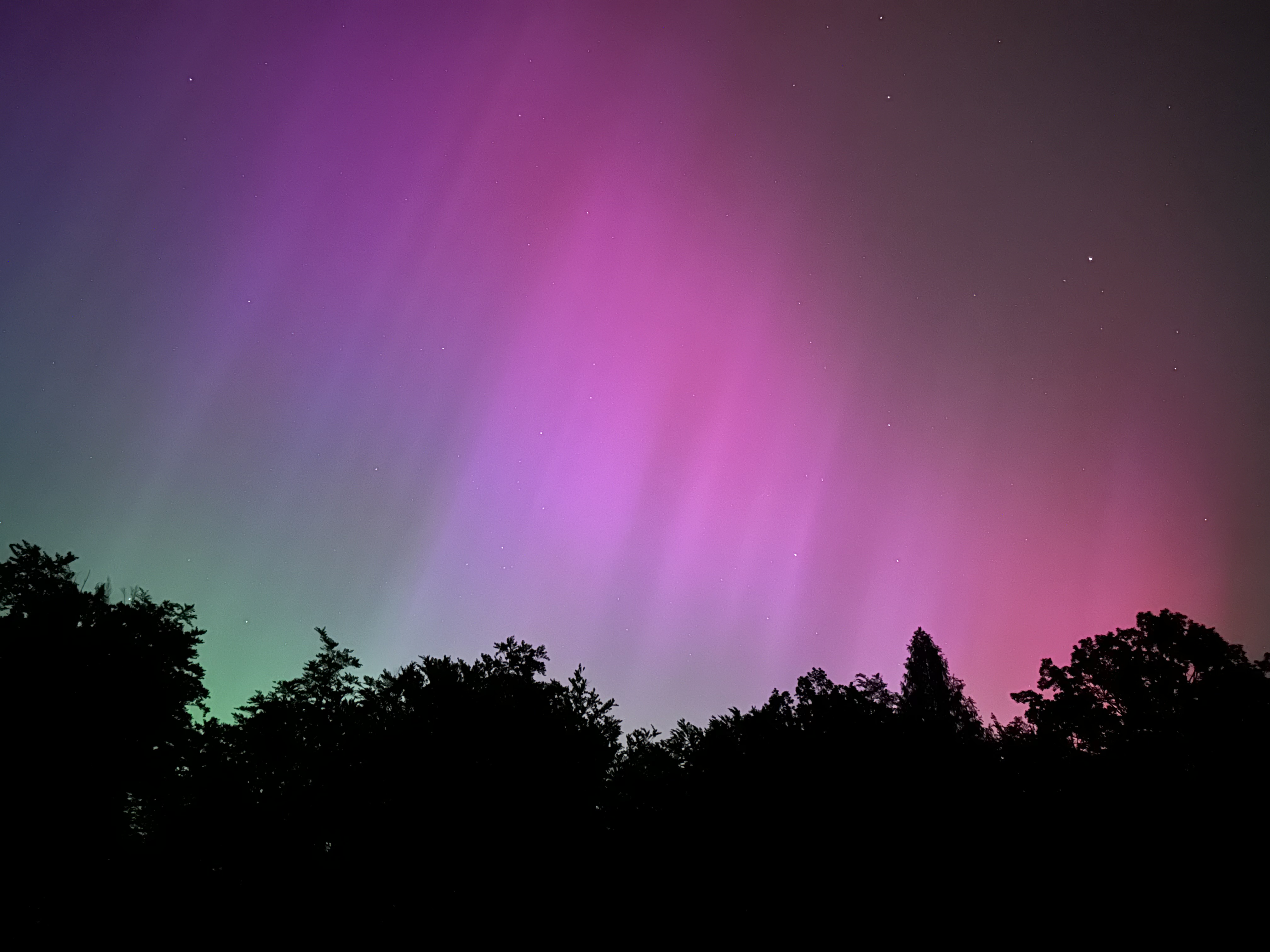
Ursa Major constellation wrapped into northern lights seen from downtown Göttingen (Credit: Patrick Gaulme)
A new method to observe winds on planet Jupiter
15.04.2024
A team of scientists managed to draw the first map of atmospheric circulation of the planet Jupiter with the Doppler method.
Jupiter, the largest planet in our solar system, is famous for its brownish-white storm bands and its large red spot. The wind bands race around the planet in an easterly and westerly direction and reach high speeds of up to 500 kilometers per hour. An international team of astronomers, including Patrick Gaulme, astronomer at the Thuringian State Observatory in Tautenburg, has now produced the first map of these winds using the Doppler method.
What wind speeds prevail on Jupiter? Until now, astronomers have used images of the gas planet's cloud structures taken at different time intervals to answer this question. They calculate the wind speeds from the changes in the images. However, this method has its limits. "The clouds change or disappear. This affects the measurements," explains François-Xavier Schmider, Research Director at the Observatoire de la Côte d'Azur (OCA) in France who led the research project.
Another difficulty: The images allow scientists to calculate the speed of the winds in an east-west or west-east direction, but give poor results in a north-south or south-north direction. The reason is, simply put: The bands on Jupiter have different altitudes, and clouds structures are separated from one band to the next. Also, cloud tracking cannot measure the vertical motion in a planet’s atmosphere. Therefore, it is not known, how heat and chemical elements are transported from the inside to the outside of the planet.
Measuring atmospheric circulation with the Doppler method
Instead of relying on cloud images of Jupiter, Schmider's research team uses the Doppler method to observe the atmospheric circulation of the gas planet. The Doppler effect can be used to measure how the frequency of a light or sound wave changes when its source moves relative to the observer. If the source moves towards the observer, the waves arrive at the observer at shorter intervals. If the source moves away, the distances between the waves increase.
Patrick Gaulme, scientist at the Thuringian State Observatory, is part of the international research team that observed the atmospheric circulation on the planet Jupiter using the Doppler method. He describes how the researchers proceeded: "A Doppler imager is mounted on each of three telescopes in Japan, in France and in the USA. Together, these telescopes form the JOVIAL network. The Doppler imager can be used to create an image of the planet together with its Doppler velocity map by tracking the displacement of the spectral lines of sunlight reflected from Jupiter." From the shift of the spectral lines, the speed of the atmospheric motions can be deduced.
After the team had observed for around 80 hours with the instrument at one of the three telescopes, the Dunn Solar Telescope in Sunspot, New Mexico, USA, the researchers were able to create a complete zonal velocity map of the planet Jupiter. This is the first time that such a map is obtained with such a technique for any of the giant planets. “It is stunning. I particularly enjoy seeing the great red spot standing apart. And more generally, watching something that no one has done before. Scientifically speaking, the zonal wind map shows an excellent agreement with results obtained by cloud tracking, which validates the technique, and allows us to move forward”, says Patrick Gaulme.
The team has published the results of its research in the scientific article "Three-dimensional atmospheric dynamics of Jupiter from ground-based Doppler imaging spectroscopy in the visible"in the The Planetary Science Journal. The preprint of the paper is accessible under this link: https://ui.adsabs.harvard.edu/abs/2023arXiv231216888S/abstract
|
A reconstructed image of Jupiter |
A zonal velocity map of Jupiter. The red and blue colors indicate the easterly and westerly winds, respectively. |
Both images were obtained from data recorded with the JOVIAL/JIVE instrument at the Dunn Solar Telescope in Sunspot, New Mexico.

The Dunn Solar Telescope tower at Sunspot, New Mexico, @Patrick Gaulme, for editorial purposes only
The Thuringian State Observatory
The Thuringian State Observatory Tautenburg (TLS) is a research institute funded by the Free State of Thuringia, Germany. It conducts basic research in astrophysics. Researchers at TLS use various telescopes throughout the world for their observations of galaxies, stars, the sun, gamma ray bursts, and extrasolar planets.
The Thuringian State Observatory uses and operates the 2-meter Alfred Jensch Telescope for observations in the optical spectral range and a station of the European Low Frequency Array Radio Telescope (LOFAR). It is also building a solar lab to develop a prototype of an automated telescope for the continuous observation of the sun.
Contact
We are happy to answer your questions:
Bauhaus - Tautenburg: When Art Meets Science
09.04.2024
On February 22, we had the chance of welcoming PhD students in Art and Design from the Bauhaus University in Weimar, led by Prof. Alexandra Toland. The goal of this first meeting between the two Thuringian institutes was to get to know each other, with the idea of fostering future collaborations between art students and scientists.
The visit started with a tour of the 2m-Alfred Jensch telescope by Eike Guenther and an explanation of the LOFAR radio telescope by Alexander Drabent. Then, roundtable conversations organized by Harriet von Froreich (Bauhaus University) and Patrick Gaulme (TLS) gathered about 15 scientists and 10 art researchers to exchange ideas across disciplines regarding questions of time, distance, types of data, and the challenges and joys of developing methods in practicing research. The meeting was followed by a get together. Next visit is scheduled in June, hoping for clear skies to see the telescope at work during a short near-solstice night.

What solar physicists can learn from the solar eclipse.
07.04.2024
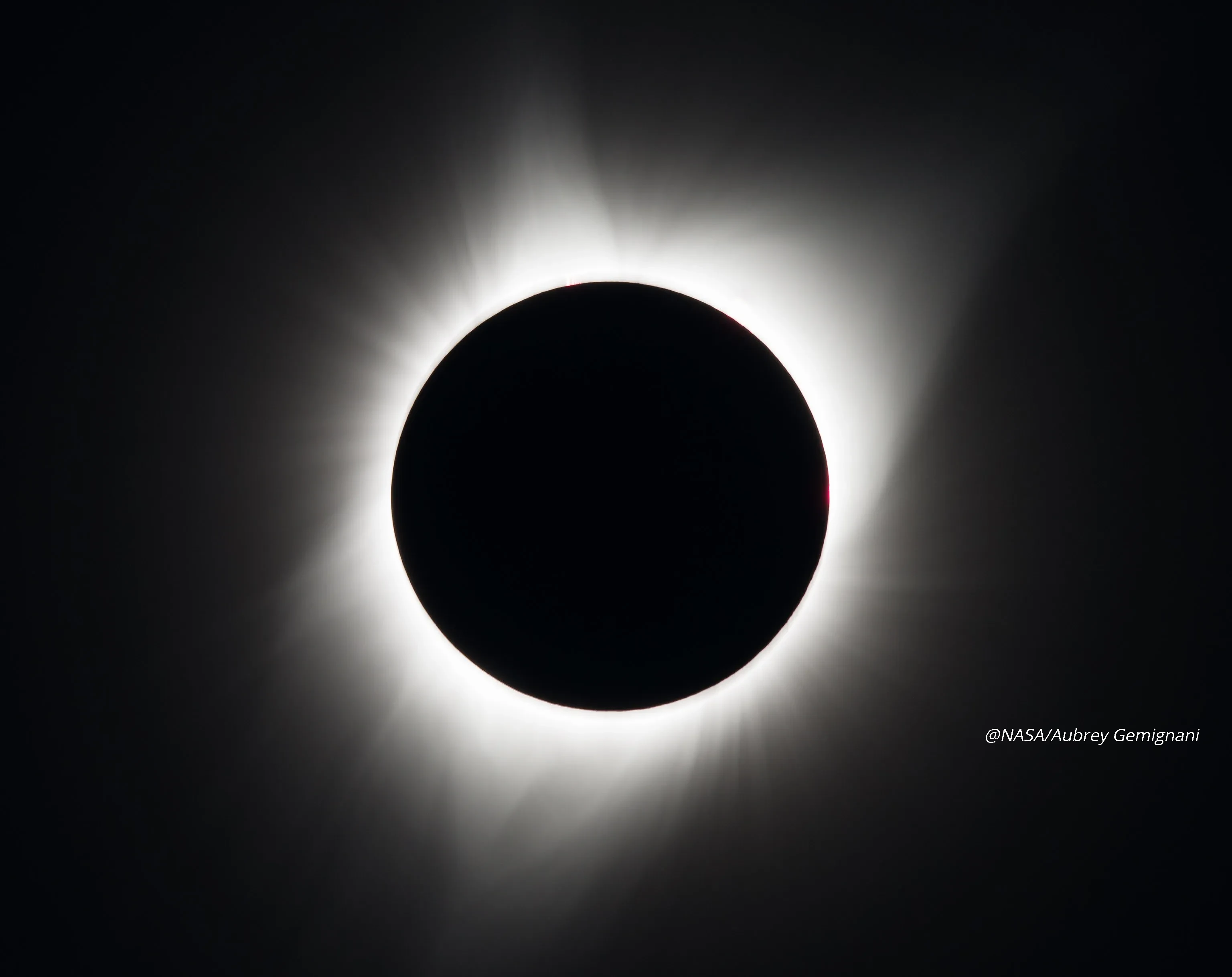
A total solar eclipse is a spectacular natural event. The moon moves between the sun and the earth, blocking our star. It gets dark in the middle of the day, and the night sky becomes visible. Millions of people will observe this event on April 8, 2024, in North America. Professor Dr. Markus Roth, Director of the Thuringian State Observatory, explains why the solar eclipse of 2024 is so special.
A total solar eclipse is an impressive natural spectacle. On April 8, 2024, the sun will darken in a roughly 180-kilometer-wide strip across Mexico, the United States, and Canada. Why is this solar eclipse so special?
 Quelle: Friedrich-Schiller-Universität / Annegret GüntherMarkus Roth: After 2017, this solar eclipse is the second one to occur on the North American continent in a short time. The solar eclipse on April 8 is visible in a wider strip than seven years ago. Additionally, the duration of the solar eclipse is between slightly over 3 minutes to 4.5 minutes, depending on the observation location, which is quite long. In comparison, the solar eclipse on August 11, 1999, visible in Germany, lasted just over two minutes.
Quelle: Friedrich-Schiller-Universität / Annegret GüntherMarkus Roth: After 2017, this solar eclipse is the second one to occur on the North American continent in a short time. The solar eclipse on April 8 is visible in a wider strip than seven years ago. Additionally, the duration of the solar eclipse is between slightly over 3 minutes to 4.5 minutes, depending on the observation location, which is quite long. In comparison, the solar eclipse on August 11, 1999, visible in Germany, lasted just over two minutes.
Currently, the sun is at the peak of its activity. This means the probability of sunspots is quite high. Sunspots are strong magnetic field poles and occur particularly frequently every eleven years. Accordingly, the sun's corona, which becomes visible during a solar eclipse, could appear very structured.
Interestingly, the comet 12P/Pons-Brooks will also be in the daytime sky on April 8. Although it is too faint to be seen with the naked eye during the eclipse, it would be visible with a telescope. However, caution must be taken not to accidentally look into the sun with the telescope or binoculars.
Millions of people will observe the celestial spectacle and hope that the sun will provide a spectacular show. You are solar physicists. What scientific insights do researchers gain from such an event?
Roth: NASA will send the WB-57 high-altitude research aircraft along the path of the solar eclipse. A research project will capture images of the solar eclipse from an altitude of 50,000 feet above the Earth's surface. By capturing images above most of the Earth's atmosphere, researchers aim to discern new details of structures in the middle and lower corona. NASA's WB-57 will also carry instruments to learn more about the temperature and chemical composition of the corona and coronal mass ejections.
With modern solar telescopes and instruments, a solar eclipse can also be artificially and continuously produced, allowing the solar corona to be continuously studied. From such systematic studies, much can be learned, for example, about the physical processes that lead to coronal mass ejections on the sun, often also called solar storms.
What have scientists learned from previous solar eclipses?
Roth: In the past, an important insight was the confirmation of the general theory of relativity. In 1919, it was demonstrated that light from stars is deflected by the gravitational effect of the sun, as calculated by Albert Einstein beforehand.
Furthermore, in the past, solar eclipses have been used to determine the temperature, composition, and magnetic field in the solar corona. The corona is the outermost layer of the solar atmosphere, which is usually overwhelmed by the sun, meaning that measurements of these physical quantities were otherwise not possible.
What impact does a solar eclipse have on the Earth?
Roth: A solar eclipse has no noticeable impact on the Earth. There may be slight temperature changes due to the darkening. Also, it is expected that the animal world may react with surprise to the sudden onset of night.
Thuringian State Observatory Achieves Milestone in Construction of New Spectrograph PLATOSpec
04.04.2024
| The Thuringian State Observatory Tautenburg is part of a consortium building the high-resolution spectrograph PLATOSpec. This instrument will be mounted on a 1.52-meter telescope at the European Southern Observatory (ESO) in La Silla, Chile, during the course of 2024. An important milestone has now been reached for the project: a new front-end has been installed on the telescope, and the calibration unit has been installed. | 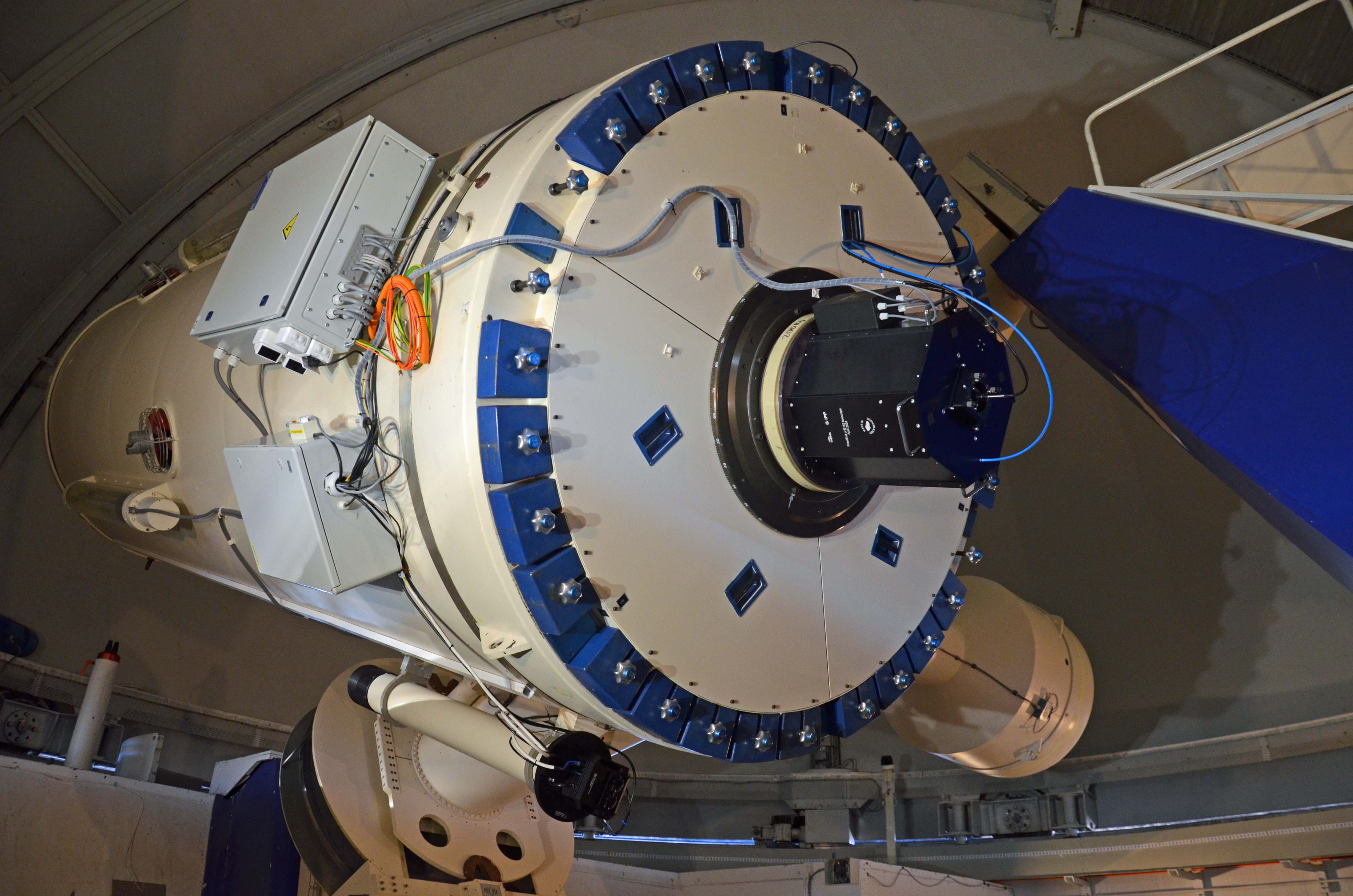 |
The workshops of the Thuringian State Observatory have developed, built, and tested the calibration unit for the spectrograph PLATOSpec. At the end of March 2024, it was mounted on the 1.52-meter telescope of the ESO in La Silla, Chile, together with a new front-end.
The calibration unit serves as a reference for the telescope's observations. For this purpose, the spectrum of a thorium-argon lamp is used, whose spectral lines are already known. The spectrograph PLATOSpec will desperse the starlight captured by the telescope into a spectrum. This spectrum is then compared with that of the thorium-argon lamp. This provides researchers with a wavelength reference point. Additionally, an iodine cell is used for calibration. With the spectrum produced by this iodine cell, the radial velocity (Doppler shift) of a star can be measured very accurately.
The front-end connects the spectrograph to the telescope. It was built by the Czech company TopTech, Turnov. The Thuringian State Observatory, as a partner of the PLATOSpec consortium, commissioned, supervised, and financed the construction of the front-end.
The calibration unit and the front-end are prerequisites for connecting the PLATOSpec instrument to the 1.52-meter telescope. The spectrograph PLATOSpec is still under construction. PLATOSpec will be a state-of-the-art echelle spectrograph with high spectral resolution, covering the spectral range from 350 to 700 nanometers. PLATOSpec will support satellite missions TESS and PLATO with ground-based follow-up observations. The aim of these missions is to find planets around stars other than the Sun, known as extrasolar planets.
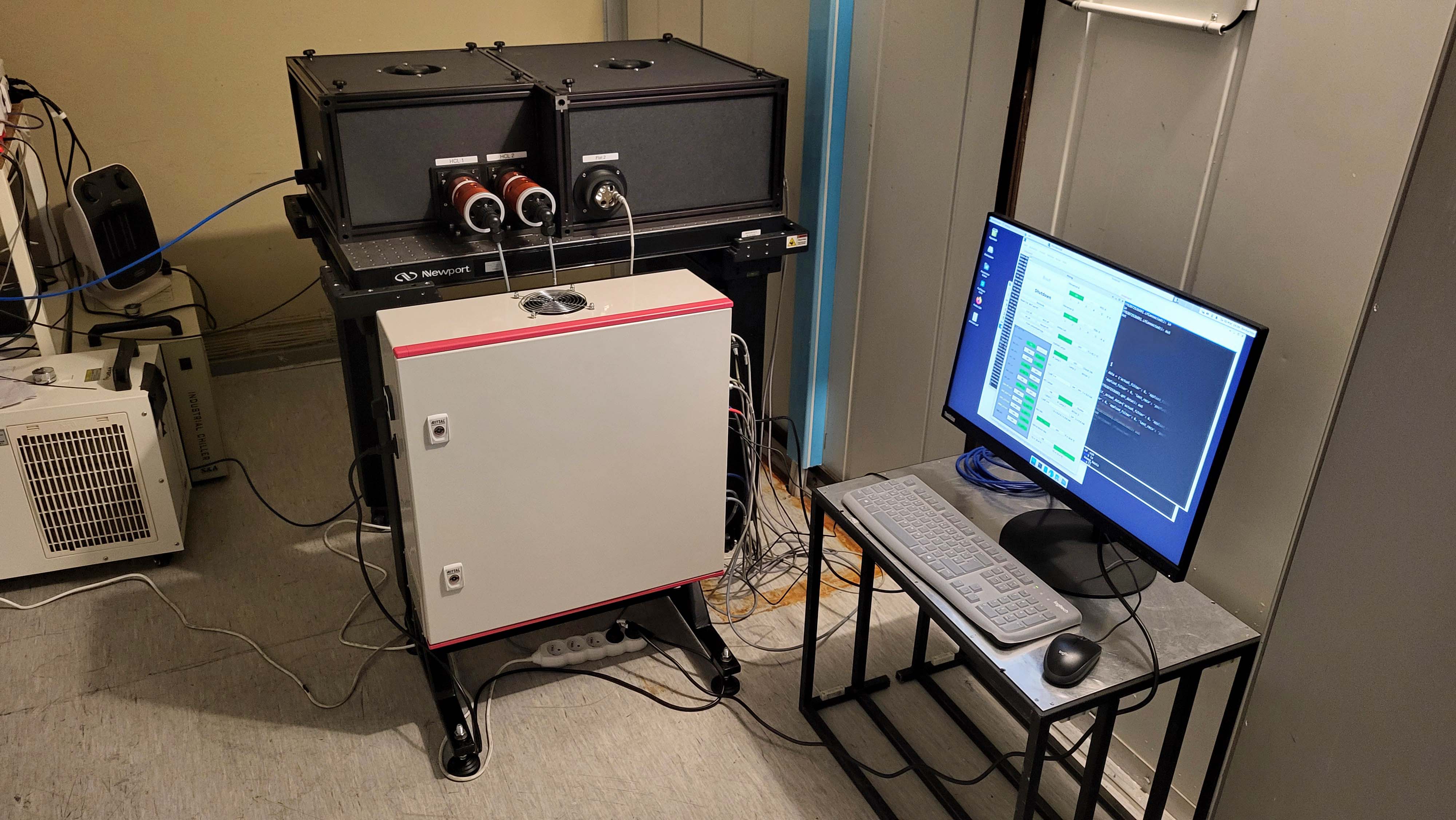 |
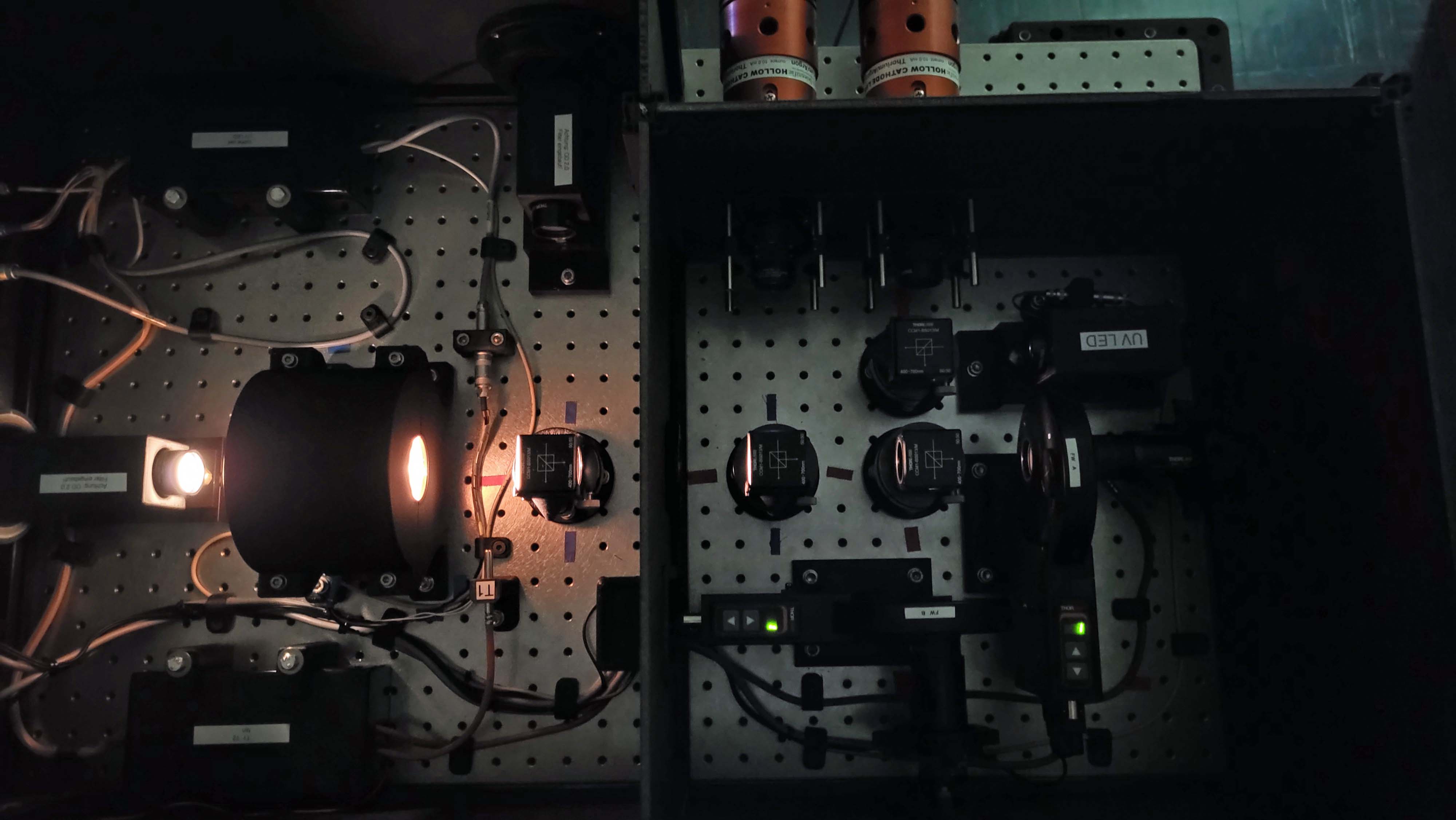 |
The PLATOSpec instrument is being built by a consortium of three institutes. The main partners of the consortium are the Astronomical Institute ASCR in Ondrejov, Czech Republic, the Thuringian State Observatory, Tautenburg, Germany, and the Pontificia Universidad Católica (PUC) de Chile, Santiago, Chile. The contribution of the Thuringian State Observatory to PLATOSpec was financed by the Thüringer Aufbaubank with funds from the research promotion program of the state of Thuringia.
Asteroid 2024 BX1 observed at the TLS shortly before its impact near Berlin
06.02.2024
The time around the full moon is actually not suitable for astrophotography. Nevertheless, the night of January 20th to 21st, 2024 had a surprise in store for Dr. Stanislav Melnikov and his colleagues. He carried out observations for the ``Near-Earth Asteroid program´´. The sky was already so bright that faint asteroids were barely visible. Thus, the researcher was pleased when a new object named Sar2736 suddenly appeared on the target list. Its brightness and speed suggested it was close to Earth. Dr. Bringfried Stecklum, who followed the measurements via the Internet and processed the images, advised him to quickly observe the object. However, the first attempt at around 11:30 p.m. failed. The replacement camera, which had to be used since TAUKAM was under repair, did not capture the asteroid with its smaller field of view. A little later more precise coordinates arrived and Dr. Melnikov tried again. This time he took six images, which were immediately evaluated (Fig. 1). An orbit is routinely calculated from the determined positions and those already known in order to detect false identifications and other problems. Dr. Stecklum became speechless when the FindOrb program used for this purpose predicted that the asteroid would hit Earth in about an hour (Fig. 2). In addition, the coordinates of the impact site suggested that this would happen in the northern central part of Germany. Normally, this would be a cause for concern, but in this case there was no reason for it. Using the typical reflectivity of asteroids and the measured brightness, FindOrb calculated a diameter of about one meter. For such a small object, part of the mass would burn up when it entered the atmosphere, and the rest would burst. Therefore, there was no danger. A third attempt to photograph Sar2736 with the TLS telescope was unsuccessful - the object was now traveling too fast. A little later there were first reports of the spectacular light phenomenon of a bolide or fireball that fell west of Berlin near Nennhausen (Havelland).
A total of 14 stations reported positions to the Minor Planet Center (MPC), which gave the object the official name 2024 BX1. The TLS was third in the order. 2024 BX1 is the eighth asteroid discovered within 24 hours of its impact. Its discoverer, Krisztián Sárneczky, from the Konkoly Observatory, had already identified two. Various search parties have now managed to find fragments of the asteroid (meteorites) (MAZ). These suggest that 2024 BX1 was not a primitive asteroid, but came from a body whose internal structure is similar to that of Earth. It may have split off from Vesta, the largest asteroid in the solar system. The rare finds promise valuable information about the history of the formation of the solar system.
|
Fig. 1: Superposition of the six TLS images. The telescope tracked the asteroid, therefore the stellar images are elongated. |
Fig. 2: Results of FindOrb, based on the discoverer positions (K88) and those of TLS (033). Impact time and coordinates were highlighted red. The size estimate is at the upper right. |
Obituary Professor Dr. Josef Solf
02.02.2024
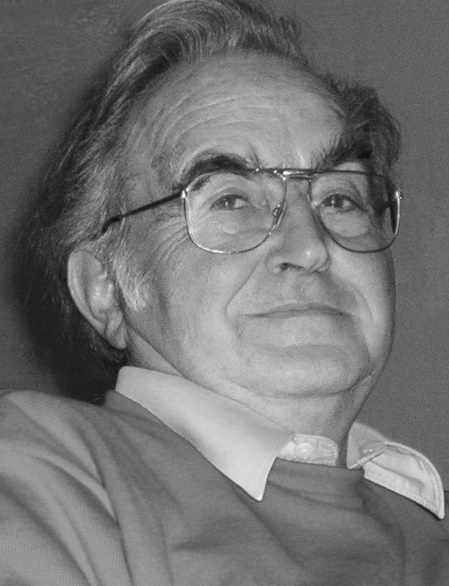 |
The Thuringian State Observatory mourns its former director Professor Dr. Josef Solf, who passed away on December 31, 2023, just a few weeks before his 90th birthday, in Jena. |
Josef Solf had a significant impact as a scientist and institute director in Heidelberg and Tautenburg. During his time in Heidelberg at the Max Planck Institute for Astronomy, he developed spectroscopic instrumentation for the telescopes at the newly emerging German-Spanish Astronomical Center on Calar Alto. With them, he achieved recognized scientific success in the field of bipolar phenomena in star formation and development. As director of the Thuringian State Observatory, he contributed to the expansion of the institute and the modernization of the 2-meter Alfred Jensch telescope and its instrumentation.
Josef Solf was born on February 5, 1934, in Worbis in the Eichsfeld region and grew up there with his five younger brothers in "Solf's Mill." His father was a very influential figure in his life. Early on, he sparked numerous interests in him – in mill technology, music, religion, photography, philosophy, and physics. He attended boarding school in Heiligenstadt, where he graduated in 1952 with a humanistic diploma. He then began studying mathematics at the University of Jena. Driven by his big question "Am I finished yet?" he changed direction and studied philosophy, theology, and art history from 1953 to 1962 at the Jesuit universities in Berlin, Frankfurt, and Munich. As his question remained unanswered and the curiosity to discover the world was inherent in him, he changed his career path again in 1962 and began studying mathematics, physics, and astronomy – first in Karlsruhe, then in Heidelberg, where he graduated in 1967 with a degree in physics. He completed his PhD in nuclear physics there in 1969.
From 1969 to 1994, Josef Solf worked as one of the first scientific employees at the newly founded Max Planck Institute for Astronomy in Heidelberg, dedicating himself to the development of astronomical instruments and the study of star development.
He played a crucial role in establishing the institute's new observatory at Calar Alto in southern Spain. His focus soon turned to the development of spectroscopic instrumentation for the new telescopes. He gained knowledge during research stays at the Lick Observatory in California in 1971 and 1974, among others. A significant achievement was the Coudé spectrograph for the 2.2-meter telescope, a vertical setup through the entire dome building, which relied on a single mirror outside the telescope and undoubtedly represents one of the most powerful instruments of its kind. As a similar device promised no greater efficiency for the 3.5-meter telescope, interest there focused on a large Cassegrain spectrograph. Together with the institute's co-director, Guido Münch, Josef Solf developed the TWIN spectrograph, which became one of the workhorses at this telescope for a long time. He also converted a standard Boller & Chivens spectrograph according to his own design into a unique "echelle" spectrograph, which allowed imaging the entire spectral range from UV to near-infrared with a single exposure.
The commissioning and initial use of these devices made Josef Solf an observing astronomer. Initially, he observed late M-stars and Mira variables. His long-slit, high-spectral-resolution images of the prototypical massive star S106, together with Uri Carsenty, first revealed the blue and red shifts of the gas in its opposing extended shells, convincingly demonstrating the bipolar structure of these objects. This was followed by studies of bipolar outflows and jets from evolved stars such as R Aqr and the nova HR Delphini, which he also made the subject of his habilitation thesis in 1983, as well as work on bipolar planetary nebulae with his doctoral student Luis Felipe Miranda. He then turned to detailed spectroscopic studies of bipolar outflows and Herbig-Haro jets from young stars and their bow shocks together with Karl-Heinz Böhm. The method of spectro-astrometry that he developed to study these jets near the source was and is so successful that it was sometimes called "Solf's method" by some. In 1990, the University of Heidelberg appointed Josef Solf as a professor.
When Josef Solf received a call to a professorship in astronomy at the Friedrich Schiller University of Jena in 1994, combined with the position of director of the Thuringian State Observatory in Tautenburg, he returned to Jena, which he had left as a student in 1953. As a member of the Faculty of Physics and Astronomy, he was involved in teaching and scientific training of students until his retirement in 1999. As director of the Thuringian State Observatory Tautenburg, he contributed to the expansion of the institute and the modernization of the 2-meter Alfred Jensch telescope and its instrumentation. The construction of a new research building provided much-needed space for workrooms for scientists and administration. Laboratory space was also created for the electronics lab, as well as climate-controlled rooms for archiving the extensive collection of photographic plates of the Thuringian State Observatory and for their digital processing. An important concern for Josef Solf was the modernization of the 2-meter Alfred Jensch telescope, the largest optical telescope on German soil, which, through the renewal of its drives, enabled digital control. He designed the conversion of the high-resolution Coudé spectrograph into a Coudé echelle spectrograph, with vastly increased wavelength coverage, and conceived a low-resolution spectrograph for the Nasmyth focus of the telescope. With the active support of his former institute, the Max Planck Institute for Astronomy in Heidelberg, all focus stations received powerful CCD cameras as detectors.
After his retirement, Josef Solf remained active in the Catholic church choir in Jena. For many years, he was involved in the hospice association, accompanying numerous people in their darkest hours. He had three sons with his beloved wife Gisela, who passed away in 2017.
The Thuringian State Observatory has not only lost its former director and an outstanding scientist with Josef Solf but also a modest, energetic, and highly esteemed colleague. It will preserve his memory with honor.
Container laboratory weighing 5 tons floats to its destination
31.01.2024
The container for the future TauSol solar laboratory at the Thuringian State Observatory has been placed on a special foundation.
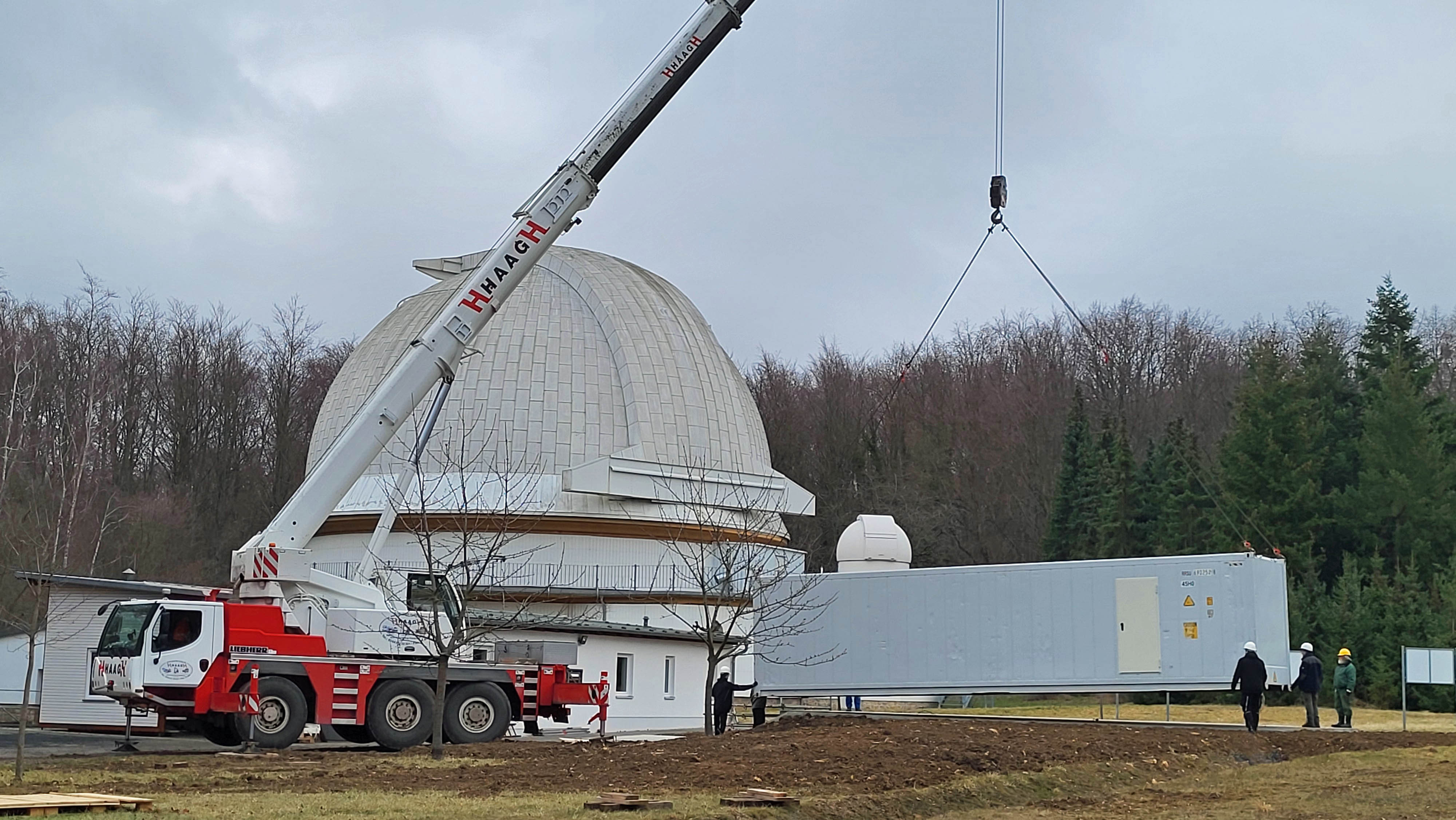
On Wednesday morning, January 31, 2024, at 8:30 a.m. the time had come. After the foundation for the new Solar LaboratoryOn Wednesday morning, January 31, 2024, at 8:30 a.m. the time had come. After the foundation for the new TauSol solar laboratory (see also news from ) was completed before Christmas, the weather and then the observatory's schedule did not play along at the beginning of the year. But this week the clayey ground had dried out and the weather was stable, so that the heavy mobile crane from Dorndorf was able to arrive. As the distance to the foundation was initially too great, the 12 m long and 5 ton container had to be parked once so that the truck-mounted crane could then lift the container onto the foundation from a position closer to the foundation on the second attempt. Accompanied and guided by the observatory's technical team, the container finally touched down in the specified position with almost millimeter precision - precision landing! Now the interior work and the installation of the dome above the container can begin. But first the container will get a new coat of paint - if the weather cooperates again. "TauSol solar laboratory was completed before Christmas, the weather and then the observatory's schedule did not play along at the beginning of the year. But this week the clayey ground had dried out and the weather was stable, so that the heavy mobile crane from Dorndorf was able to arrive. As the distance to the foundation was initially too great, the 12 m long and 5 ton container had to be parked once so that the truck-mounted crane could then lift the container onto the foundation from a position closer to the foundation on the second attempt. Accompanied and guided by the observatory's technical team, the container finally touched down in the specified position with almost millimeter precision - precision landing! Now the interior work and the installation of the dome above the container can begin. But first the container will get a new coat of paint - if the weather cooperates again.
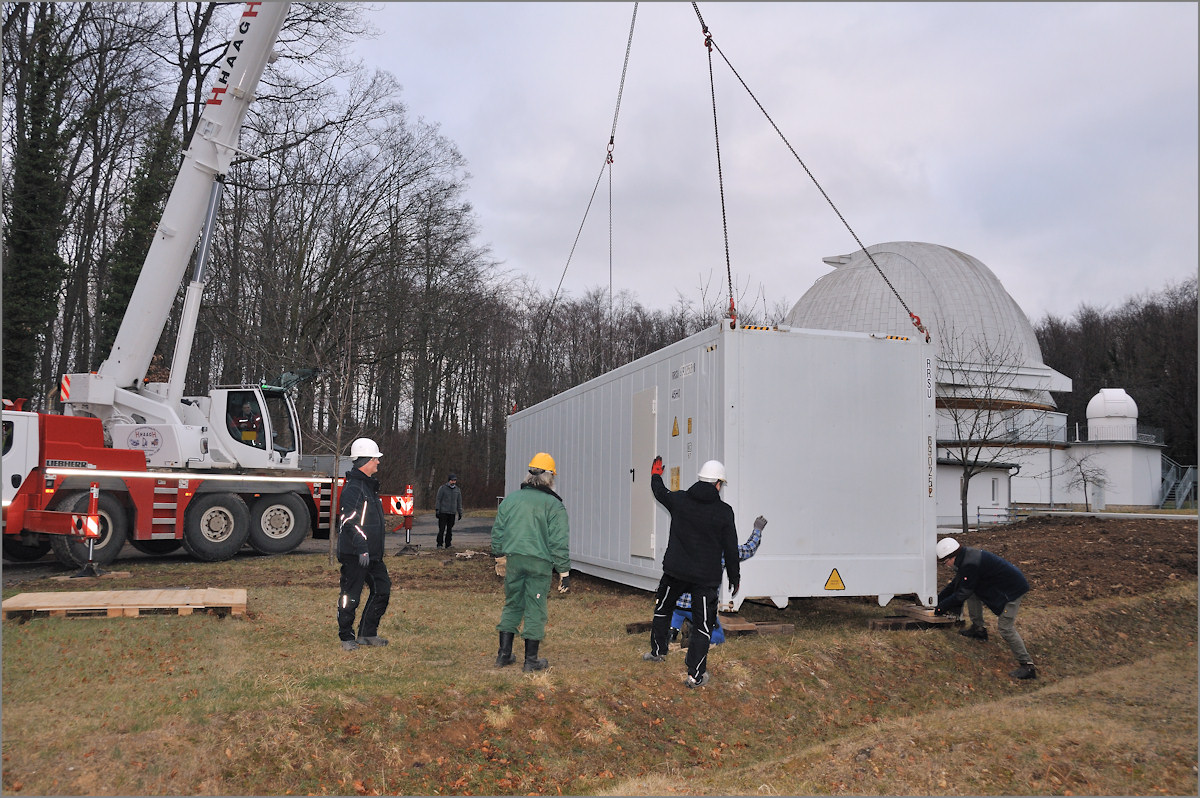 |
 |
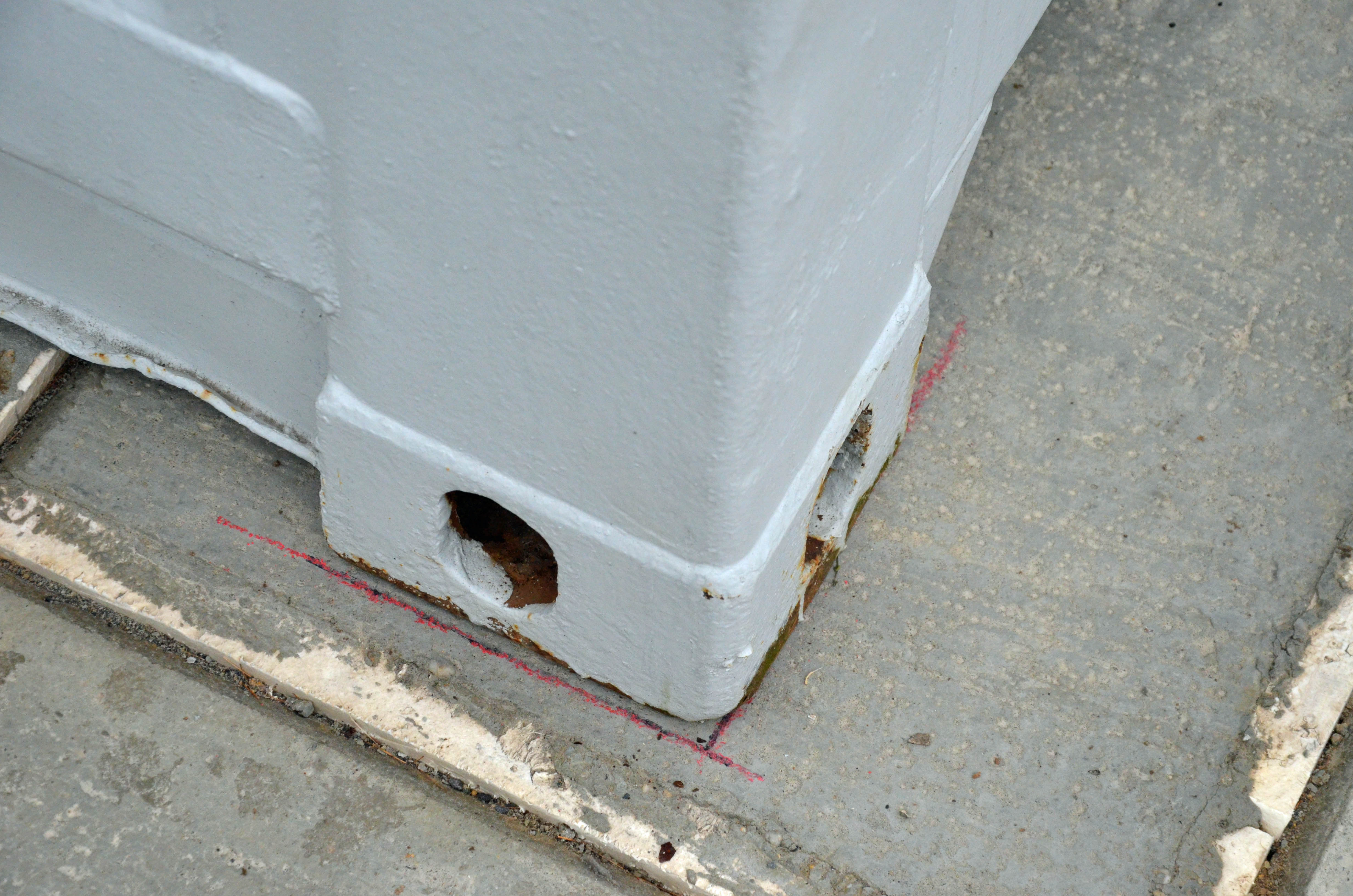 |
A nebula beating at the rhythm of its newborn star
26.11.2023
An international team of astronomers lead by Prof. Roberto K. Saito of the Universidade Federal de Santa Catarina in Florianópolis, Brasil, reports the discovery of a unique object in our Galaxy. This object is located in the Scorpio constellation, close to the center of the Milky Way. It is observed as a peculiar combination of a variable star surrounded by a nebula that is also changing brightness. This discovery has been published on 2023 November 14 in The Astrophysical Journal Letters.
The discovery is made thanks to the VVV survey, that systematically mapped the Milky Way plane in the infrared with the VISTA telescope at ESO Paranal Observatory in Chile. The deep images accumulated along more than 12 years allow searching and monitor stars that change brightness with time. Tens of thousands of variable stars were discovered, that are classified according to their light curves. However, occasionally some object appears that cannot be easily explained because they do not belong to any of the known classes.
The VVV survey found a dozen such unidentified objects, that are called WIT, for “What Is This?”, and that represent very rare astrophysical phenomena. Such is the case of WIT-12, that was discovered in the infrared images using a simple technique that is generally applied to search for supernova light echoes. This technique consists of making color images using different observation epochs in the same filter. In this case the search was made using the images obtained in years 2010, 2011 and 2012 revealed a nebula that changes color, suggesting an interesting kind of variability. The follow-up study of the region revealed a red star located in the center of the nebula that changes brightness with a period of about 4 years. Follow-up spectroscopic observations made with the 4-m telescope SOAR at Cerro Pachón in Chile revealed that this central source is a very young stellar object that periodically illuminates the nebula. But the mystery does not end there, because the study that took so many years also revealed that the nebula changes brightness, and that one part varies in synch with the star, while the other part varies out of synch. That is, when the central star gets brighter, that part of the nebula fades.
This is an unknown phenomenon that perplexes the observers, motivating its classification as a WIT object, although the VVV team proposes a couple of explanations. This could be a central variable star that produces a light echo that reflects in the back part of the surrounding nebula. As the nebula is so extended, the light from the near side arrives directly to us, that region brightens when the star is brighter. On the other hand, the light that reflects on the more distant region of the nebula takes some time to travel, so it arrives later when the star is dimming. This phenomenon known as a light echo has been observed before in a few explosive events like novae and supernovae, but not in variable stars like WIT-12. Another possible explanation is the presence of a warped circumstellar disk that blocks light to different parts of the nebula as the warp moves around the star. This might be described as an "anti-light house", that illuminates all directions except one, in rotation. The final solution demands more observations and a new search for these kinds of objects, using telescopes like the future Vera C. Rubin Observatory.
The figure shows on the left the central star and two regions of the nebula encircled. Schematic light curves are displayed on the right, with colors corresponding to those on the left. While one region (red circle) is in phase with the stellar variability, the other one (cyan circle) is out of phase.
Contact: Dr. Bringfried Stecklum
Delivery of the TauSoL laboratory container
15.11.2023
On November 15 the "40-foot container" (approx. 12m long) for the new Tautenburg solar laboratory TauSol was delivered to the Thuringian State Observatory by a special truck. Until the foundation is completed, on which the container will be placed together with the beam frame for a dome and the heliostat, the container is now standing at the edge of the LOFAR radio telescope, where the interior work will begin.
 |
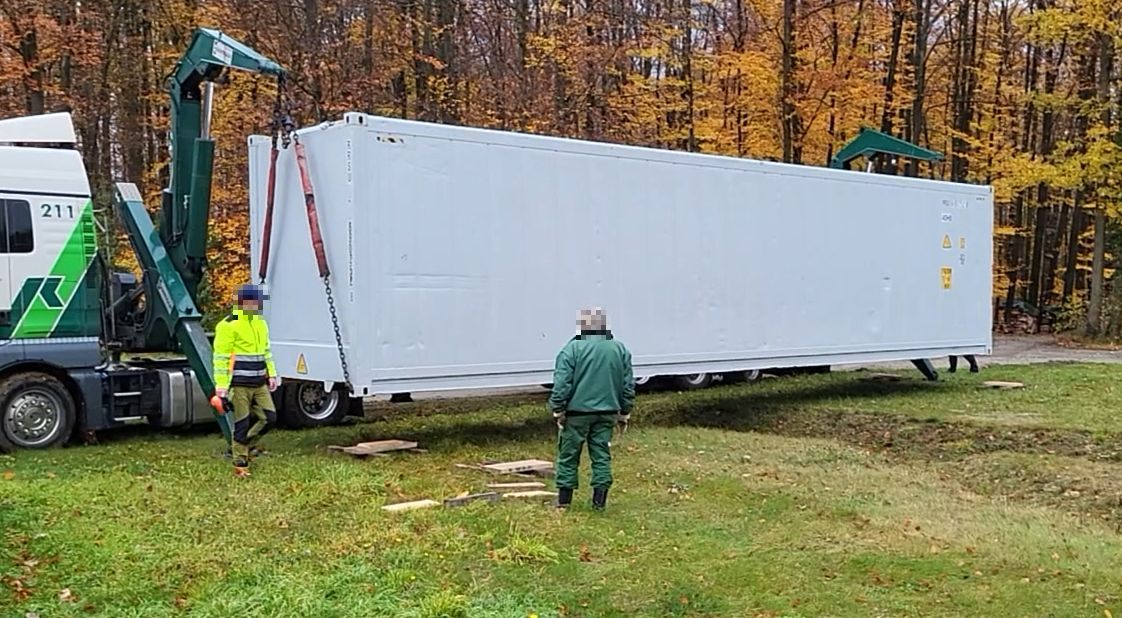 |
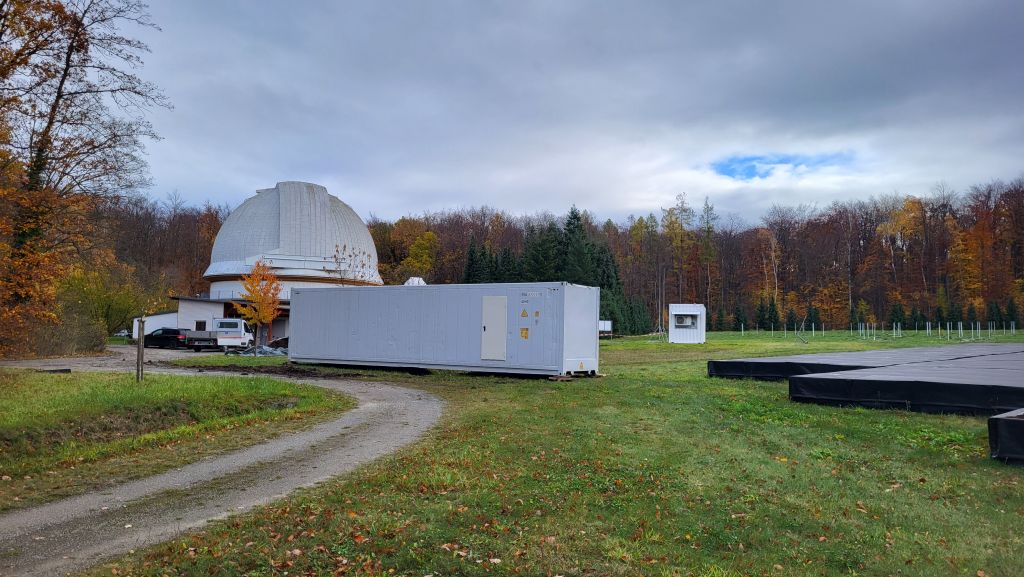 |
Images: TLS
A new optics lab at TLS
13.11.2023
Today the first optical tables were set up in the new optics laboratory at the Thuringian State Observatory.
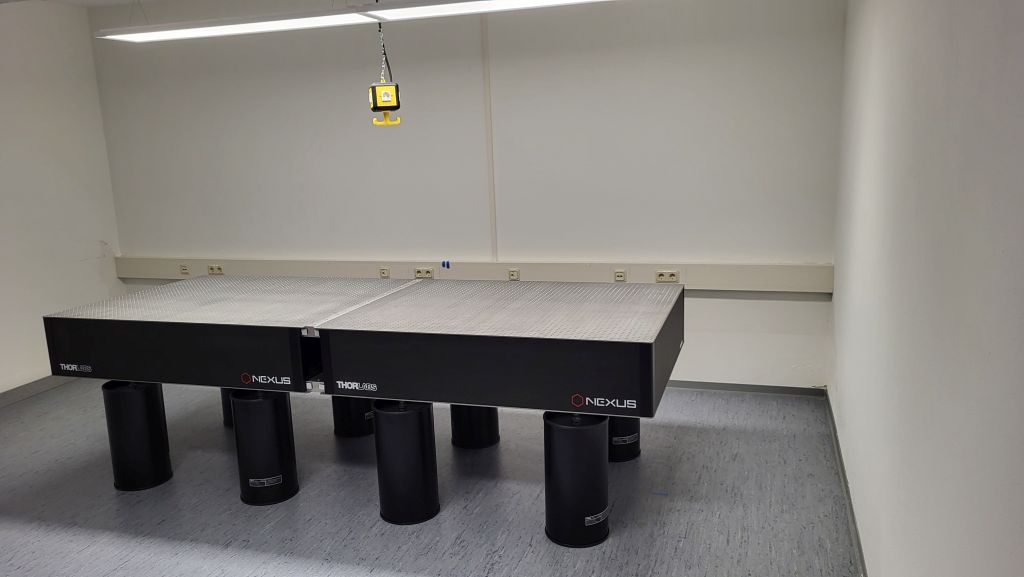
(Image: TLS)
In order to meet the growing demand for the development of new optical instruments at the TLS, a new optics laboratory is being set up. To this end, a basement room in the observatory's main building has been renovated over the past few months and equipped with new ventilation and electrical installations. Today the time had come and the first 3 m x 1.2 m optics table was set up. As it was not possible to transport such a large single table weighing around 600 kg into the cellar, it was assembled from two smaller parts weighing "only" 300 kg. But this transport also required skill, prudence and above all muscle power, which was provided by 6 employees of a Jena removal company. The first items to be measured in the new laboratory are special liquid crystal retarders for the observatory's new solar laboratory.
Image of the partial lunar eclipse
02.11.2023
On Saturday evening, October 28. 2023, a partial lunar eclipse occured, that could be observed through some clouds in Thuringia.
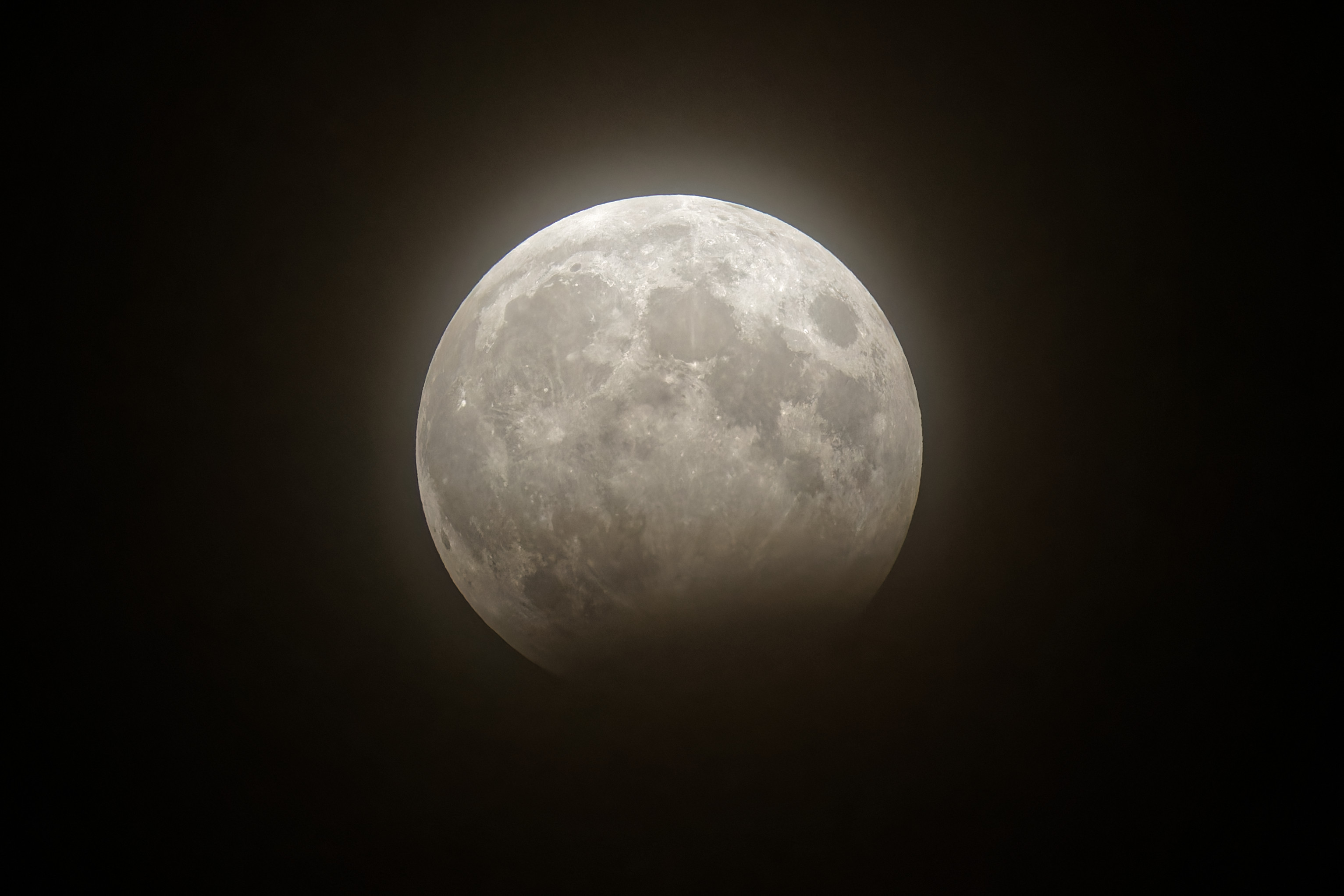
The photo taken by TLS is showing the eclipse at 22h22 CEST.
Thuringian astronomers confirm an unusual extrasolar planet
26.09.2023
Astronomers at the Thuringian State Observatory and the University of Turin have succeeded in extracting some of the secrets of an unusual extrasolar planet.
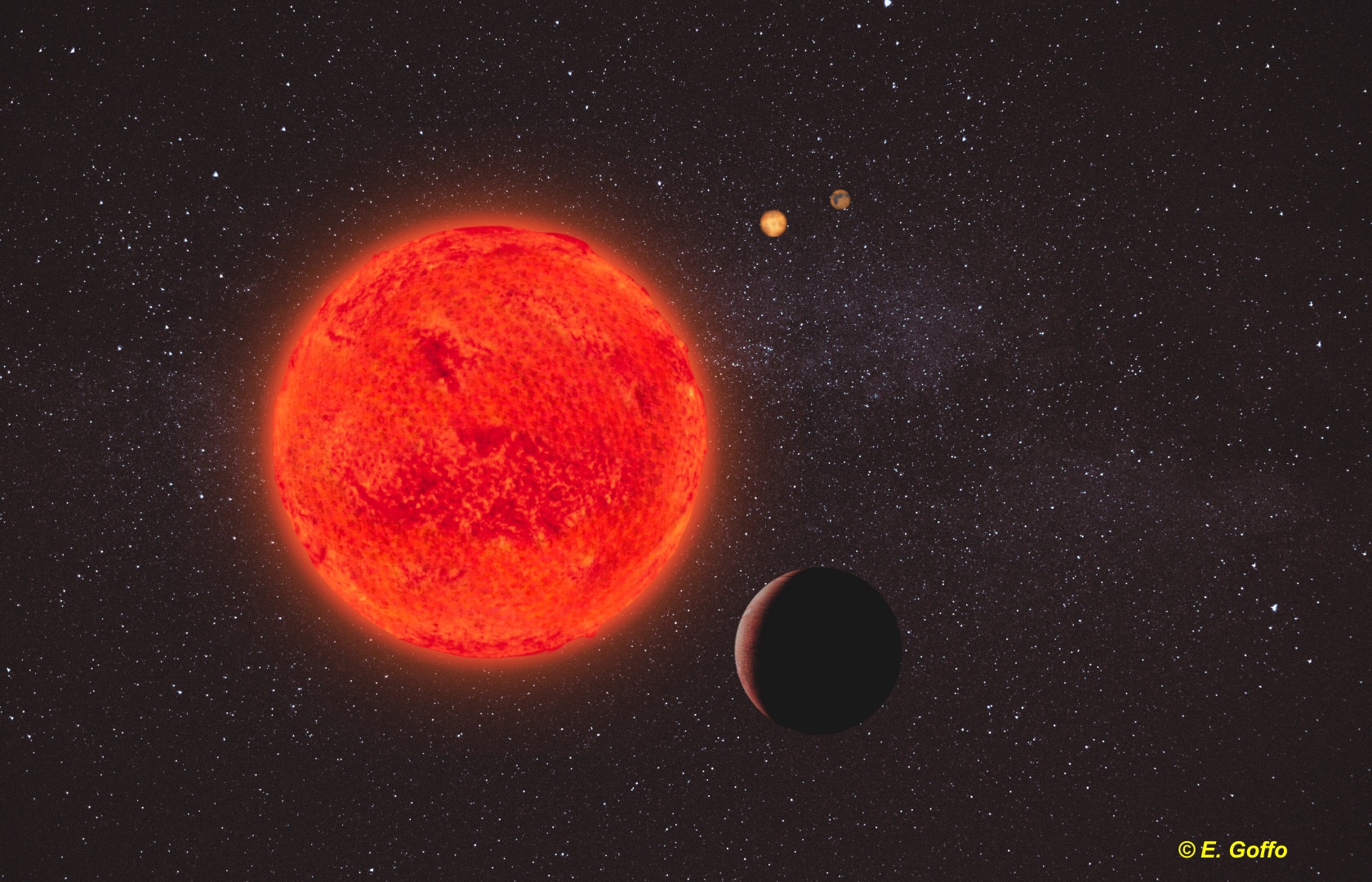
The extrasolar planet GJ 367 b is exceptional because it appears to be entirely made of iron. It orbits its central star in just 7.7 hours. Researchers were not only able to determine the planet's density but also discovered two more planets around the star during their observations. This discovery adds another piece to the puzzle of how planets form.




